5.3: China
- Page ID
- 67049
\( \newcommand{\vecs}[1]{\overset { \scriptstyle \rightharpoonup} {\mathbf{#1}} } \)
\( \newcommand{\vecd}[1]{\overset{-\!-\!\rightharpoonup}{\vphantom{a}\smash {#1}}} \)
\( \newcommand{\dsum}{\displaystyle\sum\limits} \)
\( \newcommand{\dint}{\displaystyle\int\limits} \)
\( \newcommand{\dlim}{\displaystyle\lim\limits} \)
\( \newcommand{\id}{\mathrm{id}}\) \( \newcommand{\Span}{\mathrm{span}}\)
( \newcommand{\kernel}{\mathrm{null}\,}\) \( \newcommand{\range}{\mathrm{range}\,}\)
\( \newcommand{\RealPart}{\mathrm{Re}}\) \( \newcommand{\ImaginaryPart}{\mathrm{Im}}\)
\( \newcommand{\Argument}{\mathrm{Arg}}\) \( \newcommand{\norm}[1]{\| #1 \|}\)
\( \newcommand{\inner}[2]{\langle #1, #2 \rangle}\)
\( \newcommand{\Span}{\mathrm{span}}\)
\( \newcommand{\id}{\mathrm{id}}\)
\( \newcommand{\Span}{\mathrm{span}}\)
\( \newcommand{\kernel}{\mathrm{null}\,}\)
\( \newcommand{\range}{\mathrm{range}\,}\)
\( \newcommand{\RealPart}{\mathrm{Re}}\)
\( \newcommand{\ImaginaryPart}{\mathrm{Im}}\)
\( \newcommand{\Argument}{\mathrm{Arg}}\)
\( \newcommand{\norm}[1]{\| #1 \|}\)
\( \newcommand{\inner}[2]{\langle #1, #2 \rangle}\)
\( \newcommand{\Span}{\mathrm{span}}\) \( \newcommand{\AA}{\unicode[.8,0]{x212B}}\)
\( \newcommand{\vectorA}[1]{\vec{#1}} % arrow\)
\( \newcommand{\vectorAt}[1]{\vec{\text{#1}}} % arrow\)
\( \newcommand{\vectorB}[1]{\overset { \scriptstyle \rightharpoonup} {\mathbf{#1}} } \)
\( \newcommand{\vectorC}[1]{\textbf{#1}} \)
\( \newcommand{\vectorD}[1]{\overrightarrow{#1}} \)
\( \newcommand{\vectorDt}[1]{\overrightarrow{\text{#1}}} \)
\( \newcommand{\vectE}[1]{\overset{-\!-\!\rightharpoonup}{\vphantom{a}\smash{\mathbf {#1}}}} \)
\( \newcommand{\vecs}[1]{\overset { \scriptstyle \rightharpoonup} {\mathbf{#1}} } \)
\( \newcommand{\vecd}[1]{\overset{-\!-\!\rightharpoonup}{\vphantom{a}\smash {#1}}} \)
\(\newcommand{\avec}{\mathbf a}\) \(\newcommand{\bvec}{\mathbf b}\) \(\newcommand{\cvec}{\mathbf c}\) \(\newcommand{\dvec}{\mathbf d}\) \(\newcommand{\dtil}{\widetilde{\mathbf d}}\) \(\newcommand{\evec}{\mathbf e}\) \(\newcommand{\fvec}{\mathbf f}\) \(\newcommand{\nvec}{\mathbf n}\) \(\newcommand{\pvec}{\mathbf p}\) \(\newcommand{\qvec}{\mathbf q}\) \(\newcommand{\svec}{\mathbf s}\) \(\newcommand{\tvec}{\mathbf t}\) \(\newcommand{\uvec}{\mathbf u}\) \(\newcommand{\vvec}{\mathbf v}\) \(\newcommand{\wvec}{\mathbf w}\) \(\newcommand{\xvec}{\mathbf x}\) \(\newcommand{\yvec}{\mathbf y}\) \(\newcommand{\zvec}{\mathbf z}\) \(\newcommand{\rvec}{\mathbf r}\) \(\newcommand{\mvec}{\mathbf m}\) \(\newcommand{\zerovec}{\mathbf 0}\) \(\newcommand{\onevec}{\mathbf 1}\) \(\newcommand{\real}{\mathbb R}\) \(\newcommand{\twovec}[2]{\left[\begin{array}{r}#1 \\ #2 \end{array}\right]}\) \(\newcommand{\ctwovec}[2]{\left[\begin{array}{c}#1 \\ #2 \end{array}\right]}\) \(\newcommand{\threevec}[3]{\left[\begin{array}{r}#1 \\ #2 \\ #3 \end{array}\right]}\) \(\newcommand{\cthreevec}[3]{\left[\begin{array}{c}#1 \\ #2 \\ #3 \end{array}\right]}\) \(\newcommand{\fourvec}[4]{\left[\begin{array}{r}#1 \\ #2 \\ #3 \\ #4 \end{array}\right]}\) \(\newcommand{\cfourvec}[4]{\left[\begin{array}{c}#1 \\ #2 \\ #3 \\ #4 \end{array}\right]}\) \(\newcommand{\fivevec}[5]{\left[\begin{array}{r}#1 \\ #2 \\ #3 \\ #4 \\ #5 \\ \end{array}\right]}\) \(\newcommand{\cfivevec}[5]{\left[\begin{array}{c}#1 \\ #2 \\ #3 \\ #4 \\ #5 \\ \end{array}\right]}\) \(\newcommand{\mattwo}[4]{\left[\begin{array}{rr}#1 \amp #2 \\ #3 \amp #4 \\ \end{array}\right]}\) \(\newcommand{\laspan}[1]{\text{Span}\{#1\}}\) \(\newcommand{\bcal}{\cal B}\) \(\newcommand{\ccal}{\cal C}\) \(\newcommand{\scal}{\cal S}\) \(\newcommand{\wcal}{\cal W}\) \(\newcommand{\ecal}{\cal E}\) \(\newcommand{\coords}[2]{\left\{#1\right\}_{#2}}\) \(\newcommand{\gray}[1]{\color{gray}{#1}}\) \(\newcommand{\lgray}[1]{\color{lightgray}{#1}}\) \(\newcommand{\rank}{\operatorname{rank}}\) \(\newcommand{\row}{\text{Row}}\) \(\newcommand{\col}{\text{Col}}\) \(\renewcommand{\row}{\text{Row}}\) \(\newcommand{\nul}{\text{Nul}}\) \(\newcommand{\var}{\text{Var}}\) \(\newcommand{\corr}{\text{corr}}\) \(\newcommand{\len}[1]{\left|#1\right|}\) \(\newcommand{\bbar}{\overline{\bvec}}\) \(\newcommand{\bhat}{\widehat{\bvec}}\) \(\newcommand{\bperp}{\bvec^\perp}\) \(\newcommand{\xhat}{\widehat{\xvec}}\) \(\newcommand{\vhat}{\widehat{\vvec}}\) \(\newcommand{\uhat}{\widehat{\uvec}}\) \(\newcommand{\what}{\widehat{\wvec}}\) \(\newcommand{\Sighat}{\widehat{\Sigma}}\) \(\newcommand{\lt}{<}\) \(\newcommand{\gt}{>}\) \(\newcommand{\amp}{&}\) \(\definecolor{fillinmathshade}{gray}{0.9}\)From prehistoric jade to contemporary political art — the art of China engages and challenges.
c. 3500 B.C.E. - present
A beginner's guide
Imperial China, an introduction
Imperial Chinese history is marked by the rise and fall of many dynasties and occasional periods of disunity, but overall the age was remarkably stable and marked by a sophisticated governing system that included the concept of a meritocracy. Each dynasty had its own distinct characteristics and in many eras encounters with foreign cultural and political influences through territorial expansion and waves of immigration also brought new stimulus to China. China had a highly literate society that greatly valued poetry and brush-written calligraphy, which, along with painting, were called the Three Perfections, reflecting the esteemed position of the arts in Chinese life. Imperial China produced many technological advancements that have enriched the world, including paper and porcelain.
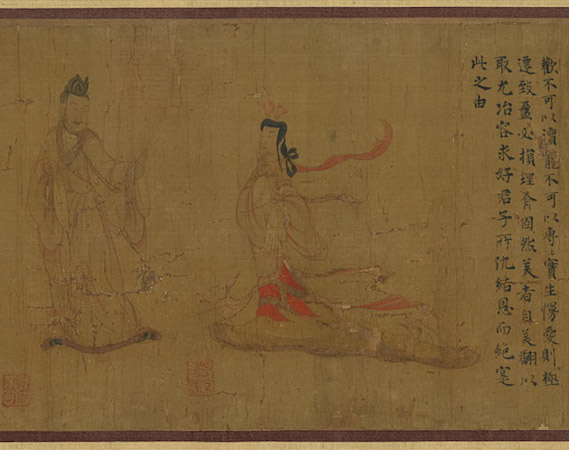
Confucianism, Daoism and Buddhism
Confucianism, Daoism and Buddhism were the dominant teachings or religions in Imperial China and most individuals combined all three in their daily lives. Each of these teachings is represented by paintings in The British Museum, most notably by The Admonitions Scroll after Gu Kaizhi (image above) and the cache of Buddhist scroll paintings from the eighth to tenth century that had been rolled up and sealed away in the eleventh century in Cave 17 at Dunhuang’s Caves of the Thousand Buddhas (discussed in this tutorial).
© Trustees of the British Museum
Chinese landscape painting
Landscape painting is traditionally at the top of the hierarchy of Chinese painting styles. It is very popular and is associated with refined scholarly taste. The Chinese term for “landscape” is made up of two characters meaning “mountains and water.” It is linked with the philosophy of Daoism, which emphasizes harmony with the natural world.
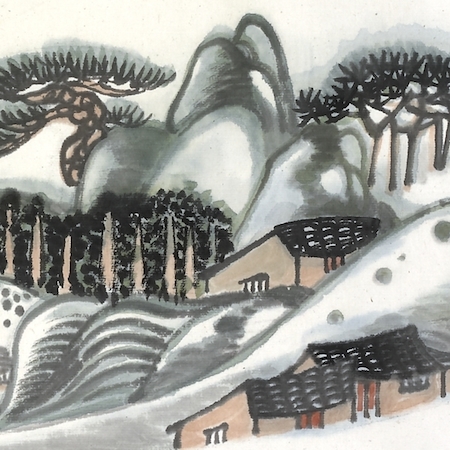
Idealized landscapes
Chinese artists do not usually paint real places but imaginary, idealized landscapes. The Chinese phrase woyou expresses this idea of “wandering while lying down.” In China, mountains are associated with religion because they reach up towards the heavens. People therefore believe that looking at paintings of mountains is good for the soul.
Chinese painting in general is seen as an extension of calligraphy and uses the same brushstrokes. The colors are restrained and subtle and the paintings are usually created in ink on paper, with a small amount of watercolor. They are not framed or glazed but mounted on silk in different formats such as hanging scrolls, handscrolls, album leaves and fan paintings.
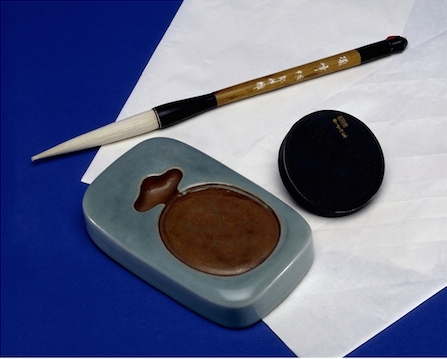
The scholar’s desk
In China, painters and calligraphers were traditionally scholars. The four basic pieces of equipment they used are called the Four Treasures of the Scholar’s Studio or wenfangsibao: paper, brush, ink and inkstone. A cake of ink is ground against the surface of the inkstone and water is gradually dropped from a water dropper, gathering in a well at one end of the stone. The brush is then dipped into the well and the depth of intensity of the ink depends on the wetness or dryness of the brush and the amount of water in the ink.
Ink cakes were made from carbonized pinewood, oil and glue, moulded into cakes or sticks and dried. The most prized inkstones were made of Duan stone from Guangdong province, although the one shown here is made of ceramic. Brushes had very pliable hairs, usually made from deer, goat, wolf or hare. Wrist rests gave essential support while painting details. Other equipment used on a scholar’s desk includes brush washers, seals, seal paste boxes, brush pots and brush stands.
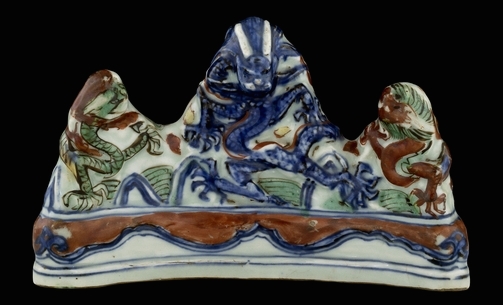
In the seventeenth century print-painting manuals began to be designed to help train artists. These showed, step by step, how to paint in the style of particular artists. They illustrated a variety of subjects, from small rocks to mountains or tree branches to forests. The different brush strokes were named and explained.
The earliest landscapes
In China, the earliest landscapes were portrayed in three-dimensional form. Examples include mountain-shaped incense burners made of bronze or ceramic, produced as early as the Han Dynasty (206 B.C.E. – 220 C.E.). The earliest paintings date from the sixth century. Before the tenth century, the main subject was usually the human figure.
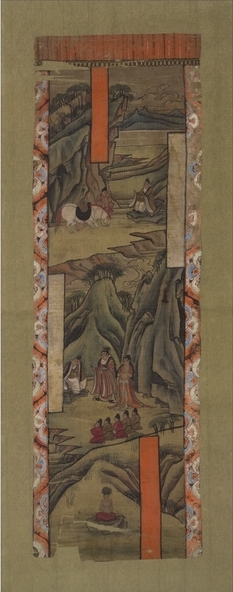
In the period following the Han dynasty, Buddhism spread across China. Artists began to illustrate stories of the life of the Buddha on earth and to create paradise paintings. In the background of some of these brightly colored Buddhist paintings, it is possible to see examples of early landscape painting.
This scene is one of a series of three representing the life of the historical Buddha, Prince Sakyamuni, when he lived on earth. The mountains are simple triangles and their ridges are painted with short brush strokes to create texture. The water in the river is portrayed in a bold, diagrammatic way, conveying a sense of movement.
Chinese paintings are usually created in ink on paper and then mounted on silk. This is done using different formats including hanging scrolls, handscrolls, album leaves and fan paintings.
© Trustees of the British Museum
Chinese porcelain: decoration
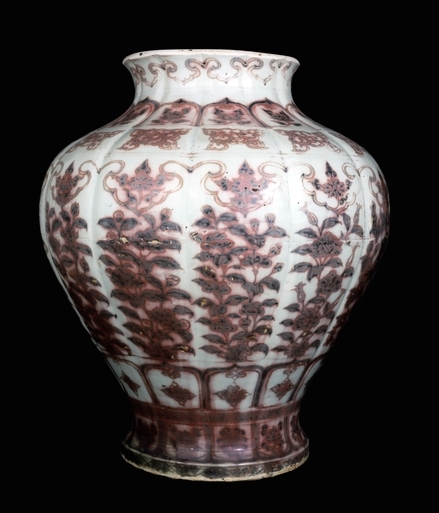
Chinese porcelain decoration: underglaze blue and red
Though Chinese potters developed underglaze red decoration during the Yuan dynasty (1279-1368 C.E.), pottery decorated in underglaze blue was produced in far greater quantities, due to the high demand from Asia and the Islamic countries of the Near and Middle East. Painting with underglaze red was more difficult than underglaze blue: the copper oxide used as the coloring agent was harder to control than the cobalt that was used for the underglaze blue. The firing left parts of the red areas grey, as on this large jar (above).
The first emperor of the Ming dynasty, which was to rule China for the next 300 years, was the general Zhu Yuanzhang (reigned 1368-98), whose title was Hongwu. He overthrew the Yuan dynasty, whose rulers had been foreigners (Mongols). He was determined to re-establish the dominance of Chinese style at court, and blue-and-white porcelain was produced in designs following Chinese rather than Islamic taste. Similar pieces were executed with underglaze red for use by the emperor.
Hongwu banned foreign trade several times, though this was never fully effective. The import of cobalt was disrupted, however, which resulted in a drop in the production of blue-and-white porcelain. For a short time at the end of the fourteenth century, more wares were decorated with underglaze red than underglaze blue.
Blue-and-white porcelain
The earliest blue-and-white ware found to date are temple vases inscribed 1351. These display a competence which indicate that the underglaze-painting technique was well-established by that time, probably originating in the second quarter of the fourteenth century. Cobalt blue was imported from Iran, probably in cake form. It was ground into a pigment, which was painted directly onto the leather-hard porcelain body. The piece was then glazed and fired. “Blue-and-white” porcelain was used in temples and occasionally in burials within China, but most of the products of the Yuan dynasty (1279-1368) appear to have been exported.
Trade remained an essential part of blue-and-white porcelain production in the Ming and Qing dynasties (1644-1911). Europe, Japan and South-east Asia were important export markets. Vessels, with numerous bands of decoration, were painted with Chinese motifs, such as dragons, waves and floral scrolls. The potters of Jingdezhen also produced wares to satisfy the demands of the Middle Eastern market. Large dishes were densely decorated with geometric patterns inspired by Islamic metalwork or architectural decoration.
Blue-and-white porcelain was particularly admired by the Imperial court, and it is interesting to trace the shapes and motifs preferred by different emperors, many of whom ordered huge quantities of porcelain from the imperial kilns at Jingdezhen.
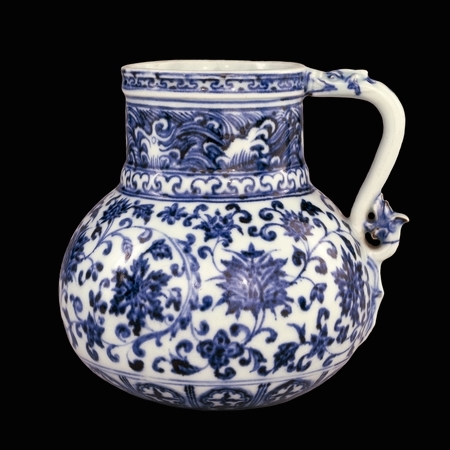
The blue-and-white wares of the fourteenth and fifteenth centuries often took their shapes from Islamic metalwork. The globular body, tall cylindrical neck and dragon handle of this jug all imitate contemporary metalwork of Timurid Persia. The crowded decoration of this jug is a feature of early blue-and-white porcelain that continued into the early part of the Ming dynasty. It is very different to the generally more subtle character of Chinese ornament. The motifs used in decorating the jug, however, are still distinctly Chinese, notably the breaking waves on the neck and floral scroll on the body.
Overglaze enamels
The term “overglaze enamels” is used to describe enamel decoration on the surface of a glaze which has already been fired. Once painted, the piece would be fired a second time, usually at a lower temperature.
The first use of overglaze enameling is found on the slip-covered wares of northern China. This was an innovation of the Jin dynasty (1115-1234), with documented pieces as early as 1201. These were utilitarian wares, not for imperial use. Under the emperors of the Ming (1368-1644) and the Qing (1644-1911) dynasty, the various techniques of overglaze enameling reached their heights at the manufacturing centre in Jingdezhen.
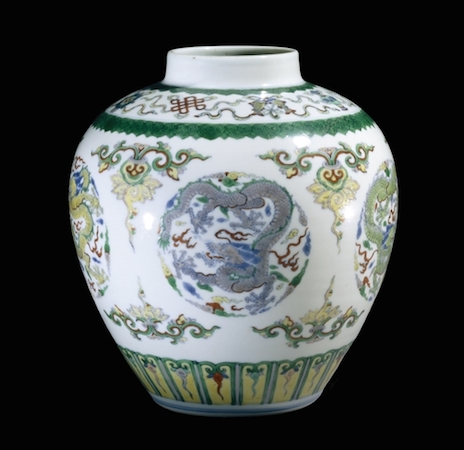
The most highly prized technique is known as doucai (“joined” or “contrasted” colors), first produced under the Ming emperor Xuande (1426-35), but more usually associated with Chenghua (1465-87). Cobalt was used under the glaze to paint the outlines and areas of blue wash needed in the design. The piece was then glazed and fired at a high temperature. Overglaze colors were painted on to fill in the design. The piece was then fired again at a lower temperature. The vase above, which dates to the reign of Emperor Yongzheng (C.E. 1723-35), is a very good example of the technical perfection in later doucai wares. The main design comprises green, yellow and mauve dragon medallions. The dragons are five-clawed, whose use was restricted to the emperor. Auspicious Buddhist emblems decorate the shoulder of the vase.
New colors (including pink!)
There were also important developments under the Qing dynasty. Famille rose (pink), jaune (yellow), noire (black) and verte (green) were overglaze enamel-decorated porcelains made from the Kangxi period (1662-1722) and later.
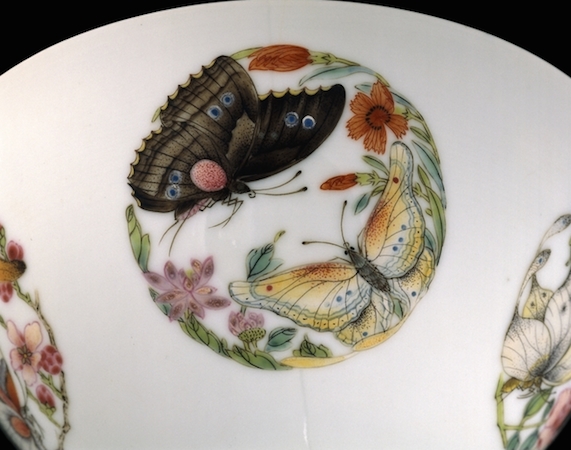
Accordingly to Chinese tradition, butterflies are an auspicious sign. They convey a wish for longevity, and were therefore often used to decorate birthday gifts or lanterns given during the Autumn Moon Festival: on the 15th day of the 8th month of the lunar calendar (usually around September). The Festival is celebrated by lighting lanterns of different shapes, sizes and colors, and by gazing at the moon. The bowl above, made at the imperial kilns at Jingdezhen, may have been presented by the emperor to a family member or worthy subject on such an occasion.
The bowl is decorated in famille rose overglaze enamels. This technique was perfected under the Yongzheng emperor (reigned 1723-35) and is considered the last major technological breakthrough at the Jingdezhen kilns. The great innovation was the production of the distinctive pink enamel from which the wares take their name. The pink color was provided by adding a very small amount of gold to red pigment. The resulting color was opaque, as were the other famille rose enamels, and so could be mixed to create a wider range of colors than had been possible before.
Suggested readings:
S.J. Vainker, Chinese pottery and porcelain: From Prehistory to the Present (London, The British Museum Press, 1991).
Regina Krahl and Jessica Harrison-Hall, Chinese Ceramics: Highlights of the Sir Percival David Collection (British Museum Press, 2009).
© Trustees of the British Museum
Chinese porcelain: production and export
Porcelain was first produced in China around 600 C.E. The skillful transformation of ordinary clay into beautiful objects has captivated the imagination of people throughout history and across the globe. Chinese ceramics, by far the most advanced in the world, were made for the imperial court, the domestic market, or for export.
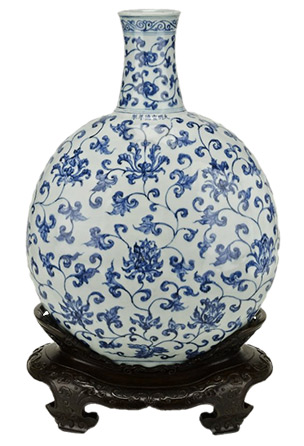
What is porcelain?
The Chinese use the word ci to mean either porcelain or stoneware, not distinguishing between the two. In the West, porcelain usually refers to high-fired (about 1300º) white ceramics, whose bodies are translucent and make a ringing sound when struck. Stoneware is a tougher, non-translucent material, fired to a lower temperature (1100-1250º).
A number of white ceramics were made in China, several of which might be termed porcelain. The northern porcelains, such as Ding ware, were made predominantly of clay rich in kaolin. In southern China, porcelain stone was the main material. At the imperial kilns at Jingdezhen, Jiangxi province, kaolin was added to porcelain stone; in Fujian province, on the coast and east of Jiangxi, porcelain stone was used alone. The results differed in that northern porcelains were more dense and compact, while southern porcelains were more glassy and “sugary.”
Ceramics may be fired in oxidizing or reducing conditions (increasing or restricting the amount of oxygen during the process). Northern porcelains were usually fired in oxidation, which results in warm, ivory-colored glazes. Southern wares were fired in reduction, producing a cool, bluish tinge. An exception to this was blanc de Chine, or Dehua ware, from Fujian province, whose warm ivory hue came from oxidizing firings.
The export market
Chinese ceramics were first exported in large quantities during the Song dynasty (960-1279). The government supported this as an important source of revenue. Early in the period, ports were established in Guangzhou (Canton), Quanzhou, Hangzhou and Ningbo to facilitate commercial activity.
The ceramics trade established in the Song dynasty was maintained throughout the succeeding Yuan dynasty (1279-1368) and with a few interruptions, the Ming (1368-1644) and Qing (1644-1911) dynasties as well. The markets were concentrated in different regions at different times, but the global influence of China’s porcelains has been sustained throughout. Within Asia, up until the fourteenth century, the potters of Korea imitated China’s porcelain with considerable success, and Japan’s potters did so for a still longer period. In the Middle East, the twelfth-century attempts to reproduce Chinese wares went on throughout the Ming period. In Europe however, porcelain was barely known before the seventeenth century. The English and Germans produced mass quantities of a similar hard-bodied ware in the eighteenth century.
Chinese porcelain influenced the ceramics of importing countries, and was in turn, influenced by them. For example, importers commissioned certain shapes and designs, and many more were developed specifically for foreign markets; these often found their way in to the repertory of Chinese domestic items. In this way, Chinese ceramics were a vehicle for the worldwide exchange of ornamental styles.
© Trustees of the British Museum
Neolithic China
Jade has always been the material most highly prized in China, above silver and gold. From ancient times, this translucent stone has been worked into ornaments, ceremonial weapons and ritual objects.
c. 3500 - 1600 B.C.E.
Chinese jade: an introduction
What is jade?
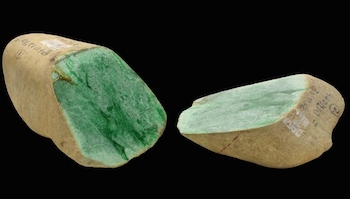
The English term “jade” is used to translate the Chinese word yu, which in fact refers to a number of minerals including nephrite, jadeite, serpentine and bowenite, while jade refers only to nephrite and jadeite.
Chemically, nephrite is a calcium magnesium silicate and is white in color. However, the presence of copper, chromium and iron produces colors ranging from subtle grey-greens to brilliant yellows and reds. Jadeite, which was very rarely used in China before the eighteenth century, is a silicate of sodium and magnesium and comes in a wider variety of colors than nephrite.
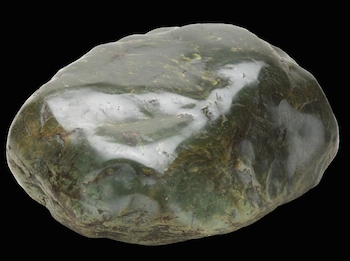
Nephrite is found in metamorphic rocks in mountains. As the rocks weather, the boulders of nephrite break off and are washed down to the foot of the mountain, from where they are retrieved. From the Han period (206 B.C.E. – 220 C.E.) jade was obtained from the oasis region of Khotan on the Silk Route. The oasis lies about 5000 miles from the areas where jade was first worked in the Hongshan (in Inner Mongolia) and the Liangzhu cultures (near Shanghai) about 3000 years before. It is likely that sources much nearer to those centers were known about in early periods and were subsequently exhausted.
Worn by kings and nobles in life and death
“Soft, smooth and glossy, it appeared to them like benevolence; fine, compact and strong – like intelligence” —attributed to Confucius (about 551-479 B.C.E.)
Jade has always been the material most highly prized by the Chinese, above silver and gold. From ancient times, this extremely tough translucent stone has been worked into ornaments, ceremonial weapons and ritual objects. Recent archaeological finds in many parts of China have revealed not only the antiquity of the skill of jade carving, but also the extraordinary levels of development it achieved at a very early date.
Jade was worn by kings and nobles and after death placed with them in the tomb. As a result, the material became associated with royalty and high status. It also came to be regarded as powerful in death, protecting the body from decay. In later times these magical properties were perhaps less explicitly recognized, jade being valued more for its use in exquisite ornaments and vessels, and for its links with antiquity. In the Ming and Qing periods ancient jade shapes and decorative patterns were often copied, thereby bringing the associations of the distant past to the Chinese peoples of later times.
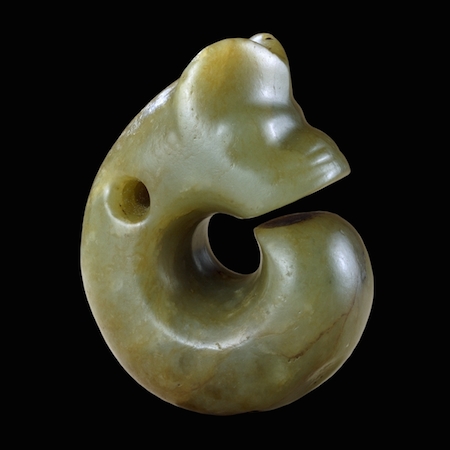
The subtle variety of colors and textures of this exotic stone can be seen, as well as the many different types of carving, ranging from long, smooth Neolithic blades to later plaques, ornaments, dragons, animal and human sculpture.
Neolithic jade: Hongshan culture
It was long believed that Chinese civilization began in the Yellow River valley, but we now know that there were many earlier cultures both to the north and south of this area. From about 3800–2700 B.C.E. a group of Neolithic peoples known now as the Hongshan culture lived in the far north-east, in what is today Liaoning province and Inner Mongolia. The Hongshan were a sophisticated society that built impressive ceremonial sites. Jade was obviously highly valued by the Hongshan; artifacts made of jade were sometimes the only items placed in tombs along with the body of the deceased.
Major types of jade of this period include discs with holes and hoof-shaped objects that may have been ornaments worn in the hair. This coiled dragon is an example of another important shape, today known as a “pig-dragon,” which may have been derived from the slit ring, or jue. Many jade artifacts that survive from this period were used as pendants and some seem to have been attached to clothing or to the body.
© Trustees of the British Museum
Jade Cong
Video \(\PageIndex{1}\): Jade Cong, c. 2500 B.C.E., Liangzhu culture, Neolithic period, China (The British Museum). Speakers: Dr. Steven Zucker and Dr. Beth Harris
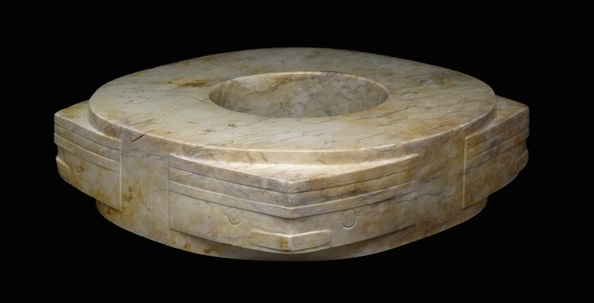
Ancient China includes the Neolithic period (10,000 -2,000 B.C.E.), the Shang dynasty (c. 1500-1050 B.C.E.) and the Zhou dynasty (1050-221 B.C.E.). Each age was distinct, but common to each period were grand burials for the elite from which a wealth of objects have been excavated.
The Neolithic Period, defined as the age before the use of metal, witnessed a transition from a nomadic existence to one of settled farming. People made different pottery and stone tools in their regional communities. Stone workers employed jade to make prestigious, beautifully polished versions of utilitarian stone tools, such as axes, and also to make implements with possible ceremonial or protective functions. The status of jade continues throughout Chinese history. Pottery also reached a high level with the introduction of the potter’s wheel.
Neolithic Liangzhu culture
A group of Neolithic peoples grouped today as the Liangzhu culture lived in the Jiangsu province of China during the third millennium B.C.E. Their jades, ceramics and stone tools were highly sophisticated.
Cong
They used two distinct types of ritual jade objects: a disc, later known as a bi, and a tube, later known as a cong. The main types of cong have a square outer section around a circular inner part, and a circular hole, though jades of a bracelet shape also display some of the characteristics of cong. They clearly had great significance, but despite the many theories the meaning and purpose of bi and cong remain a mystery. They were buried in large numbers: one tomb alone had 25 bi and 33 cong. Spectacular examples have been found at all the major archaeological sites.
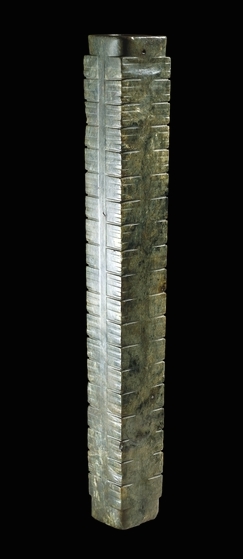
The principal decoration on cong of the Liangzhu period was the face pattern, which may refer to spirits or deities. On the square-sectioned pieces, like the examples here, the face pattern is placed across the corners, whereas on the bracelet form it appears in square panels. These faces are derived from a combination of a man-like figure and a mysterious beast.
Cong are among the most impressive yet most enigmatic of all ancient Chinese jade artifacts. Their function and meaning are completely unknown. Although they were made at many stages of the Neolithic and early historic period, the origin of the cong in the Neolithic cultures of south-east China has only been recognized in the last thirty years.
Cong were extremely difficult and time-consuming to produce. As jade cannot be split like other stones, it must be worked with a hard abrasive sand. This one is exceptionally long and may have been particularly important in its time.
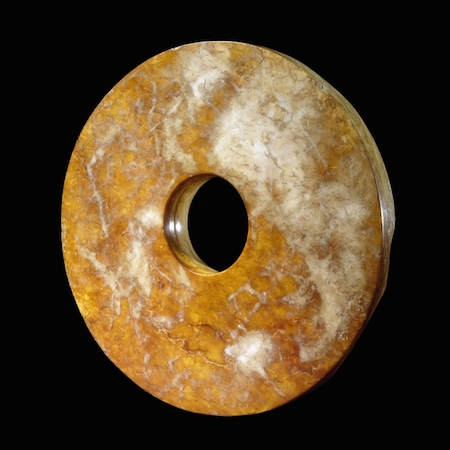
Bi
Stone rings were being made by the peoples of eastern China as early as the fifth millennium B.C.E. Jade discs have been found carefully laid on the bodies of the dead in tombs of the Hongshan culture (about 3800-2700 B.C.E.), a practice which was continued by later Neolithic cultures. Large and heavy jade discs such as this example, appear to have been an innovation of the Liangzhu culture (about 3000-2000 B.C.E.), although they are not found in all major Liangzhu tombs. The term bi is applied to wide discs with proportionately small central holes.
The most finely carved discs or bi of the best stone (like the example above) were placed in prominent positions, often near the stomach and the chest of the deceased. Other bi were aligned with the body. Where large numbers of discs are found, usually in small piles, they tend to be rather coarse, made of stone of inferior quality that has been worked in a cursory way.
We do not know what the true significance of these discs was, but they must have had an important ritual function as part of the burial. This is an exceptionally fine example, because the two faces are very highly polished.
Suggested readings:
J. Rawson, Chinese Jade from the Neolithic to the Qing (London, The British Museum Press, 1995, reprinted 2002).
J. Rawson (ed.), The British Museum book of Chinese Art (London, The British Museum Press, 1992).
© Trustees of the British Museum
Smarthistory images for teaching and learning:

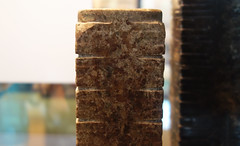


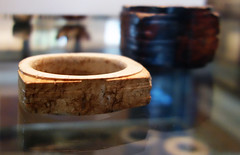
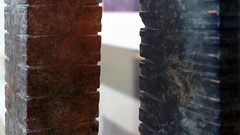
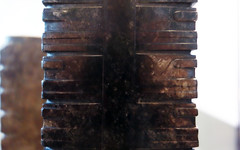
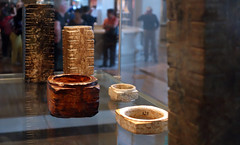
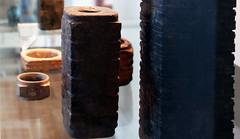
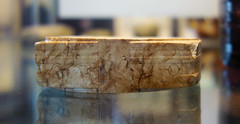

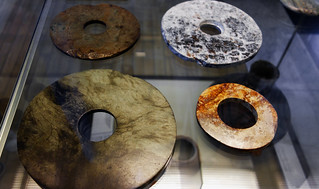
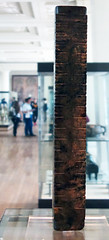

Working jade
Video \(\PageIndex{2}\): Video from the Asian Art Museum, San Francisco. This video explores the significance and working of jade in China.
Shang dynasty (c.1600-1046 B.C.E.)
Oracle Bone, Shang Dynasty
by DR. KRISTEN CHIEM and DR. BETH HARRIS
Speakers: Dr. Kristen Chiem and Dr. Beth Harris
Cite this page as: Dr. Kristen Chiem and Dr. Beth Harris, "Oracle Bone, Shang Dynasty," in Smarthistory, October 8, 2016, accessed September 2, 2020, https://smarthistory.org/oracle-bone/.
Western Zhou dynasty (1046–771 B.C.E.)
Da Ke Ding
by DR. KRISTEN CHIEM and DR. BETH HARRIS
Video \(\PageIndex{4}\): Da Ke Ding, c. 1046 – 771 B.C.E. (late Western Zhou dynasty, China), bronze, 93.1 cm high (Shanghai Museum)
Speakers: Dr. Kristen Chiem and Dr. Beth Harris
Smarthistory images for teaching and learning:
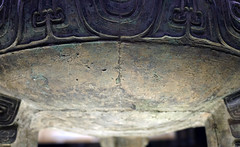
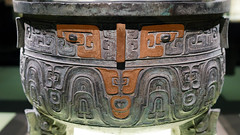
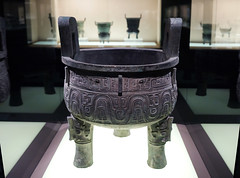
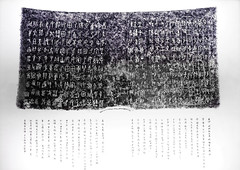
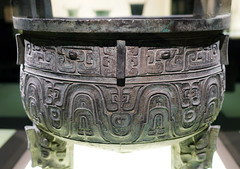

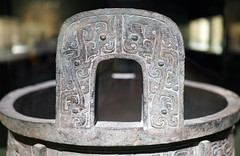

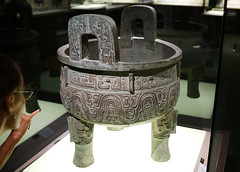
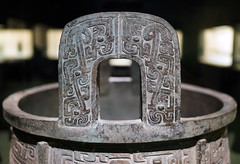

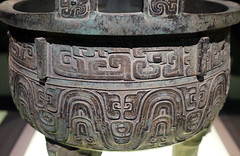
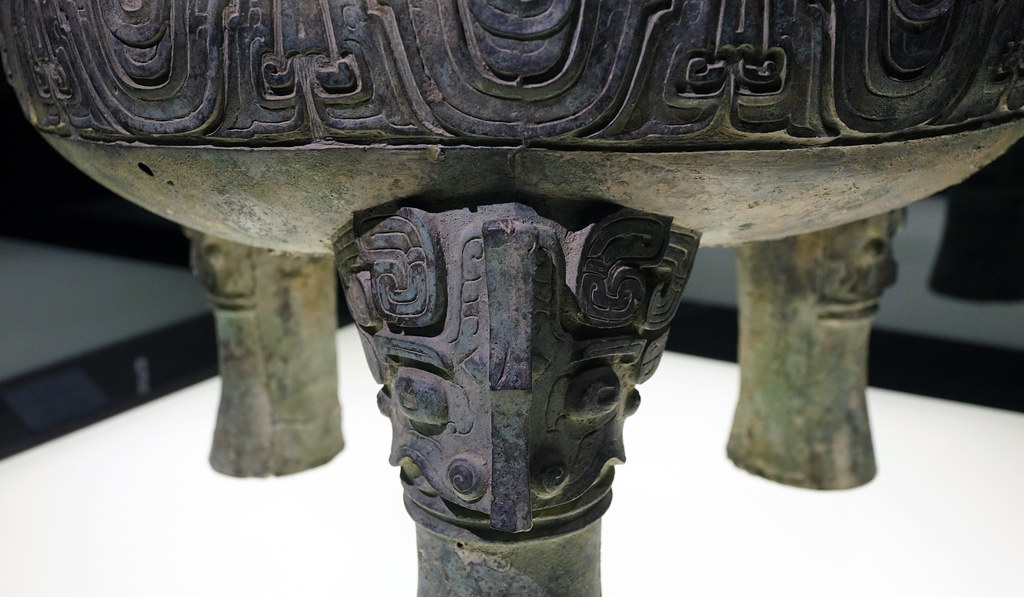
Eastern Zhou dynasty (770–256 B.C.E.)
Ambition and luxury: Marquis Yi of the Zeng State
by DR. KENT CAO

Imagine stumbling upon an undisturbed tomb filled with 15,000 items—from hundreds of jade and golden objects and enormous bronze wine vessels to massive lacquered coffins and a vast assortment of musical instruments. In 1978 in Leigudun, Suizhou, Hubei province, local military construction accidentally discovered such a luxurious tomb, one that was meant to impress. With all its contents still intact, this tomb (dating to the 5th century B.C.E during the Bronze Age) offers us a glimpse into how early burial customs and practices could not only reflect someone’s ambition, but also elevate their status.
The Bronze Age in China spans from the seventeenth century B.C.E. to the third century B.C.E.
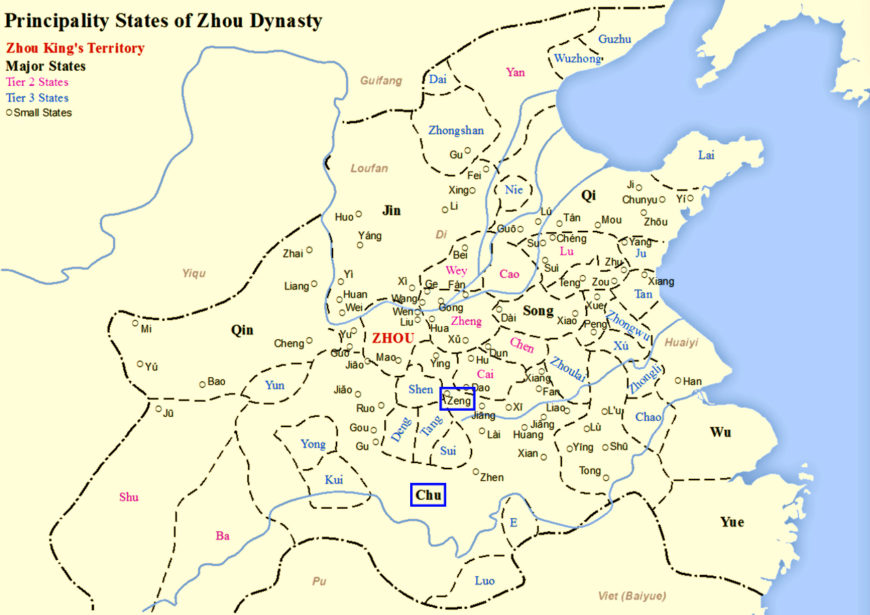
Extensive bronze inscriptions suggest that the tomb owner was the Marquis Yi, who passed away in 433 B.C.E. or slightly later. He was of the Zeng state, a small southern state little known in the traditional historical record. Marquis Yi was active in the early Warring States period (481–221 B.C.E.), which witnessed the dissolution of the kin-shaped political system. Lords paid increasingly less respect to the nominal Zhou king, and they engaged in warfare against each other and competed for higher status and prestige.
The Warring States period is the second half of the Eastern Zhou period (770–256 B.C.E.).
The kings of the Zhou court were not able to effectively control the vast territory under their name. Therefore, the Zhou kings delegated land and populations to their sons, cousins, marital relatives and sometimes non-kin allies to establish vassal states. These states enjoyed political, taxational, and judicial autonomy while remaining politically and ritually subordinate to the king and assuming military and tributary obligations to the central court.
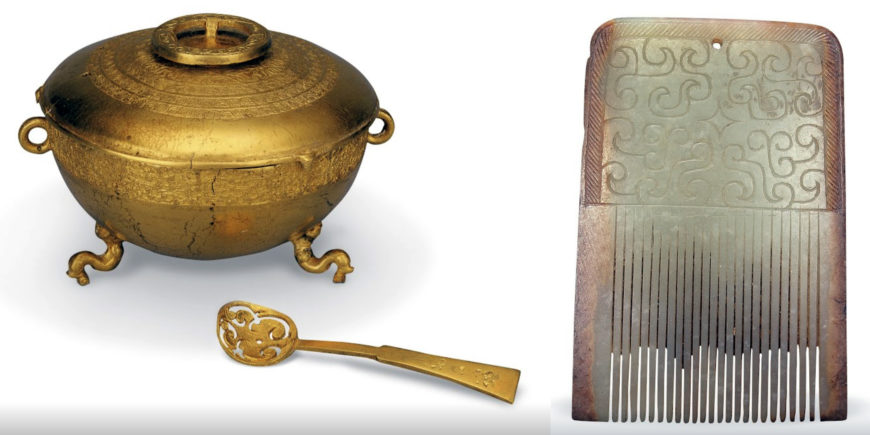
Despite the turbulence of this era, the luxurious furnishings from Marquis’s tomb with its overt display of wealth and power clearly reflect his ambition. The number of bronzes from his tomb is unmatched by any other burials in pre-imperial China. He was also buried with a number of ritual bronze vessels normally reserved for the Zhou kings, further implying the marquis’s interest in attaining a more prominent status. Because most of the princely burials in the Warring States period have been looted, the integrity and wealth of Marquis Yi’s tomb offers a rare opportunity to examine the elite culture and funerary customs in the late first millennium B.C.E.
Pre-imperial China is a historical concept that predates the establishment of the Qin Empire (221–207 B.C.E.). The Qin Empire was the first empire in the history of China. One of the most prominent transformations that brought forth by the Qin was the replacement of the kinship-based government with a centralized bureaucratic system.
Tomb Structure
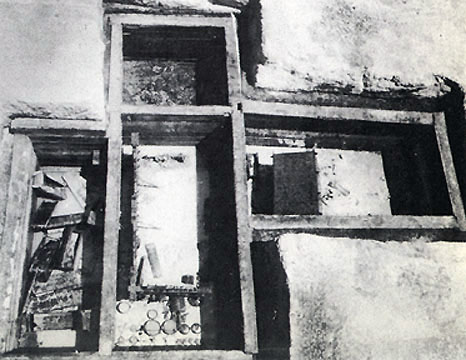
The tomb of Marquis Yi was originally more than 40 feet below surface level, with layers of charcoal, viscous, and dry soil piled on to it to protect it. It is one of the earliest examples in ancient China that demonstrates the desire to replicate aboveground living quarters in funerary practice. This practice was an attempt to sustain a person’s secular privileges and pleasures in the afterlife. Inside, the tomb is divided into four compartments, each with a different designated function and associated objects. Here is a basic list of what was found:
Central chamber: extensive bronze ritual vessels and musical instruments for grand ancestral offering ceremonies and court banquets
North chamber: Chariot fittings and weapons such as bows, ge-halberds, shields, and armor
Ge-halberds are blades horizontally mounted onto the top of spears. They were the primary weapons used by foot soldiers.
East chamber: Marquis Yi’s main coffins surrounded by eight smaller coffins found with female human sacrifice victims and a coffin for a dog
West chamber: additional thirteen female human sacrifice victims.
The female victims in the tomb were approximately twenty years old, and were likely Marquis’s maids, musicians, and dancers. All these furnishings and the human entourage ensured that Marquis Yi would continue his sumptuous elite life after his death.
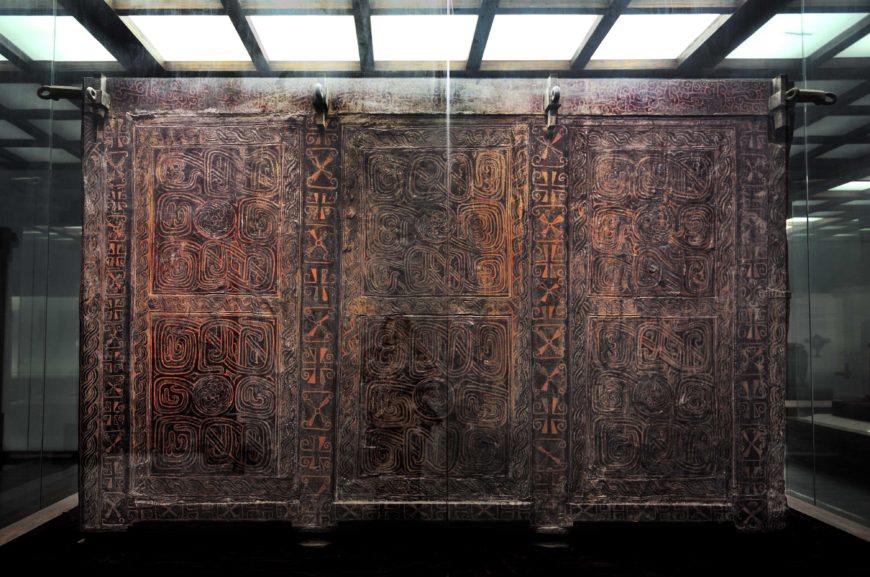
Double coffins
Outer coffin
Marquis Yi rested in enormous double coffins, which are impressive for their sheer size, intricate patterns, and bright lacquer. The outer coffin is an enormous rectangular box. This exceptionally large wooden box even has a bronze framework to stabilize it. It has a black lacquer background, and is decorated with yellow and red intertwined serpents surrounding a central swirl. Abstract cloud motifs fill the border between the main units.
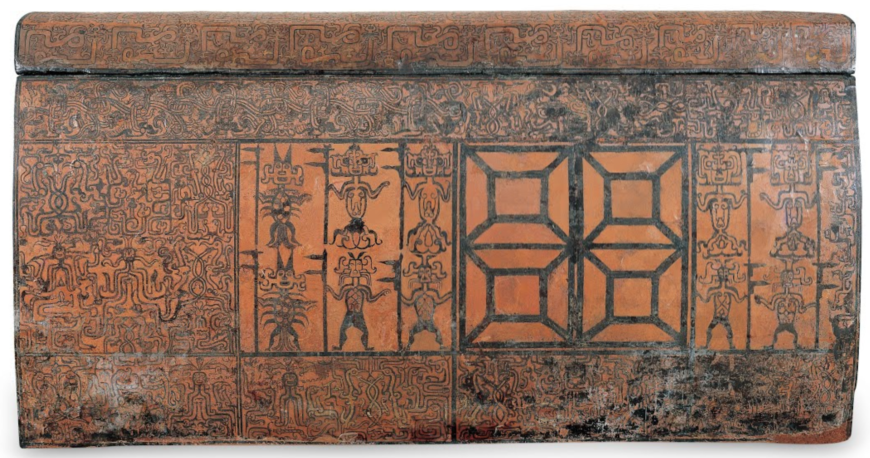
Inner coffin
The inner coffin is considerably smaller in size, allowing its makers to construct it solely from wooden panels. Entangled serpents, birds, fish, and other composite animals decorate the surface. Spiritual beings in semi-animal form with weapons in hand also stand guard.

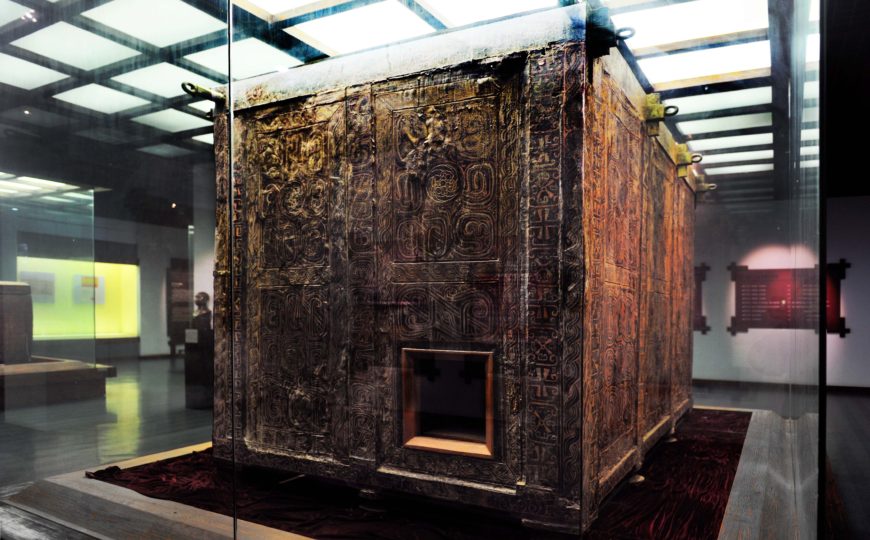
Both coffins
A series of designs on both coffins facilitated the spirit of Marquis Yi to travel freely and continue to enjoy his unparalleled luxury in the afterlife. The Zeng craftsmen painted windows on the inner coffin. They also carved out a square hole on the lower right corner on the north end of the outer coffin. Similar square openings on the bottom of the tomb’s wooden walls further enable access to all the chambers. Marquis Yi could ride his chariot in the north chamber for an outing and hold a sumptuous royal banquet in his central chamber.
Lacquer production was costly and time consuming. Craftsmen extracted lacquer from the toxic sap of the lacquer tree that is indigenous to China. The hazardous production process and the time-consuming application of multiple layers of lacquer on an item’s surface led to the high price of lacquerware. Lacquer’s lightness, vibrant colors, and glossy surface made it as prestigious as ritual bronze vessels. Besides the coffins, the tomb also had an extensive collection of other lacquerwares—letting anyone know once again of Marquis Yi’s status.
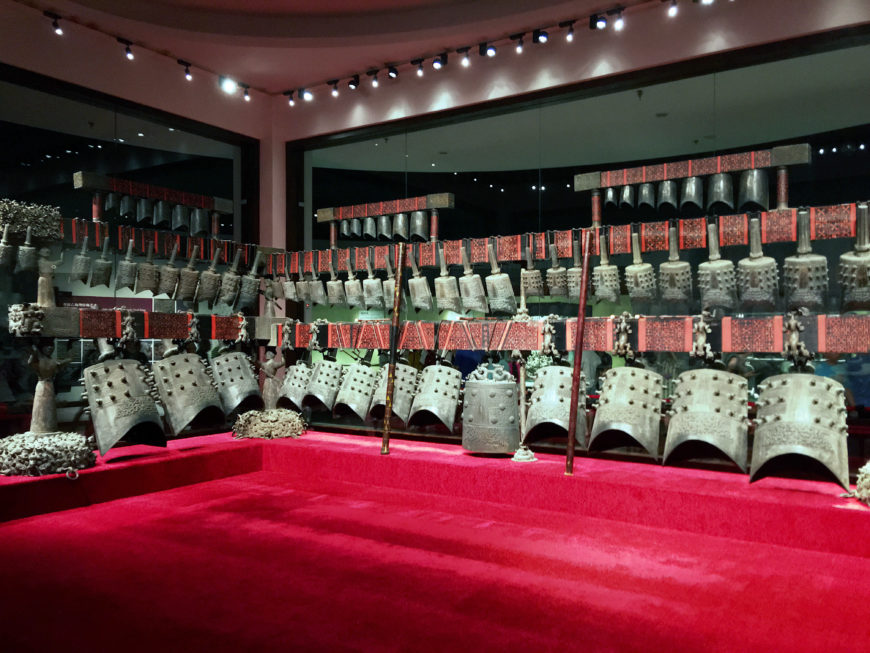
Chime Bell Set
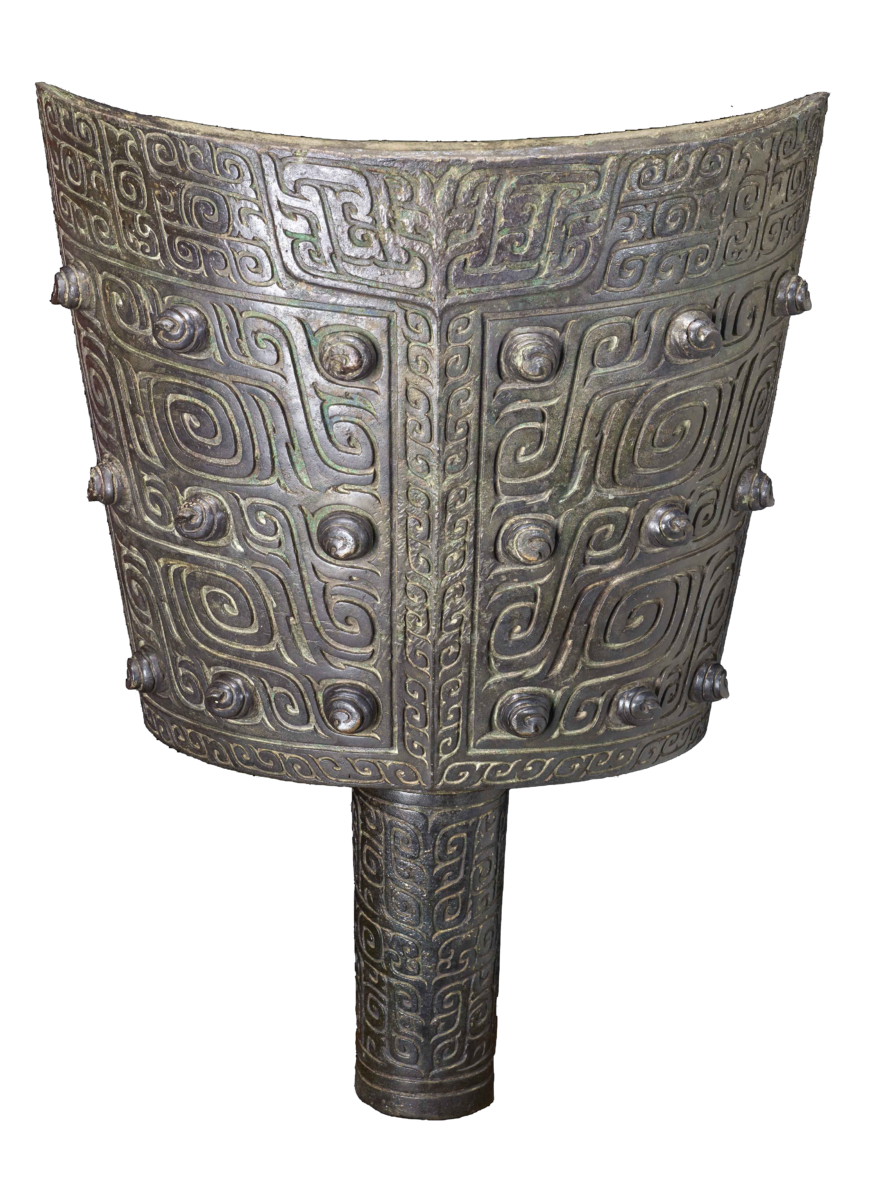
The grand chime bell set is the largest item in the central chamber. In China, bronze musical bells trace their origin to the late second millennium B.C.E. clapperless nao-bells in the Yangtze River region in the south.
Nao-bells are a bronze bell tradition indigenous to the middle to lower Yangtze River region. Usually geometric in surface decoration and found in the hilltop or river bank, nao-bells are considerably more voluminous than their northern counterparts. The larger ones can be over 1-meter tall and weigh over 100 kg.
Western Zhou elites began to institutionalize chime bells in the 9th century B.C.E. Bells began to be organized to cover an octave, and musical theory gradually developed. This systematic change added an acoustic dimension to the visual and gustatory experiences in the ritual performance of ancestral offerings.
Food offerings for their deceased ancestors was a serious matter to the elites in Bronze Age China. The living sustained the deceased and the deceased, in return, blessed the living.

Marquis Yi’s bell set is the most extensive and best preserved known-to-date. Divided into eight groups, 65 bells occupy three tiers on L-shaped shelves. The wooden shelves, adorned by elaborate lacquer decoration and bronze components, are supported by six bronze statues of armed warriors. Unlike in Egypt and Mesopotamia in the third and second millennium B.C.E. where the appearance of the rulers was a major artistic theme, patrons and artists in early China almost purposefully eschewed direct human representations.
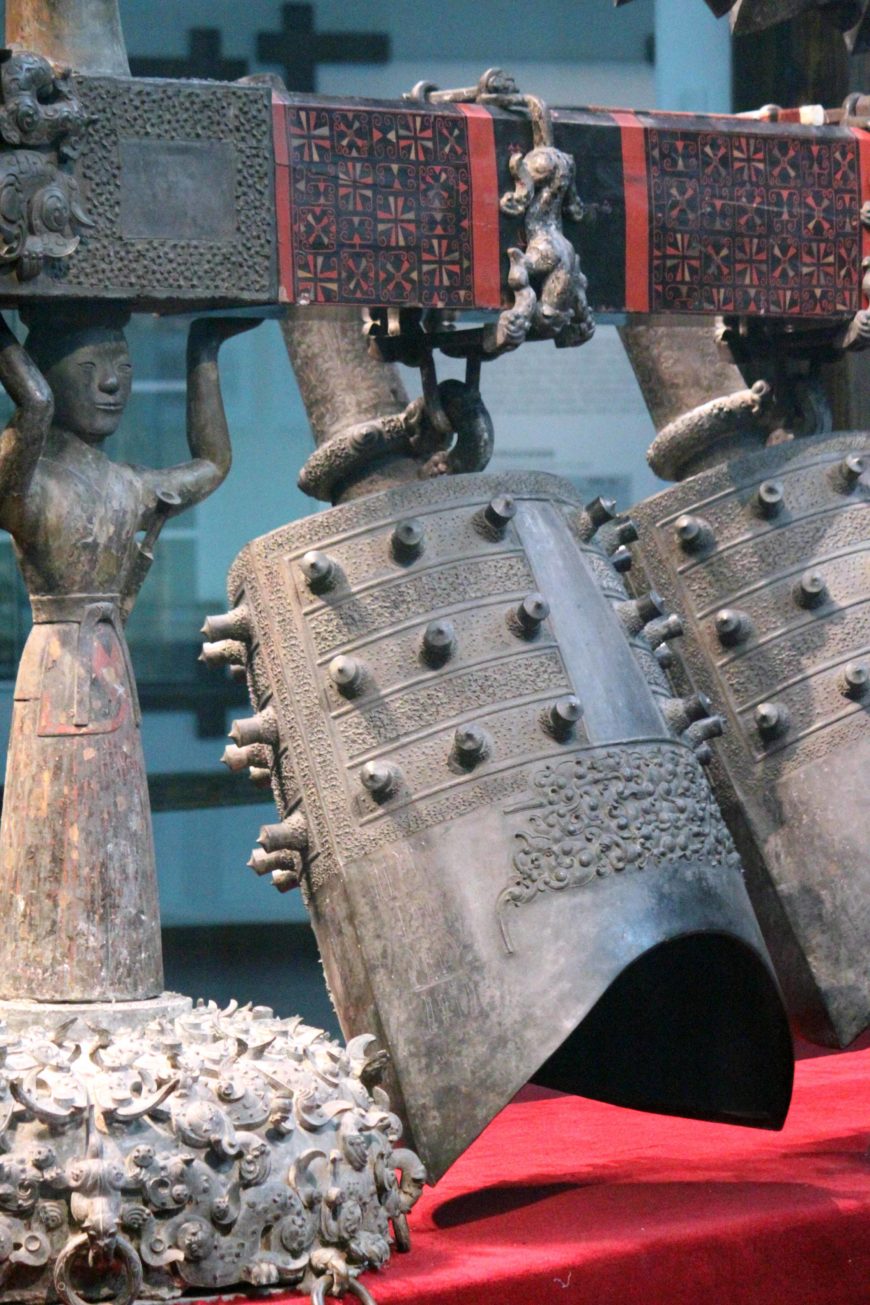
The bronze warriors in Marquis Yi’s bell set are a rare case of the representation of the human form in early Chinese art, indicative of the late first millennium trend toward increasing secularization. Scholars have proposed that the reason for this was that writing was ritually and politically more powerful than images in early China. We always see the name of the owner and that of the honored person cast on precious bronze vessels, but we almost never see the face of the patron in bronze art.
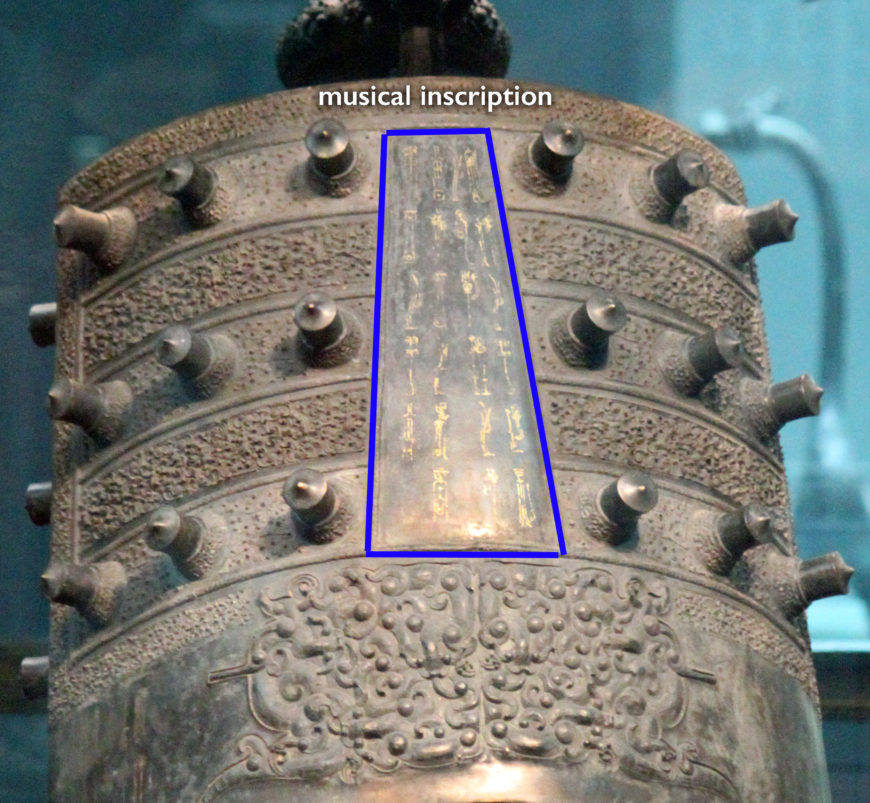
The bells range considerably in weight and height. Interlaced serpents in a dense pattern and granular texture rise up in low relief from the bell surface. Musical inscriptions in gold script are on the center, bottom, and side of the bells. A total of 3,755 characters explain in detail the pitches and scales that the chime bells are designed to play. Each bell is tuned to produce two clear pitches by striking the center and side. The entire set is capable of playing a five-note scale across five octaves. Tuning bronze bells is a highly technical, challenging task. Experienced Zeng state founders skillfully cast the bells with approximately correct pitches.
Our knowledge about the operation of a foundry at this time is limited. Bronze casting was likely a highly exclusive practice monopolized by the state, which also controlled labor, expertise, and raw materials.
Video \(\PageIndex{5}\): Listen to what the bells would have sounded like with modern-day reconstructions (video by Behring Global Educational Foundation)
A grand chime bell set would have been the center of court musical performances. Additional musical instruments, such as a 32-piece stone chime set, wooden zithers, drums, flutes, panpipes, and mouth organs, completed the ensemble. The bell set alone required a crew of five players. More than 20 musicians were needed to perform in the orchestra. The enormous labor and material investment in the court banquet certainly impressed most guests of Marquis Yi. What is more profound is the exceptional sophistication and grandeur of the musical system. Marquis Yi conveyed a strong message: Not only was he the head of an affluent state, he was also a highly cultured gentleman.
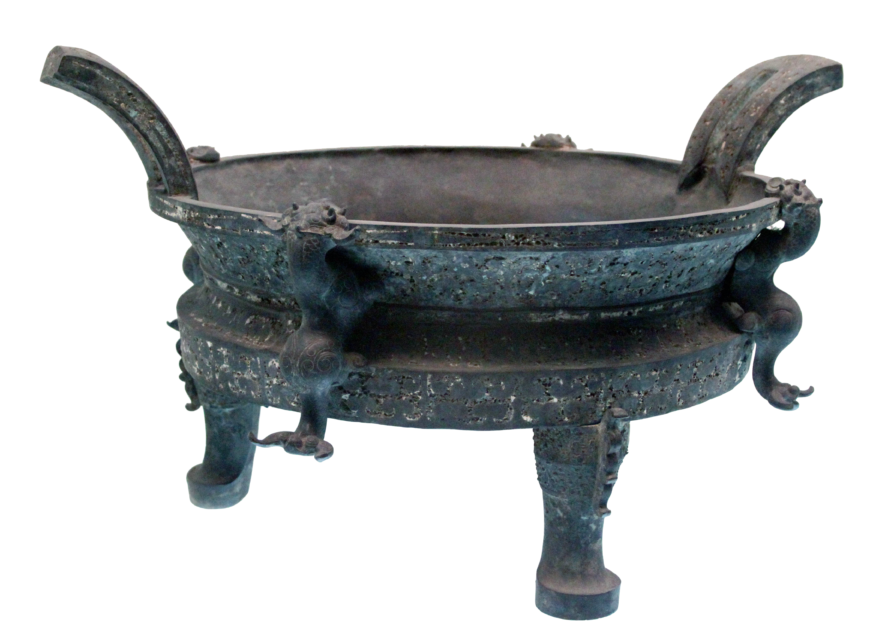
Ritual Bronze Vessels
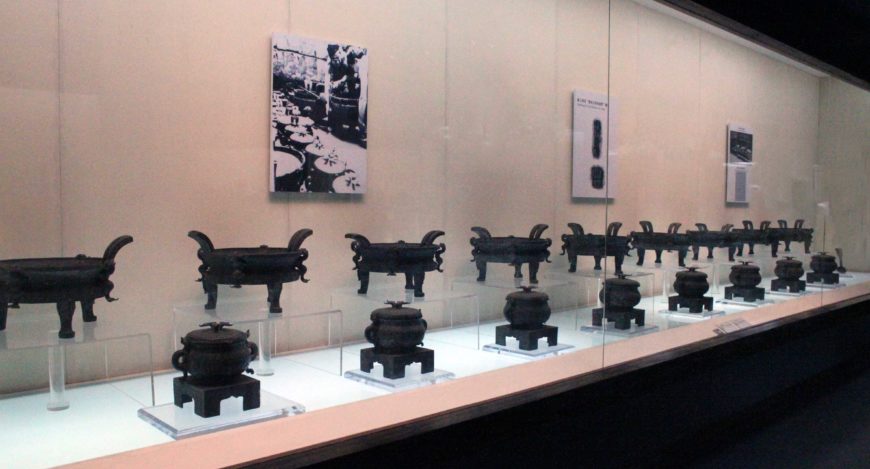
Meticulously lined up in the southern end of the tomb’s central chamber are many bronze vessels, which are breathtaking for their sheer scale, volume, and technical virtuosity. Ritual bronze vessels like these were used in ancestral offering ceremonies in Bronze Age China. The correct performance would please the ancestors, and strengthen elite status and power in return. Food offerings were the primary form of ancestral offerings in Bronze Age China. Often human sacrifice, especially that of war captives, was a key component in the offering ceremony. The the vessels for offerings? in the tomb of the Marquis Yi are considered one of the most impressive examples.
Beginning in the middle to late Western Zhou period (c. 9th century B.C.E.), a loose ranking system emerged to regulate the ritual bronze use in accordance with someone’s prescribed elite status. The more bronze vessels you had, the higher your status. The king of the Zhou court (at the top of the social hierarchy) supposedly used 9 ding-cauldrons and 8 gui-basins, and his subordinate lords and princes were entitled to fewer vessels. The ding food-cauldron (which typically containing sacrificed animals) and the gui grain-basin were the centerpieces of the ritual paraphernalia for ancestral offering in Bronze Age China.
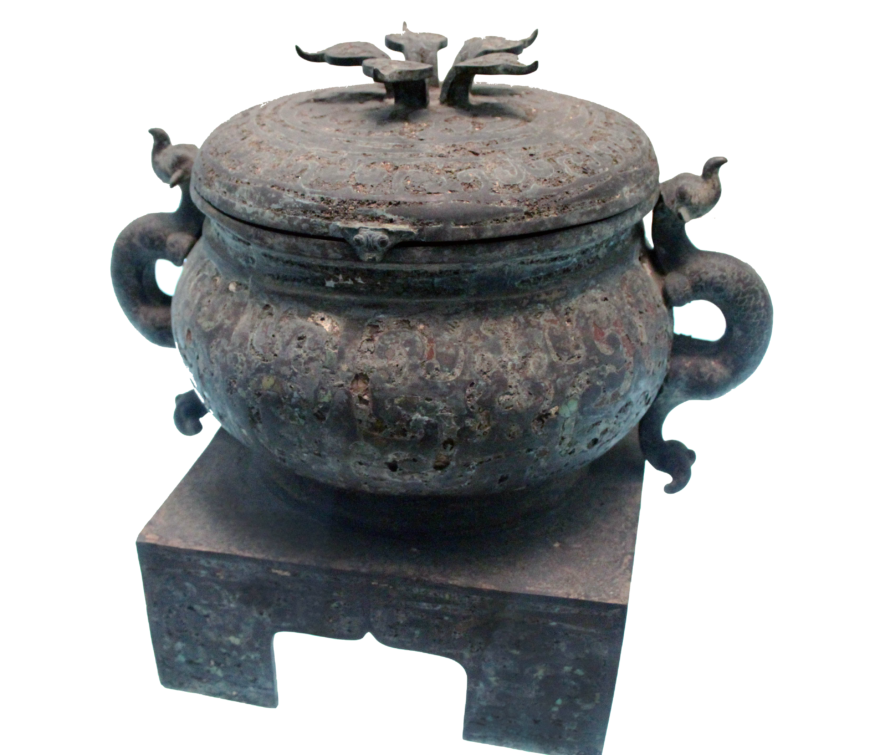
This regulative system began to relax in the late first millennium B.C.E., as we see with the marquis’s tomb. In it we find 9 ding-cauldrons and 8 gui-basins in the central chamber. They reveal the aspiration of Marquis Yi for a status beyond his reach as the ruler of a small southern state. Echoing the ritual relaxation at this time was the simplification and secularization of the bronze inscriptions. Most of Marquis Yi’s bronzes bear the simple inscription “Marquis Yi of Zeng makes, holds, and uses forever.” This inscription signals the broader shift from commemorative writing of the previous Western Zhou period to the straightforward indication of ownership in the Warring States period.
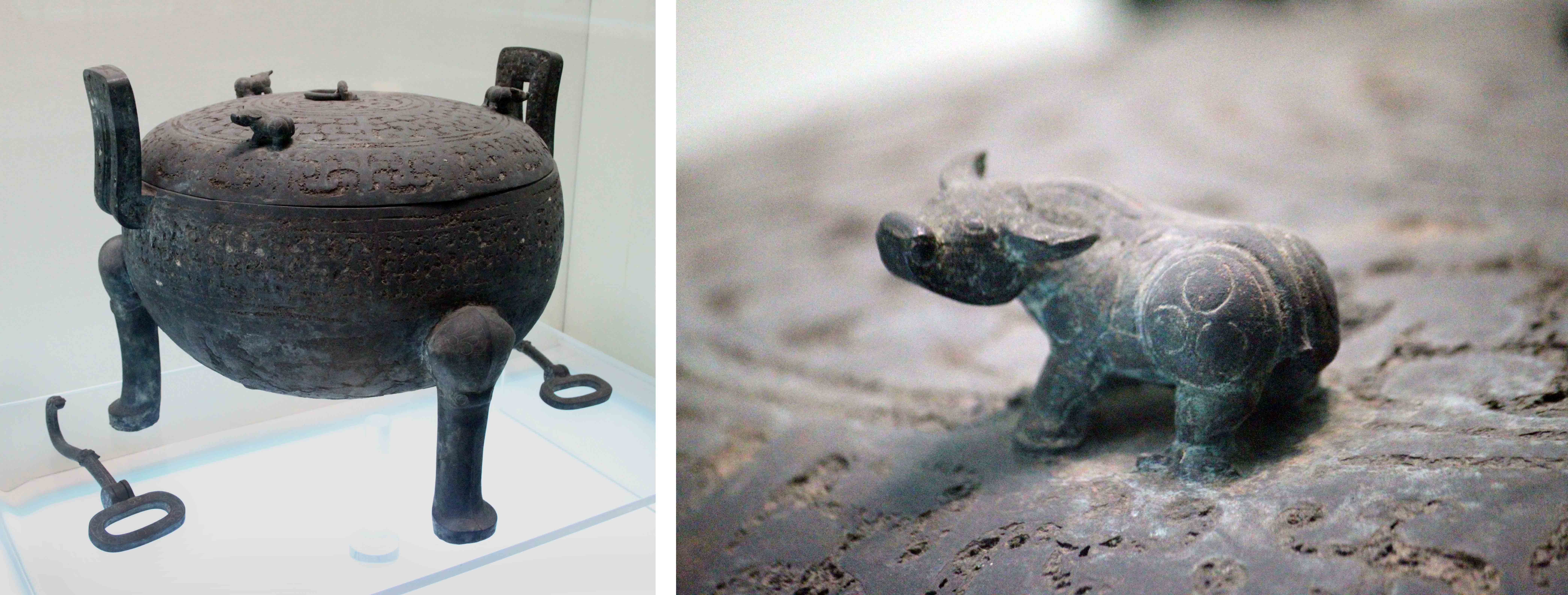
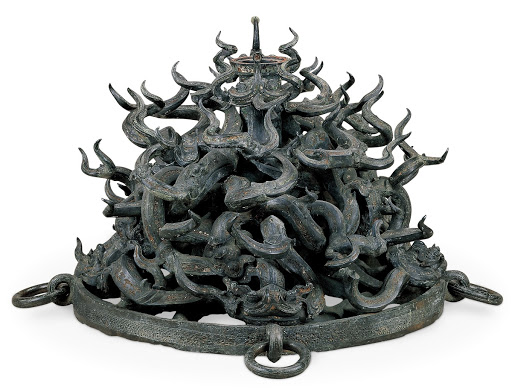
Marquis Yi’s bronzes represent the finest technical achievements in ancient bronze casting. Traditional piece-mold casting first emerged in the middle Yellow River valley in the early second millennium B.C.E. This technique was still practiced in the Zeng state foundry and accounts for most of Marquis Yi’s bronzes. The most spectacular of this long established casting method is the bronze drum base. A swarm of burly serpents vigorously swirl up from the circular base and appear to be boldly exhibiting their brawny physiques in response to music. Each serpent was individually cast and then joined together.
While the lost-wax casting prevailed in the Mediterranean world, the piece-mold casting was the primary casting method uniquely used in China. This technology draws on the rich tradition of pottery making in the Neolithic societies and employs an inner clay core and outer clay molds to cast bronze vessels. Decoration is either drawn directly on the outer molds or transferred to the molds from the original model.
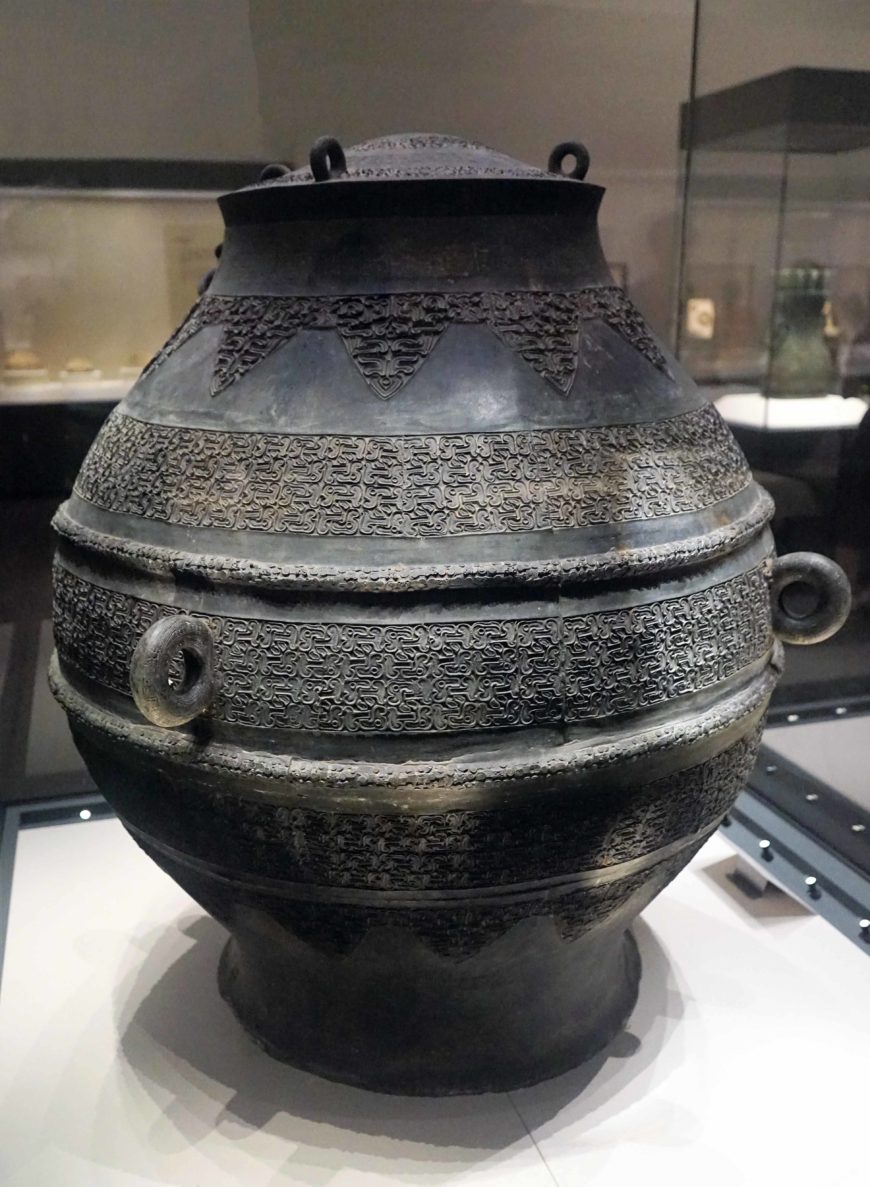
Another technical masterpiece of piece-mold casting is a pair of wine storage jars, which are the most voluminous bronze vessels in the tomb. Their immense volume prevented the founders from completing the casting in one attempt. A wide band that runs through the middle of the vessel body indicates that the upper and lower half were cast separately and joined together afterward.
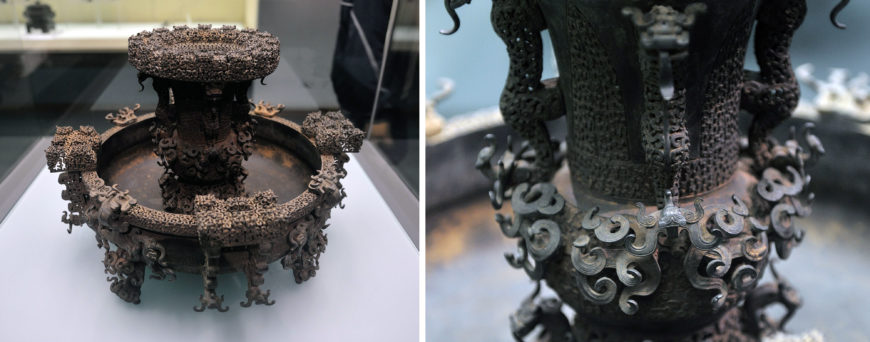
Outside the piece-mold casting, the Zeng state casters also mastered other production methods. Archaeologists usually credit the zun–pan basin and vase set to lost-wax casting. The rim, which appears to be thick and full, consists of intensive miniaturized serpents that curl up and interlace with each other. These intricate designs, especially the deep undercuts and three-dimensional layerings, are nearly technically impossible in piece-mold casting. In addition, the Zeng casters employed copper and lead soldering to connect accessories such as handles, knobs, and legs to the main body of bronze vessels.
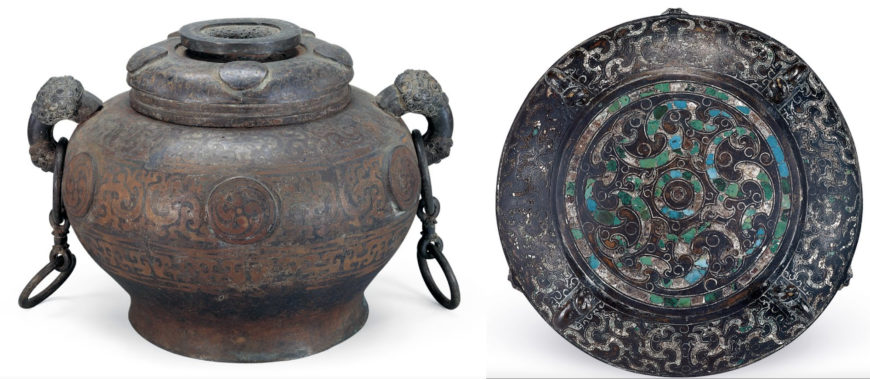
Inlay also played a prominent role in decorating Marquis Yi’s bronzes. There are ritual bronze sacrificial food vessels inlaid with red copper or even turquoise ornaments. In both cases, the Zeng founders first cast the bronze vessel with pre-arranged negative grooves. They then cast the copper and inserted the turquoise in the intaglio lines before finally polishing up the surface of the vessel.
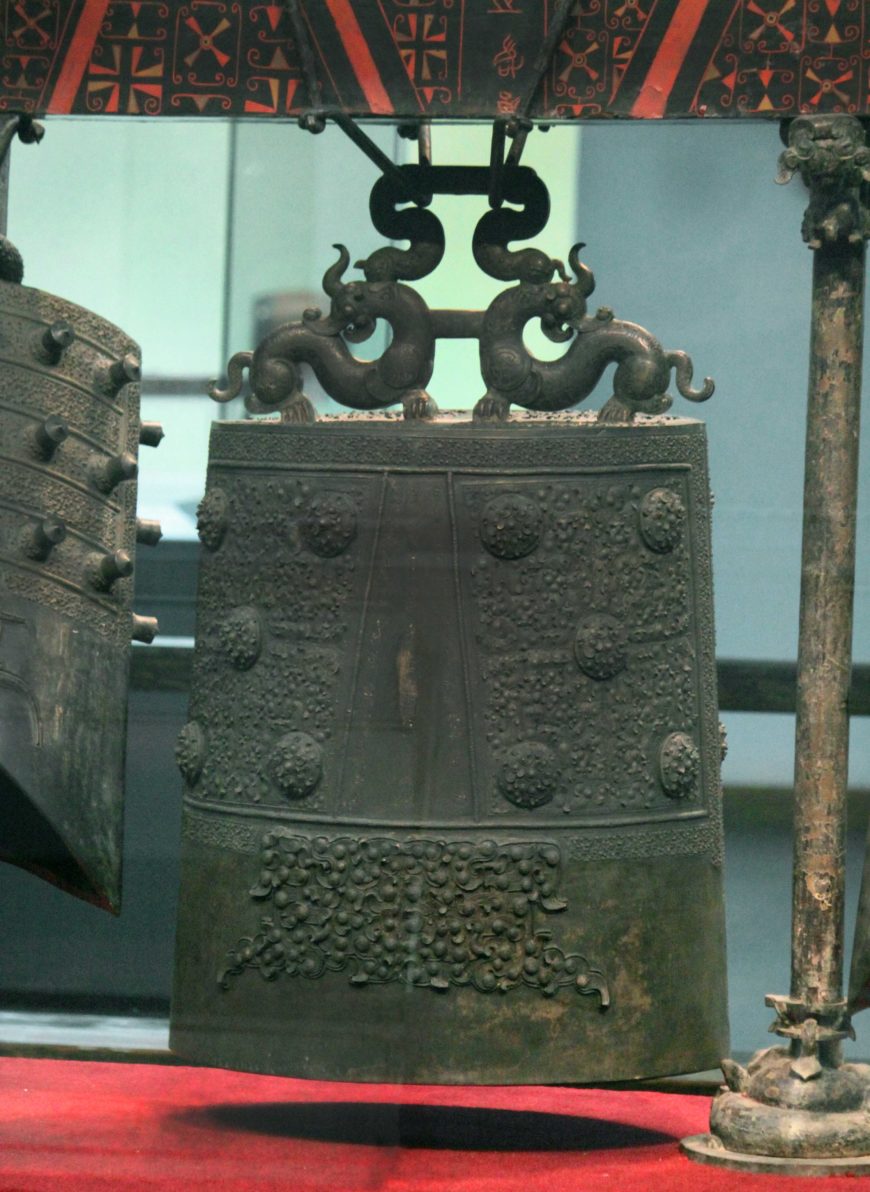
Regional politics
Beyond revealing to us the wealth and ambition of the marquis, certain items in the tomb also tell us about regional politics and trans-regional, Eurasian connections. One bell from the bell chime set shows us how one local ruler of a small state was well-connected to more powerful rulers and larger states than Zeng.
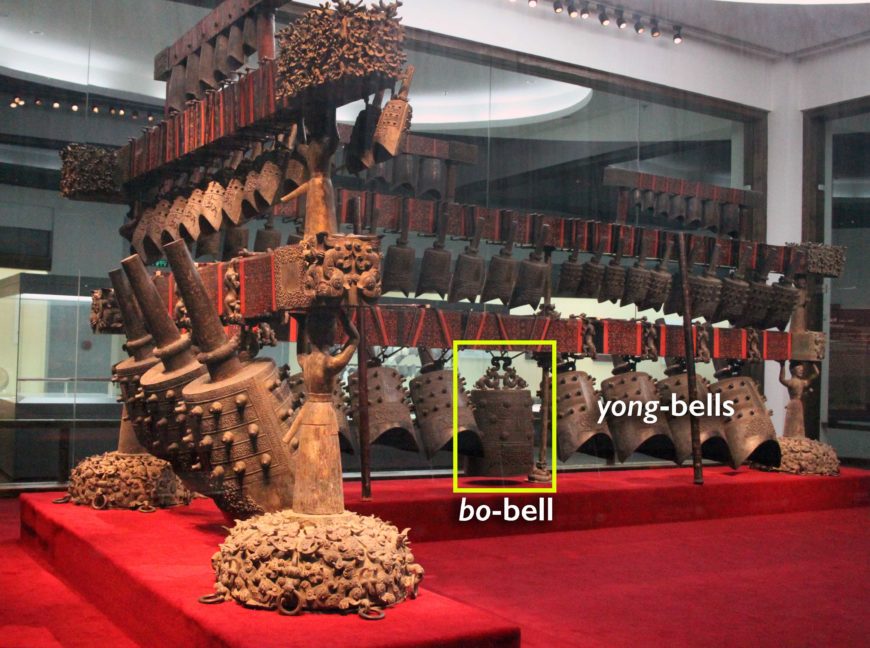
In the center of the chime bell set is a sizable bronze bo-bell with a straight rim that looks different from the other yong-bells (with concave rims) surrounding it. The vertical hanging pose of this central bo-bell also stands out from the uniform tilted suspension seen across the racks holding all the bells. An inscription on the bo-bell indicates that it was a present from Xiong Zhang, the King Hui of the Chu state.
While the lost-wax casting prevailed in the Mediterranean world, the piece-mold casting was the primary casting method uniquely used in China. This technology draws on the rich tradition of pottery making in the Neolithic societies and employs an inner clay core and outer clay molds to cast bronze vessels. Decoration is either drawn directly on the outer molds or transferred to the molds from the original model.
What did this gift mean for Marquis Yi?
The bo-bell indicates the importance of political strategizing during this time—by gifting it to the Marquis Yi of Zeng the nearby Chu king implies that the Zeng state was under the Chu protection (or even that Zeng was a client state to the Chu). The incorporation of the bell into the larger chime bell set suggests that Marquis Yi accepted the political patronage from the Chu state. While the gift suggests Marquis Yi had to compromise some of his power, his burial arrangement also appropriated kingly ritual prestige items like the 9 ding and 8 gui, which were usually reserved for the Zhou ruler. Borrowing from the kingly ritual bronze setting was more of a ceremonial rather than a political statement. Though he probably had less respect for the authority of the central Zhou court, Marquis Yi was not intending to usurp the throne and seize actual power.
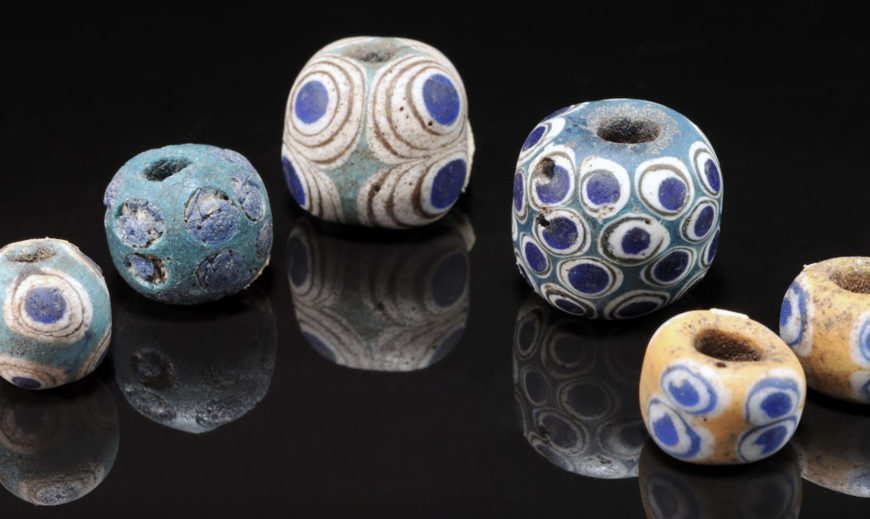
Eurasian Connections
Certain objects in the tomb speak to the increased cultural exchange across the Eurasian continent at this time. 172 glass compound eye beads discovered in the inner coffin were the result of a wave of transcontinental communication. These glass beads, known as the “dragonfly eyes,” were a short-lived fad in Warring States China. Commonly featuring blue concentric circles in bright green or yellow background, compound eye beads find their earlier counterparts in Egypt, Iran, and the eastern Mediterranean. Raman spectroscopy examination shows that the colorants of Marquis Yi’s beads are primarily calcium- and sodium-based, which share similar chemical compositions with beads from West Asia. They were likely directly imported from the west. Soon Chinese craftsmen adopted the form of the exotic glass beads and achieved a comparable look with the locally sourced lead and barium.
This technique utilizes the properties of Raman Scattering, which emits a laser beam to detect the vibration of molecules and, subsequently, analyze the chemical composition of the sample.
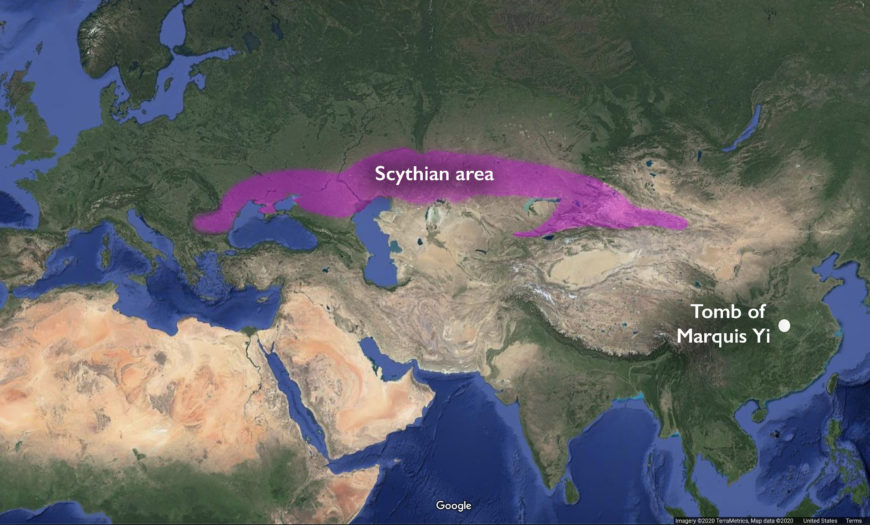
Recent archaeological excavations have unveiled matching glass beads in Scythian burials in Central Asia, implying that the nomads living in the Steppe played a vital role in the long-distance dissemination of the compound eye beads.
From massive burial chambers and gigantic double coffins to grand bronze vessels and chime bells, the tomb of Marquis Yi comprehensively reveals to us the splendid and sophisticated elite life in the Warring States period. All these rich furnishings expressively display the power and wealth of Marquis Yi and enabled his prestige and privilege to continue in the afterlife.
Additional resources
“China, 1000 B.C.–1 A.D.,” Heilbrunn Timeline of Art History, Metropolitan Museum of Art
“Resound: Ancient Bells of China,” National Museum of Asian Art, Smithsonian
Bells of Ancient China, National Museum of Asian Art, Smithsonian
“Introduction to Tomb of Marquis Yi of Zeng,” Hubei Provincial Museum
The Marquis Yi of Zeng, Bronze Objects, on Google Arts and Culture
The Marquis Yi of Zeng, Gold and Jade Objects, on Google Arts and Culture
Han dynasty (206 B.C.E. -220 C.E.)
Funeral banner of Lady Dai (Xin Zhui)

Maybe you can bring it with you…if you are rich enough. The elite men and women of the Han dynasty (China’s second imperial dynasty, 206 B.C.E.–220 C.E.) enjoyed an opulent lifestyle that could stretch into the afterlife. Today, the well-furnished tombs of the elite give us a glimpse of the luxurious goods they treasured and enjoyed. For instance, a wealthy official could afford beautiful silk robes in contrast to the homespun or paper garments of a laborer or peasant. Their tombs also inform us about their cosmological beliefs.
Marquis of Dai, Lady Dai, and a son
Three elite tombs, discovered in 1972, at Mawangdui, Hunan Province (eastern China) rank amongst the greatest archeological discoveries in China during the twentieth century. They are the tombs of a high-ranking Han official civil servant, the Marquis of Dai, Lady Dai (his wife), and their son. The Marquis died in 186 B.C.E., and his wife and son both died by 163 B.C.E. The Marquis’ tomb was not in good condition when it was discovered. However, the objects in the son’s and wife’s tombs were of extraordinary quality and very well preserved. From these objects, we can see that Lady Dai and her son were to spend the afterlife in sumptuous comfort.


In Lady Dai’s tomb, archaeologists found a painted silk banner over six feet long in excellent condition. The T-shaped banner was on top of the innermost of four nesting coffins. Although scholars still debate the function of these banners, we know they had some connection with the afterlife. They may be “name banners” used to identify the dead during the mourning ceremonies, or they may have been burial shrouds intended to aid the soul in its passage to the afterlife. Lady Dai’s banner is important for two primary reasons. It is an early example of pictorial (representing naturalistic scenes not just abstract shapes) art in China. Secondly, the banner features the earliest known portrait in Chinese painting.
We can divide Lady Dai’s banner into four horizontal registers (see diagram). In the lower central register, we see Lady Dai in an embroidered silk robe leaning on a staff. This remarkable portrait of Lady Dai is the earliest example of a painted portrait of a specific individual in China. She stands on a platform along with her servants–two in front and three behind.


Long, sinuous dragons frame the scene on either side, and their white and pink bodies loop through a bi (a disc with a hole thought to represent the sky) underneath Lady Dai. We understand that this is not a portrait of Lady Dai in her former life, but an image of her in the afterlife enjoying the immortal comforts of her tomb as she ascends toward the heavens.
In the register below the scene of Lady Dai, we see sacrificial funerary rituals taking place in a mourning hall. Tripod containers and vase-shaped vessels for offering food and wine stand in the foreground. In the middle ground, seated mourners line up in two rows. Look for the mound in the center, between the two rows of mourners. If you look closely, you can see the patterns on the silk that match the robe Lady Dai wears in the scene above. Her corpse is wrapped in her finest robe! More vessels appear on a shelf in the background.

In the mourning scene, we can also appreciate the importance of Lady Dai’s banner for understanding how artists began to represent depth and space in early Chinese painting. They made efforts to indicate depth through the use of the overlapping bodies of the mourners. They also made objects in the foreground larger, and objects in the background smaller, to create the illusion of space in the mourning hall.
The afterlife in Han dynasty China
Lady Dai’s banner gives us some insight into cosmological beliefs and funeral practices of Han dynasty China. Above and below the scenes of Lady Dai and the mourning hall, we see images of heaven and the underworld. Toward the top, near the cross of the “T,” two men face each other and guard the gate to the heavenly realm. Directly above the two men, at the very top of the banner, we see a deity with a human head and a dragon body.

On the left, a toad standing on a crescent moon flanks the dragon/human deity. On the right, we see what may be a three-legged crow within a pink sun. The moon and the sun are emblematic of a supernatural realm above the human world. Dragons and other immortal beings populate the sky. In the lower register, beneath the mourning hall, we see the underworld populated by two giant black fish, a red snake, a pair of blue goats, and an unidentified earthly deity. The deity appears to hold up the floor of the mourning hall, while the two fish cross to form a circle beneath him. The beings in the underworld symbolize water and earth, and they indicate an underground domain below the human world.

Four compartments surrounded Lady Dai’s central tomb, and they offer some sense of the life she was expected to lead in the afterlife. The top compartment represented a room where Lady Dai was supposed to sit while having her meal. In this compartment, researchers found cushions, an armrest and her walking stick. The compartment also contained a meal laid out for her to eat in the afterlife. Lady Dai was 50 years old when she died, but her lavish tomb—marked by her funeral banner —ensured that she would enjoy the comforts of her earthly life for eternity.
This essay was written with the assistance of Dr. Wu Hung.
Additional Resources:
This object at the Han Provincial Museum
Northern Wei dynasty (386-534 C.E.)
Longmen caves, Luoyang
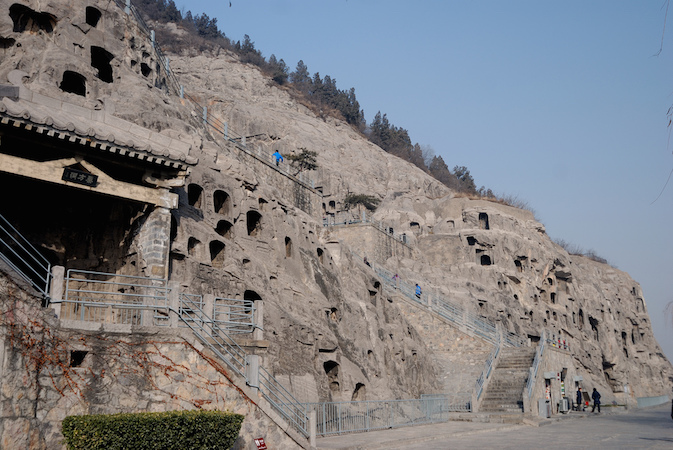
Imperial patronage
Worship and power struggles, enlightenment and suicide—the 2300 caves and niches filled with Buddhist art at Longmen in China has witnessed it all. The steep limestone cliffs extend for almost a mile and contain approximately 110,000 Buddhist stone statues, 60 stupas (hemispherical structures containing Buddhist relics) and 2,800 inscriptions carved on steles (vertical stone markers).
Buddhism, born in India, was transmitted to China intermittently and haphazardly. Starting as early as the 1st century C.E., Buddhism brought to China new images, texts, ideas about life and death, and new opportunities to assert authority. The Longmen cave-temple complex, located on both sides of the Yi River (south of the ancient capital of Luoyang), is an excellent site for understanding how rulers wielded this foreign religion to affirm assimilation and superiority.
Northern Wei Dynasty

Most of the carvings at the Longmen site date between the end of the 5th century and the middle of the 8th century—the periods of the Northern Wei (386–534 C.E.) through early Tang dynasties (618–907 C.E.). The Northern Wei was the most enduring and powerful of the northern Chinese dynasties that ruled before the reunification of China under the Sui and Tang dynasties.
The Wei dynasty was founded by Tuoba tribesmen (nomads from the frontiers of northern China) who were considered to be barbaric foreigners by the Han Chinese. Northern Wei Emperor Xiao Wen decided to move the capital south to Luoyang in 494 C.E., a region considered the cradle of Chinese civilization. Many of the Tuoba elite opposed the move and disapproved of Xiao Wen’s eager adoption of Chinese culture. Even his own son disapproved and was forced to end his own life. At first, Emperor Xiao Wen and rich citizens focused on building the city’s administrative and court quarters—only later did they shift their energies and wealth into the construction of monasteries and temples. With all the efforts expended on the city, the court barely managed to complete one cave temple at Longmen—the Central Binyang Cave.

Central Binyang Cave
The Central Binyang Cave was one of three caves started in 508 C.E. It was commissioned by Emperor Xuan Wu in memory of his father. The other two caves, known as Northern and Southern Binyang, were never completed.
Imagine being surrounded by a myriad of carvings painted in brilliant blue, red, ochre and gold (most of the paint is now gone). Across from the entry is the most significant devotional grouping—a pentad (five figures—see image below).



The central Buddha, seated on a lion throne, is generally identified as Shakyamuni (the historical Buddha), although some scholars identify him as Maitreya (the Buddha of the future) based on the “giving” mudra—a hand gesture associated with Maitreya. He is assisted by two bodhisattvas and two disciples—Ananda and Kasyapa (bodhisattvas are enlightened beings who have put off entering paradise in order to help others attain enlightenment).
The Buddha’s monastic robe is rendered to appear as though tucked under him (image above). Ripples of folds cascade over the front of his throne. These linear and abstract motifs are typical of the mature Northern Wei style (as also seen in this gilt bronze statue of Buddhas Shakyamuni and Prabhutaratna, from 518 C.E.). The flattened, elongated bodies of the Longmen bodhisattvas (image left) are hidden under elaborately pleated and flaring skirts. The bodhisattvas wear draping scarves, jewelry and crowns with floral designs. Their gentle, smiling faces are rectangular and elongated.

Low relief carving covers the lateral walls, ceiling, and floor. Finely chiseled haloes back the images. The halo of the main Buddha extends up to merge with a lotus carving in the middle of the ceiling, where celestial deities appear to flutter down from the heavens with their scarves trailing. In contrast to the Northern Wei style seen on the pentad, the sinuous and dynamic surface decoration displays Chinese style. The Northern Wei craftsmen were able to marry two different aesthetics in one cave temple.
Two relief carvings of imperial processions (below) once flanked the doorway of the cave entrance. The emperor’s procession is at the Metropolitan Museum, while the empress’s procession is at the Nelson-Atkins Museum. These reliefs most likely commemorate historic events. According to records, the Empress Dowager visited the caves in 517 C.E., while the Emperor was present for consecration of the Central Binyang in 523 C.E.


These reliefs are the most tangible evidence that the Northern Wei craftsmen masterfully adopted the Chinese aesthetic. The style of the reliefs may be inspired by secular painting, since the figures all appear very gracious and solemn. They are clad in Chinese court robes and look genuinely Chinese—mission accomplished for the Northern Wei!
Tang Dynasty
The Tang dynasty (618–907 C.E.) is considered the age of “international Buddhism.” Many Chinese, Indian, Central Asian and East Asian monks traveled throughout Asia. The centers of Buddhism in China were invigorated by these travels, and important developments in Buddhist thought and practice originated in China at this time.
Fengxian Temple
This imposing group of nine monumental images carved into the hard, gray limestone of Fengxian Temple at Longmen is a spectacular display of innovative style and iconography. Sponsored by the Emperor Gaozong and his wife, the future Empress Wu, the high relief sculptures are widely spaced in a semi-circle.

The central Vairocana Buddha (more than 55 feet high including its pedestal) is flanked on either side by a bodhisattva, a heavenly king, and a thunderbolt holder (vajrapani). Vairocana represents the primordial Buddha who generates and presides over all the Buddhas of the infinite universes that form Buddhist cosmology. This idea—of the power of one supreme deity over all the others—resonated in the vast Tang Empire which was dominated by the Emperor at its summit and supported by his subordinate officials. These monumental sculptures intentionally mirrored the political situation. The dignity and imposing presence of Buddha and the sumptuous appearance of his attendant bodhisattvas is significant in this context.

The Buddha, monks and bodhisattvas (above) display new softer and rounder modeling and serene facial expressions. In contrast, the heavenly guardians and the vajrapani are more engaging and animated. Notice the realistic musculature of the heavenly guardians and the forceful poses of the vajrapani (below).

Kanjing Temple


Tang dynasty realism—whether fleshy or wizened, dignified or light-hearted—is displayed in the Kanjing cave Temple at Longmen. Here we see accurate portrayals of individuals. This temple was created from about 690-704 C.E. under the patronage of Empress Wu.
In the images of arhats (worthy monks who have advanced very far in their quest of Enlightenment), who line the walls, the carver sought to create intense realism. Although they are still mortal, arhats are capable of extraordinary deeds both physical and spiritual (they can move at free will through space, can understand the thoughts in people’s minds, and hear the voices of far away speakers). Twenty-nine monks form a procession around the cave perimeter, linking the subject matter to the rising interest in Chan Buddhism (the Meditation School) fostered at court by the empress herself. These portraits record the lineage of the great patriarchs who transmitted the Buddhist doctrine.
Sovereignty and iconography
Foreign rulers of the Northern Wei, yearning for assimilation and control, made use of Buddhist images for authority and power. Tang dynasty leaders thrived during China’s golden age, asserting their sovereignty with the assistance of Buddhist iconography. Today you can visit the stunning limestone remains in Luoyang, New York City, and Kansas City.
The author would like to thank her teacher, Professor Angela Howard.
Northern Qi dynasty (550-577)
Bodhisattva, probably Avalokiteshvara (Guanyin)
by DR. JENNIFER N. MCINTIRE and DR. BETH HARRIS
Video \(\PageIndex{6}\): Bodhisattva, probably Avalokiteshvara (Guanyin), Northern Qi dynasty, c. 550-60, Shanxi Province, China, sandstone with pigments, 13-3/4 feet / 419.1 cm high (Metropolitan Museum of Art, New York)
Smarthistory images for teaching and learning:
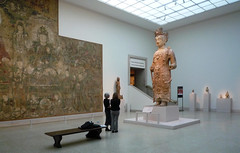
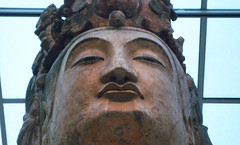
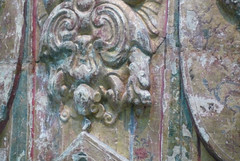
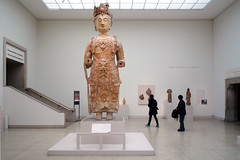
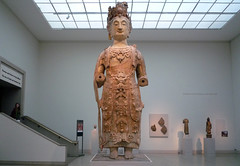
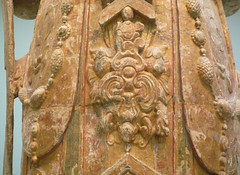

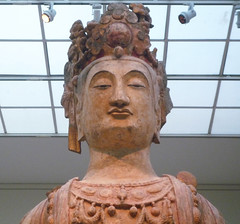
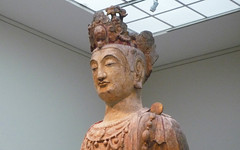
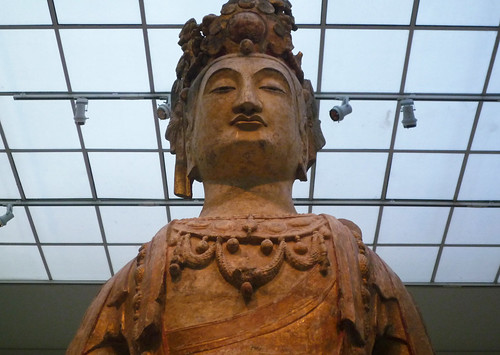
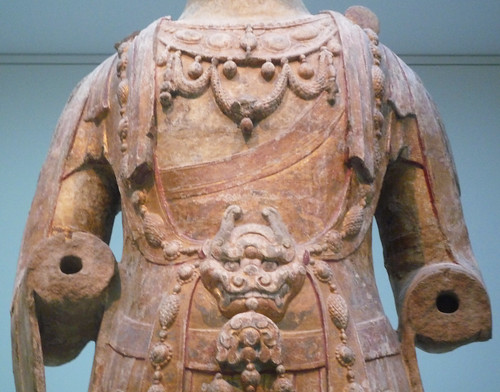
The art of the Tang dynasty
The Tang dynasty was one of the most powerful in Chinese history. In this period, China becomes the the most prominent civilization in East Asia—with links east to Korea and Japan and west, along the Silk Route.
618 - 907
Chinese Buddhist cave shrines
Video \(\PageIndex{7}\): This video explores ancient Buddhist cave shrines in China, including why the sites were created and the major sponsors and patrons. Video from the Asian Art Museum.
Mogao caves at Dunhuang

A trove of Buddhist art
The ‘Caves of the Thousand Buddhas’ (Qianfodong), also known as Mogao, are a magnificent treasure trove of Buddhist art. They are located in the desert, about 15 miles south-east of the town of Dunhuang in north western China. By the late fourth century, the area had become a busy desert crossroads on the caravan routes of the Silk Road linking China and the West. Traders, pilgrims and other travellers stopped at the oasis town to secure provisions, pray for the journey ahead or give thanks for their survival. Records state that in 366 monks carved the first caves into the cliff stretching about 1 mile along the Daquan River.

An archive rediscovered
At some point in the early eleventh century, an incredible archive—with up to 50,000 documents, hundreds of paintings, together with textiles and other artefacts—had been sealed up in a chamber adjacent to one of the caves (Cave 17). Its entrance was concealed behind a wall painting and the trove remained hidden from sight for centuries. In 1900, it was discovered by Wang Yuanlu, a Daoist monk who had appointed himself abbot and guardian of the cave-temples. The first Western expedition to reach Dunhuang arrived in 1879. More than twenty years later Hungarian-born Marc Aurel Stein, a British archaeologist and explorer, learned of the importance of the caves.

Stein reached Dunhuang in 1907. He had heard rumours of the walled-in cave and its contents. The abbot sold Stein seven thousand complete manuscripts and six thousand fragments, as well as several cases loaded with paintings, embroideries and other artifacts. French explorer Paul Pelliot followed close on Stein’s heels. Pelliot remarked in a letter, “During the first ten days I attacked nearly a thousand scrolls a day…”
Other expeditions followed and returned with many manuscripts and paintings. The result is that the Dunhuang manuscripts and scroll paintings are now scattered over the globe. The bulk of the material can be found in Beijing, London, Delhi, Paris, and Saint Petersburg. Studies based on the textual material found at Dunhuang have provided a better understanding of the extraordinary cross-fertilization of cultures and religions that occurred from the fourth through the fourteenth centuries.
A thousand years of art
There are about 492 extant cave-temples ranging in date from the fifth to the thirteenth centuries. During the thousand years of artistic activity at Dunhuang, the style of the wall paintings and sculptures changed. The early caves show greater Indian and Western influence, while during the Tang dynasty (618-906 C.E.) the influence of the Chinese painting styles of the imperial court is apparent. During the tenth century, Dunhuang became more isolated and the organization of a local painting academy led to mass production of paintings with a unique style.

The cave-temples are all man-made, and the decoration of each appears to have been conceived and executed as a conceptual whole. The wall-paintings were done in dry fresco. The walls were prepared with a mixture of mud, straw, and reeds that were covered with a lime paste. The sculptures are constructed with a wooden armature, straw, reeds, and plaster. The colors in the paintings and on the sculptures were done with mineral pigments as well as gold and silver leaf. All the Dunhuang caves face east.
Changes in belief
The art also reflects the changes in religious belief and ritual at the pilgrim site. In the early caves, jataka tales (previous lives of the Historical Buddha) were commonly depicted. During the Tang dynasty, Pure Land Buddhism became very popular. This promoted the Buddha Amitabha, who helped the believer achieve rebirth in his Western Paradise, where even sinners are permitted, sitting within closed lotus buds listening to the heavenly sounds and the sermon of the Buddha, thus purifying them. Various Paradise paintings decorate the walls of the cave-temples of this period, each representing the realm of a different Buddha. Their Paradises are depicted as sumptuous Chinese palace settings.

Images of the caves
During WWII the famous, contemporary Chinese painter Zhang Daqian spent time at Dunhuang with his students. They copied the cave paintings. Photojournalist James Lo—a friend of Zhang Daqian—joined him at Dunhuang and systematically photographed the caves. Traveling partly on horseback, they arrived at Dunhuang in 1943 and began a photographic campaign that continued for eighteen months. The Lo Archive (a set is now housed at Princeton University) consists of about 2,500 black-and-white historic photographs. Since no electricity was available, James Lo devised a system of mirrors and cloth screens that bounced light along the corridors of the caves to illuminate the paintings and sculptures.
Today the Mogao cave-temples of Dunhuang are a World Heritage Site. Under a collaborative agreement with China’s State Administration of Cultural Heritage (SACH), the Getty Conservation Institute (GCI) has been working with the Dunhuang Academy since 1989 on conservation. Tourists can visit selected cave-temples with a guide.
Backstory
The Mogao caves at Dunhuang were reclaimed from the encroaching Gobi desert beginning in the early twentieth century, but their conservation is an ongoing challenge. In addition to natural threats like sandstorms and rainwater, the caves’ delicate murals face damage caused mainly by tourists (hundreds of thousands per year, up to 6,000 per day), whose presence adds dangerous levels of carbon dioxide and humidity to the air. Fortunately, much is being done to preserve the artworks at Dunhuang—and new technologies are also making it possible for the caves to be meticulously documented and shared around the world.
The Mogao caves were designated as a UNESCO World Heritage Site in 1987, and are overseen by international watchdog groups as well as a state-run institution called the Dunhuang Research Academy. Since 1989, they have been working with China’s State Administration of Cultural Heritage and the Getty Conservation Institute on structural reinforcement, careful restoration and stabilization of the murals, and digital documentation. The Mogao caves were also a test site for the development of the China Principles, a set of international standards for preserving cultural heritage—not only in terms of physical assets, but also with respect to local traditions, environment, and history.
Images of the caves were first produced during World War II, when the famous contemporary Chinese painter Zhang Daqian spent time copying the cave paintings with his students. Photojournalist James Lo joined the effort by systematically photographing the caves using an ingenious system of mirrors to bounce natural light into the dark spaces. The Lo Archive (a set is now housed at Princeton University) consists of about 2,500 black-and-white photographs.
In recent years, teams have been working to create physical replicas of the caves that can be displayed at museums and other sites around the world. Virtual reality technology has also been used to create immersive media environments that replicate the experience of being in the caves, and preserve important data about the spaces’ measurements and other physical properties. These types of reproductions can also help reduce the effects of human presence in the caves by making digital reconstructions available at Dunhuang itself: visitors can spend time looking closely at these “digital caves,” allowing for stricter time limits and lower visitor numbers in the caves themselves. In addition, these digital versions can be shared easily around the world, along with a growing archive of high-quality photographs. The manuscripts and other objects from Cave 17, discussed above, have also been digitized and are available online.
New technologies are also making it possible to preserve and share data about other important Buddhist sites in China. At the Yungang Grottoes in northeastern China, where the sculpture is threatened not only by tourism but also by China’s high levels of industrial air pollution and acid rain, 3-D scanning is being used to model the monumental sculptures and create highly accurate reproductions that can be shared and shown around the globe.
The Mogao caves and Yungang Grottoes are outstanding human achievements that are now threatened by other types of human endeavors: climate change, tourism, and pollution. The continued development of new technologies and approaches for preserving and documenting these invaluable sites is essential to their survival.
Backstory by Dr. Naraelle Hohensee
Additional resources
International Dunhuang Project
The Caves at Dunhuang – New York Times Slideshow and related article by Holland Carter
Dunhuang Manuscripts on Wikipedia UNESCO World Heritage Site
Application of the China Principles at the Mogao Grottoes from the Getty Research Institute
Cave Temples of Dunhuang: Buddhist Art on China’s Silk Road at the Getty Research Institute
The paintings and manuscripts from cave 17 at Mogao (1 of 2)
Buddhism in China
Buddhism probably arrived in China during the Han dynasty (206 B.C.E. – 220 C.E.), and became a central feature of Chinese culture during the period of division that followed. Buddhist teaching ascribed great merit to the reproduction of images of Buddhas and bodhisattvas, in which the artisans had to follow strict rules of iconography.
A twelfth-century catalogue of the Chinese imperial painting collection lists Daoist and Buddhist works from the time of Gu Kaizhi (c. 344-406 C.E.) onwards. However, no paintings by major artists of this period have survived, because foreign religions were proscribed between 842 and 845, and many Buddhist monuments and works of art were destroyed.
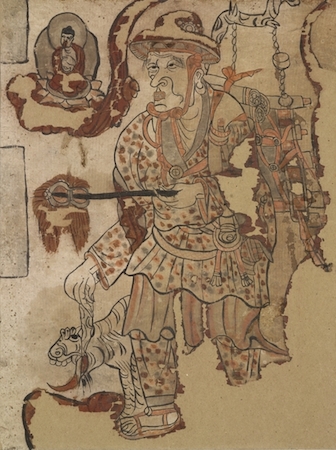
The Valley of the Thousand Buddhas
What has survived from the Tang period (618-906) is an important collection of Buddhist paintings on silk and paper, found in Cave 17, in the Valley of the Thousand Buddhas at the Chinese end of the Silk Road. Since Dunhuang was under Tibetan occupation at this time, its cave shrines and paintings escaped destruction.
The “Caves of the Thousand Buddhas,” or Qianfodong, are situated at Mogao, about 25 kilometres south-east of the oasis town of Dunhuang in Gansu province, western China, in the middle of the desert. By the late fourth century, the area had become a busy desert crossroads on the caravan routes of the Silk Road linking China and the West. Traders, pilgrims and other travelers stopped at the oasis town to stock up with provisions, pray for the journey ahead or give thanks for their survival. At about this time wandering monks carved the first caves into the long cliff stretching almost 2 kilometers in length along the Daquan River.
Over the next millennium more than 1000 caves of varying sizes were dug. Around five hundred of these were decorated as cave temples, carved from the gravel conglomerate of the escarpment. This material was not suitable for sculpture, as at other famous Buddhist cave temples at Yungang and Longmen. The Caves of the Thousand Buddhas gained their name from the legend of a monk who dreamt he saw a cloud with a thousand Buddhas floating over the valley.
Sealed for a thousand years, then rediscovered
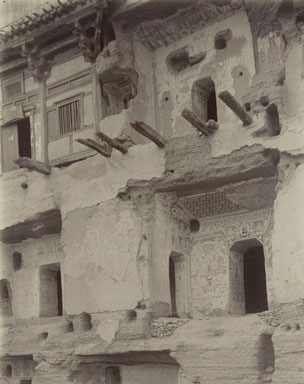
When the Silk Road was abandoned under the Ming dynasty (1368-1644), oasis towns lost their importance and many were deserted. Although the Mogao caves were not completely abandoned, by the nineteenth century they were largely forgotten, with only a few monks staying at the site. Unknown to them, at some point in the early eleventh century, an incredible archive—with up to 50,000 documents, hundreds of paintings, together with textiles and other artifacts—was sealed up in one of the caves (Cave 17). Its entrance concealed behind a wall painting, the cave remained hidden from sight for centuries, until 1900, when it was discovered by Wang Yuanlu, a Daoist monk who had appointed himself abbot and guardian of the caves.
The first Western expedition to reach Dunhuang, led by a Hungarian count, arrived in 1879. More than twenty years later one of its members, Lajos Lóczy, drew the attention of the Hungarian-born Marc Aurel Stein, by then a well-known British archaeologist and explorer, to the importance of the caves. Stein reached Dunhuang and Mogao in 1907 during his second expedition to Central Asia. By this time, he had heard rumors of the walled-in cave and its contents.
After delicate negotiations with Wang Yuanlu, Stein negotiated access to the cave. “Heaped up in layers,” Stein wrote, “but without any order, there appeared in the dim light of the priest’s little lamp a solid mass of manuscript bundles rising to a height of nearly ten feet…. Not in the driest soil could relics of a ruined site have so completely escaped injury as they had here in a carefully selected rock chamber, where, hidden behind a brick wall, …. these masses of manuscripts had lain undisturbed for centuries.” (M. Aurel Stein,Ruins of Desert Cathay (1912; reprint, New York, Dover, 1987).
The abbot eventually sold Stein seven thousand complete manuscripts and six thousand fragments, as well as several cases loaded with paintings, embroideries and other artifacts; the money was used to fund restoration work at the caves.The manuscripts are now in the British Library and the paintings have been divided between the National Museum in New Delhi and the British Museum, where over three hundred paintings on silk, hemp and paper are kept.
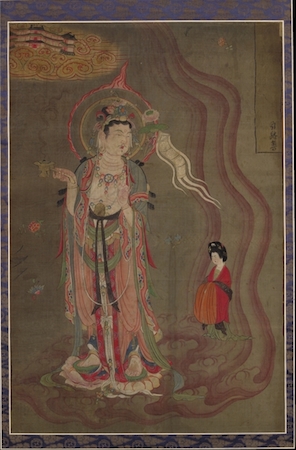
This painting is inscribed with the characters yinlu pu or “Bodhisattva leading the Way.” It is one of several examples from Mogao of a bodhisattva leading the beautifully clad donor figure to the Pure Land, or Paradise, indicated by a Chinese building floating on clouds in the top left corner. The two figures are also supported by a cloud indicating that they are flying.
The bodhisattva, shown much larger than the donor, is holding a censer and a banner in his hand. The banner is one of many of the same type found at Mogao, with a triangular headpiece and streamers. The woman appears to be very wealthy, with gold hairpins in her hair. Actual examples of these were found in Chinese tombs. Her fashionably plump figure suggests that the painting was executed in the ninth or tenth century.
Suggested readings:
H. Wang (ed.), Sir Aurel Stein. Proceedings of the British Museum Study Day 2002 (London, British Museum Occasional Paper 142, 2004).
H. Wang, Money on the Silk Road. The Evidence from Eastern Central Asiato c. AD 800 (London, British Museum Press, 2004).
S. Whitfield, Aurel Stein on the Silk Road (London, British Museum Press, 2004).
J. Falconer, A. Kelecsenyi, A. Karteszi and L. Russell-Smith (E. Apor and H. Wang eds.), Catalogue of the Collections of Sir Aurel Stein in the Library of the Hungarian Academy of Sciences (published jointly by the British Museum and the Library of the Hungarian Academy of Sciences, Budapest [LHAS Oriental Series 11], 2002).
H. Wang (ed.), Handbook to the Stein Collections in the UK (London, British Museum Occasional Paper 129, 1999).
© Trustees of the British Museum
The paintings and manuscripts from cave 17 at Mogao (2 of 2)
Change over a thousand years
During the thousand years of artistic activity at Mogao, the style of the wall paintings and sculptures changed, in part a reflection of the influences that reached it along the Silk Road. The early caves show greater Indian and Western influence, while during the Tang dynasty (618-906) the influence of the latest Chinese painting styles of the imperial court is evident. During the tenth century, Dunhuang became more isolated and the organization of a local painting academy led to mass production of paintings with a unique style.
The art also reflects the changes in religious belief and ritual at the pilgrim site. In the early caves, jataka stories (about Buddha’s previous incarnations) were commonly depicted. During the Tang dynasty, Pure Land Buddhism became very popular. This promoted the Buddha Amitabha, who helped the believer achieve rebirth in his Western Paradise, where even sinners are permitted, sitting within closed lotus buds listening to the heavenly sounds and the sermon of the Buddha, thereby purifying themselves.
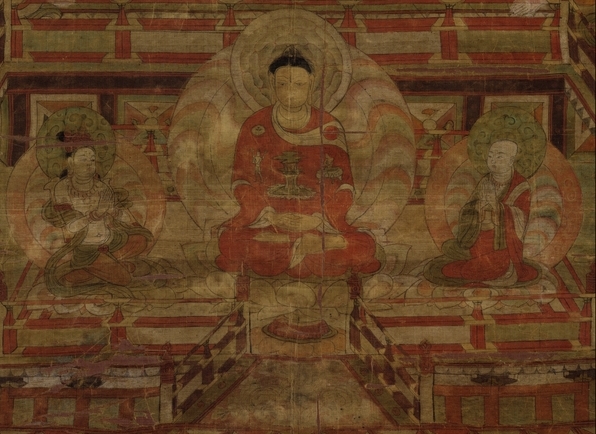
In this Pure Land, or Paradise painting, Shakyamuni, the historical Buddha, with his hands in the vitarka-mudra (gesture of preaching), sits between two bodhisattvas. A dancer and an orchestra perform before him. Another group sits below them. The Buddha has the sun and the moon on his robes, the cosmological emblems of Mount Shumeru. The scene is probably intended to represent Shakyamuni’s cosmic aspect as expounded in the Lotus Sutra. Two mythical creatures standing on golden islands, the double-headed jiva-jiva and the kalavinka, flank this second group. A row of donors are shown at the base of the painting.
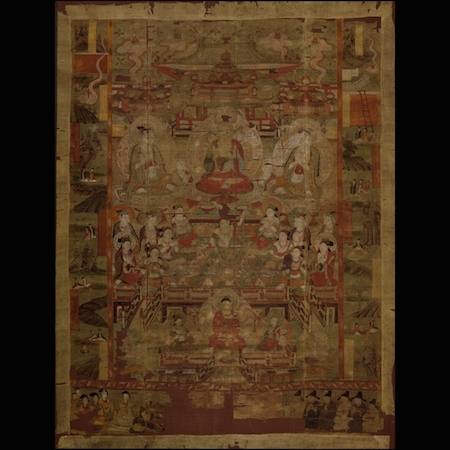
Along both sides of the painting a sequence of episodes tells the story of Prince Siddhartha from the Baoen-jing, the ‘Sutra of Requiting Blessings Received’. This is a jataka about Shakyamuni’s previous incarnation. Prince Siddhartha and his parents flee their palace upon hearing the murderous intent of a treacherous minister. When their provisions run out, Siddhartha offers his own flesh to his parents. After his parents have each taken a piece, Siddhartha is left by the roadside. A hungry lion appears, and the prince offers his final piece of flesh to the creature. The lion turns out to be the god Indra, who restores him to strength and wholeness.
Various Paradise paintings decorate the walls of the cave temples of this period, each representing the realm of a different Buddha. Their Paradises were shown in sumptuous Chinese palace settings. Simplified versions of these buildings appear on banners depicting bodhisattvas showing donors on their way to Paradise.
Patrons
The decoration of each cave-temple was usually commissioned by an individual (whether an official, monk, governor or merchant, for example) and dedicated to their families and deceased relatives. However, some were commissioned by groups of lay individuals, or a religious society. The responsibility for the cave’s upkeep was often passed on to the patron’s descendants, and it could stay in the same family for generations.
The caves were excavated by a team of workmen, who chizelled out the ceiling and walls, which were then plastered with clay tempered with chopped straw and finished with a thin layer of plaster. The paintings would have already been commissioned, and were executed by skilled workmen under the direction of a senior Buddhist monk. Sculptures made of stucco around a wooden armature were also an integral part of the decoration.
Patrons and their portraits played an increasingly important part as time passed. At first they were depicted as much smaller than the main figures in the composition and in a subordinate position to the side. However, they gradually increased in size, until by the tenth century they occupied a large proportion of the lowest register of the paintings. In some paintings they are shown as part of the main composition and in the same scale as the holy figures in the paintings.
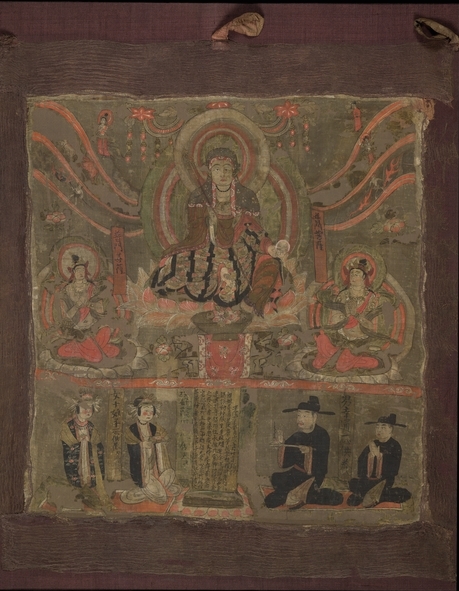
The bodhisattva Kshitigarbha in the painting above is shown wearing a hood and seated on a lotus behind an altar accompanied by two worshipping bodhisattvas. On the three lines on each side of his halo are depicted “The Six Ways of Life”: gods, animals and hell (top left) and humans, ashuras (mythical four-armed figures) and hungry ghosts (right).
In the lower section of the painting are donor figures, wearing fashionable clothes, the women with typical tenth-century hair styles decorated with hairpins and flowers. According to the inscription, the donor wished to avoid all bad forms of rebirth: “The maker of this painting was the disciple of pure faith, Kang Qingnu. His body lodges in the House of Fire and he fears to fall in the Five Evil Ways. Fortune and disaster are inconstant; his heart longs to be among the emancipated…”. Kshitigarbha is depicted and invoked here as he had vowed to rescue souls even from the regions of hell, and this offers hope to the donor and his family.
Suggested readings:
R. Whitfield, Art of Central Asia: Paintings from Dunhuang, vol. 2 (Tokyo, Kodansha International Ltd., 1982-85).
R. Whitfield and A. Farrer, Caves of the thousand Buddhas (London, The British Museum Press, 1990).
© Trustees of the British Museum
Attributed to Zhou Fang, Ladies Wearing Flowers in Their Hair
“The Beautiful Woman” Genre of Chinese Painting
Throughout the history of Chinese art, painters never tired of adopting beautiful female figures as the subject of their depictions. With a stable political structure, flourishing economy and prosperous culture, the genre of “beautiful women painting” (meirenhua) enjoyed high popularity and reached significant achievement in the Tang dynasty (618-907).
Born into an aristocratic family in Chang’an (the modern city of Xi’an), Zhou Fang is a well-known Tang court artist who painted in this genre. Even though it is not signed, Ladies Wearing Flowers in Their Hair, now kept in the Liaoning Provincial Museum in Shenyang, is traditionally attributed to Zhou Fang. It demonstrates how pictures of beautiful women can provide insight into ideals of feminine beauty and the social customs of the Tang dynasty. This horizontal scroll portrays five palace ladies and a maidservant amusing themselves in a garden scene. In the first section (below), two court ladies play with an adorable dog, one teasing it with a duster.

In the middle section (below), a third palace lady rendered in hierarchal scale (depicted larger because of her higher status) is followed by a maidservant holding a long-handled fan. She gazes at a red flower that she holds in her hand and prepares to adorn her hair with it. A crane passes in front of the lady.
Another court lady shown in a relatively small size strolls nearby with her hands clasped, adding a sense of depth and variation to the composition of the scroll (below). Beside a blooming magnolia tree growing next to a garden stone, the last lady in the picture catches a butterfly and her attention shifts to a dog that appears to be running to her. Representations of the leisure and amusements enjoyed by aristocratic women can be seen as a reflection of their idle and carefree life in the palace.
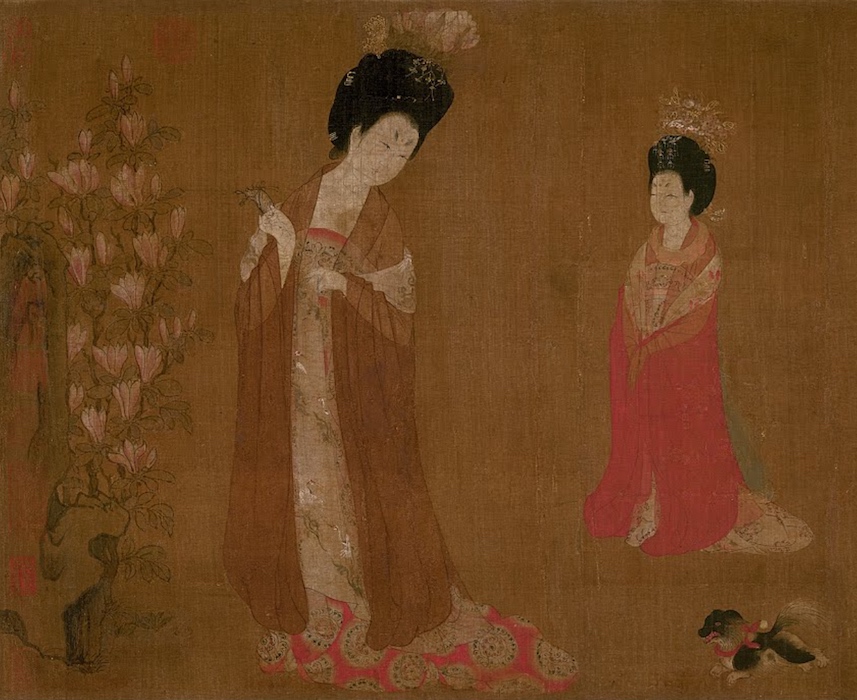
Feminine Beauty in the Tang Dynasty
In the Tang dynasty a voluptuous body represented the ideal of feminine beauty. Zhou Fang’s portrayals of court ladies in the scroll are characterized by round faces and plump figures. Their eyebrows are painted in the shape of butterfly wings and they display slender eyes, full noses and small, cherry-like mouths. Their hair style is done in a high bun adorned with delicate gold ornaments and artificial blossoms such as peonies or lotuses. The ladies’ fair complexion comes from white pigment that was applied to their skin.
The court ladies are gracefully dressed in long, loose fitting gowns covered by transparent gauzes and scarves—all fashionable at the time. Their costumes of red, white or ocher hues are exquisitely decorated with repeated floral, cranes or geometric motifs that highlight the artist’s meticulous care and sophisticated skill in painting this subject.
Under Zhou’s brush, the plump bodies, facial traits, fair complexions, distinctive garments, and rich adornments together express the particular sense of the beauty and extravagance associated with aristocratic women of the Tang dynasty, and at the same time demonstrate broader aesthetic preferences for feminine beauty during this period. The artist’s contemporaries tended to favor similar portrayals of women—who functioned as symbols of the wealth and culture of the Tang dynasty, traditionally considered one of the most prosperous and cultivated in the history of China.
The Custom of Wearing Flowers in Women’s Hair
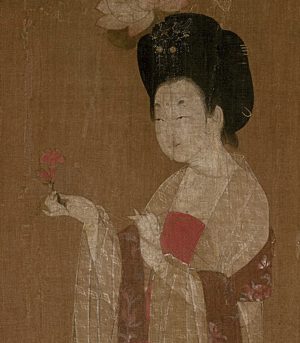
In Ladies Wearing Flowers in Their Hair, the huge blossoms worn in the ladies’ high bun not only depicted a particular fashion of the time, but also a social custom performed by women during the springtime festival of “Flower Morning” in the Chinese tradition. According to a number of literary accounts, during this festival ladies adorned their hair with artificial flowers made in paper or silk, captured butterflies with their fans and held outdoor picnics in celebration of the springtime. On the one hand, the practice of wearing flowers expressed women’s admiration for the beauty of the blossoms, but on the other hand, flowers symbolized the fleeting nature of youth.
Literary records provide clues for another symbolic meaning associated with this conventional practice. The ninth-century scholar Wang Renyu documented that every springtime, the Tang dynasty emperor Xuanzong (who ruled from 685–762) organized a banquet and required palace women to wear blossoms in their hair. Should a released butterfly alight on her blossom, the lady could be selected as a bed partner of the emperor. More broadly, the practice of women wearing flowers in their hair is associated with the pursuit of love and the desire for conjugal happiness—and is not a simple fashion accessory. Zhou excelled by further revealing the court ladies’ inner emotions through the subtle depiction of their facial expressions in the masterpiece Ladies Wearing Flowers in Their Hair, which, more than a thousand years after its creation, continues to hold great significance in Chinese art, history and culture.
Additional resources:
Zoomable image on the Google Art Project
The Tang Dynasty on the Metropolitan Museum of Art’s Heilbrunn Timeline of Art History
Ellen Johnston Laing, “Notes on Ladies Wearing Flowers in their Hair,” Orientations, vol. 21, no. 2 (Feb., 1990), pp. 32–39.
The art of the Song dynasty
The Song dynasty is known especially for the development of monumental landscape painting.
960 - 1279
Neo-Confucianism and Fan Kuan, Travelers by Streams and Mountains

Daoist mountain man, hermit, rustic, wine-lover—Fan Kuan has the reputation of having been truly unconventional. We know very little about this great artist, yet he painted the most majestic landscape painting of the early Song period. Everything about Travelers by Streams and Mountains, which is possibly the only surviving work by Fan Kuan, is an orderly statement reflecting the artist’s worldview.
Landscape as a subject
Fan Kuan’s masterpiece is an outstanding example of Chinese landscape painting. Long before Western artists considered landscape anything more than a setting for figures, Chinese painters had elevated landscape as a subject in its own right. Bounded by mountain ranges and bisected by two great rivers—the Yellow and the Yangzi—China’s natural landscape has played an important role in the shaping of the Chinese mind and character. From very early times, the Chinese viewed mountains as sacred and imagined them as the abode of immortals. The term for landscape painting (shanshui hua) in Chinese is translated as “mountain water painting.”
After a period of upheaval
During the tumultuous Five Dynasties period in the early 10th century (an era of political upheaval from 907–960 C.E., between the fall of the Tang Dynasty and the founding of the Song Dynasty, when five dynasties quickly succeeded one another in the north, and more than twelve independent states were established, mainly in the south), recluse scholars who fled to the mountains saw the tall pine tree as representative of the virtuous man. In the early Northern Song dynasty that followed, from the mid-10th to the mid-11th century, gnarled pine trees and other symbolic elements were transformed into a grand and imposing landscape style.

Fan Kuan painted a bold and straightforward example of Chinese landscape painting. After the long period of political disunity (the Five Dynasties period), Fan Kuan lived as a recluse and was one of many poets and artists of the time who were disenchanted with human affairs. He turned away from the world to seek spiritual enlightenment. Through his painting Travelers by Streams and Mountains, Fan Kuan expressed a cosmic vision of man’s harmonious existence in a vast but orderly universe. The Neo-Confucian search for absolute truth in nature as well as self-cultivation reached its climax in the 11th century and is demonstrated in this work. Fan Kuan’s landscape epitomizes the early Northern Song monumental style of landscape painting. Nearly seven feet in height, the hanging scroll composition presents universal creation in its totality, and does so with the most economic of means.

Immense boulders occupy the foreground and are presented to the viewer at eye level. Just beyond them one sees crisp, detailed brushwork describing rocky outcroppings, covered with trees. Looking closely, one sees two men driving a group of donkeys loaded with firewood and a temple partially hidden in the forest. In the background a central peak rises from a mist-filled chasm and is flanked by two smaller peaks. This solid screen of gritty rock takes up nearly two-thirds of the picture. The sheer height of the central peak is accentuated by a waterfall plummeting from a crevice near the summit and disappearing into the narrow valley.

The mountain form accurately captures the geological traits of southern Shaanxi and northwestern Henan provinces–thick vegetation grows only at the top of the bare steep-sided cliffs in thick layers of fine-grained soil known as loess. The mountains are triangular with deep crevices. In the painting they are conceived frontally and additively. To model the mountains, Fan Kuan used incisive thickening-and-thinning contour strokes, texture dots and ink wash. Strong, sharp brushstrokes depict the knotted trunks of the large trees. Notice the detailed brushwork that delineates the foliage and the fir trees silhouetted along the upper edge of the ledge in the middle distance.

To convey the sheer size of the landscape depicted in Travelers by Streams and Mountains, Fan Kuan relied on suggestion rather than description. The gaps between the three distances act as breaks between changing views. Note the boulders in the foreground, the tree-covered rock outcropping in the middle, and the soaring peaks in the background. The additive images do not physically connect; they are comprehended separately. The viewer is invited to imagine himself roaming freely, yet one must mentally jump from one distance to the next.
The unsurpassed grandeur and monumentality of Fan Kuan’s composition is expressed through the skillful use of scale. Fan Kuan’s landscape shows how the use of scale can dramatically heighten the sense of vastness and space. Diminutive figures are made visually even smaller in comparison to the enormous trees and soaring peaks. They are overwhelmed by their surroundings. Fan Kuan’s signature is hidden among the leaves of one of the trees in the lower right corner.
Neo-Confucianism
The development of Monumental landscape painting coincided with that of Neo-Confucianism—a reinterpretation of Chinese moral philosophy. It was Buddhism that first introduced, from India, a system of metaphysics and a coherent worldview more advanced than anything known in China. With Buddhist thought, scholars in the 5th and 6th centuries engaged in philosophical discussions of truth and reality, being and non-being, substantiality and nonsubstantiality. Beginning in the late Tang and early Northern Song (960-1127), Neo-Confucian thinkers rebuilt Confucian ethics using Buddhist and Daoist metaphysics. Chinese philosophers found it useful to think in terms of complimentary opposites, interacting polarities— inner and outer, substance and function, knowledge and action. In their metaphysics they naturally employed the ancient yin and yang (Yin: feminine, dark, receptive, yielding, negative, and weak. Yang: masculine, bright, assertive, creative, positive, and strong.) The interaction of these complementary poles was viewed as integral to the processes that generate natural order.
Central to understanding Neo-Confucian thought is the conceptual pair of li and qi. Li is usually translated as principles. It can be understood as principles that underlie all phenomena. Li constitutes the underlying pattern of reality. Nothing can exist if there is no li for it. This applies to human conduct and to the physical world. Qi can be characterized as the vital force and substance of which man and the universe are made. Qi can also be conceived of as energy, but energy which occupies space. In its most refined form it occurs as mysterious ether, but condensed it becomes solid metal or rock.
Not as the human eye sees
The Neo-Confucian theory of observing things in the light of their own principles (li) clearly resonates in the immense splendor of Fan Kuan’s masterpiece. Northern Song landscape painters did not paint as the human eye sees. By seeing things not through the human eye, but in the light of their own principles (li), Fan Kuan was able to organize and present different aspects of a landscape within a single composition—he does this with a constantly shifting viewpoint. In his masterful balance of li and qi, Fan Kuan created a microcosmic image of a moral and orderly universe.
Fan Kuan looked to nature and carefully studied the world around him. He expressed his own response to nature. As Fan Kuan sought to describe the external truth of the universe visually, he discovered at the same time an internal psychological truth. The bold directness of Fan’s painting style was thought to be a reflection of his open character and generous disposition. His grand image of the beauty and majesty of nature reflects Fan Kuan’s humble awe and pride.
Note from author: With tremendous debt to my teacher Wen Fong.
Master of the (Fishing) Nets Garden
by DR. KRISTEN CHIEM and DR. STEVEN ZUCKER
Video \(\PageIndex{8}\): The Master of the (Fishing) Nets Garden in Suzhou, China was originally designed by Shi Zhengzhi, a 12th century official during the Southern Song Dynasty. He named the garden, Yu Yin, the Fisherman’s Retreat. Song Zonghuan, an 18th century court official renamed and restored the garden. It became a UNESCO World Heritage Site in 1997. The Metropolitan Museum of Art’s Astor Court in New York is a replica of one section of the Master of the Nets Garden.
Smarthistory images for teaching and learning:

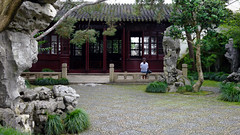
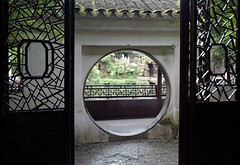
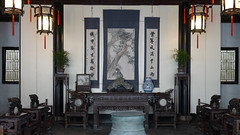
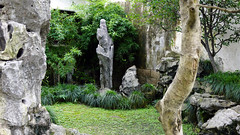
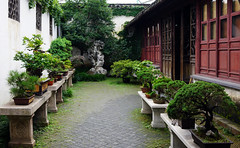
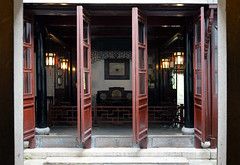
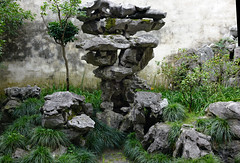
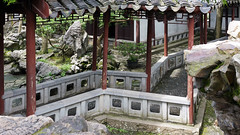
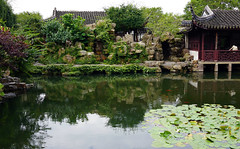
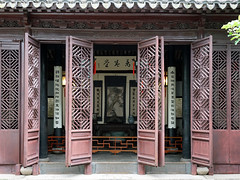
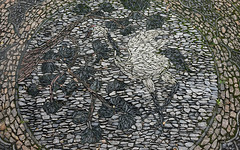
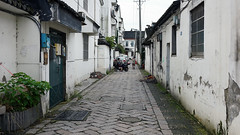
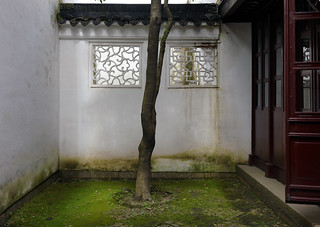
Liang Kai, Poet Strolling by a Marshy Bank
by THE METROPOLITAN MUSEUM OF ART
Video \(\PageIndex{9}\): Video from The Metropolitan Museum of Art
The art of the Yuan dynasty
During the Yuan dynasty, China became a part of the Mongol empire.
1271 - 1368
Zheng Sixiao, Ink Orchid
by HUNG SHENG
The artist
Known by the name he adopted in his late thirties, Zheng Sixiao painted Ink Orchid to evoke his sentiments at a tumultuous time in Chinese history.
Zheng was born in Fujian province in 1241, which was then part of the Southern Song empire (1127 – 1279). The capital of the Southern Song empire was Lin’an (present-day Hangzhou).
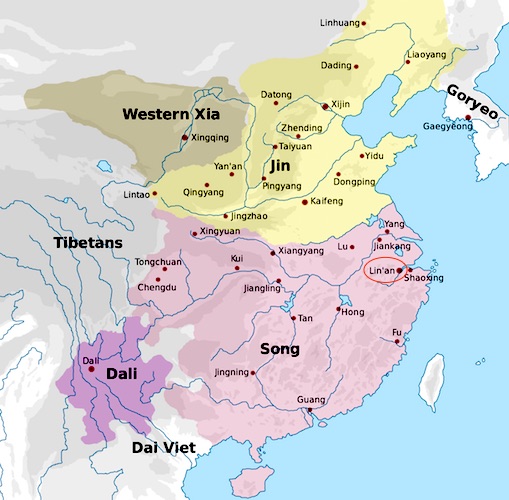
Zheng was a student of the Imperial Academy of the Southern Song. He was considered one of the literati, or the educated elite. In 1279, the Mongolian armies conquered the Southern Song empire. Zheng, a patriot, went to Suzhou (just north of Lin’an) where he lived the life of a hermit. The fall of the Southern Song prompted Zheng to rename himself. Indeed it was a common practice for literati to bestow on themselves several names. Zheng renamed himself Zheng Sixiao. Sixiao implied “remember the Zhao.” Zhao was the family name of the Song imperial family. The character for xiao 肖 was the same as the right side of the Chinese character for the word zhao 趙.
Zheng’s patriotism was also demonstrated in his choice of another name for himself. He signed this painting Suo-nan-weng, which means southern-facing old man. He was so patriotic that he never lay or sat facing to the north—where the Mongolian capital was located. Zheng was also given the courtesy name of Yiweng, meaning old man who reminisced about the fallen dynasty.
The only surviving painting reliably attributed to Zheng is the short horizontal scroll Ink Orchid, a balanced, tranquil, symbolic monochrome painting.

The subject matter
The orchid, the blossoming plum, the bamboo and the chrysanthemum each embodied traditional Chinese virtues. Known as the “Four Gentlemen,” the four plants were depicted by literati in different dynasties. The orchid with a faint, delicate fragrance grew in hidden and secluded places. Thus, the orchid can embody the characteristics of self-containment, reservation, simplicity, solitude and unpretentiousness. The description could also be used to describe how Zheng depicted himself. In Zheng’s Ink Orchid, there are no eye-catching colors or meticulous details. Precise calligraphic strokes rendered the simple and balanced composition. Zheng’s strokes depicted a few leaves and two orchid flowers. The deft use of brush and ink brings perspective, vitality and movement to the leaves and flowers. Unlike many western still life flower paintings, the ink orchid has no vase or basket.
There is also no depiction of roots. The orchid seems to float in the air. When people enquired as to why Zheng depicted it so, he was reported to have replied, “Don’t you know that the soil was stolen by the barbarians?” The rootlessness of the orchid added to the symbolism, for it connoted that Zheng was also without a home with the collapse of the Southern Song. Zheng became a yimin, a leftover subject. The rootless orchid was a personal statement of his refusal to serve the Yuan Mongolian court—a court ruled by the foreigners.
The inscriptions and seals
Zheng wrote a poem to the right of the orchid (fig. a), which expressed his bitterness at the fall of the Song. He compared himself to the orchid, emphasizing its faint, everlasting fragrance. He signed the poem with his pseudonym “South-facing Old Man” ( (fig. b). When he put the year and date, he denied the legitimacy of the Yuan dynasty by not noting its reign period (fig. c).

Zheng stamped two of his seals on the painting. One seal was his pseudonym matched with his signature (fig. d) while another was a longer text with four vertical lines starting from the right (fig. e). The latter hinted that he would not paint for the Yuan officials even if they asked. It was almost thirty years after the Song collapsed that Zheng painted the piece, yet all of these components signaled his remembrance of and unyielding loyalty to the Song and his enduring resistance to the Yuan.

Voids in the painting
When the painting was first created, it consisted merely of the orchid, the poem inscription at the right, the year and date indicated at the left and two of the seals at the lower left. In other words, the ink orchid exists in a void. The other inscriptions and seals were added by later literati and connoisseurs.
Leaving the background empty added great strength to the artwork. In the painting, the substance and the void complement each other. The void is not nothingness, but a space for imagination. Without details in the background, it also allows us to focus on the subject matter and inscription.
The rootless orchid lends insights into Zheng’s artistic skills and philosophy as well as aspects of his life. While conveying a strong statement by Zheng, the painting did not arouse anger or hatred but a sense of quietness. It elegantly embodied the modesty and integrity of this reclusive literati. Many subsequent literati appreciated and respected Zheng’s temperament and his depiction of the rootless orchid.
Buddha of Medicine Bhaishajyaguru (Yaoshi fo)
by DR. JENNIFER N. MCINTIRE and DR. STEVEN ZUCKER
Video \(\PageIndex{10}\): Buddha of Medicine Bhaishajyaguru (Yaoshi fo), c. 1319, Yuan dynasty, water-based pigments on clay mixed with straw, 24 feet, 8 inches x 49 feet 7 inches (751.8 cm x 1511.3 cm) (Metropolitan Museum of Art, New York)
Smarthistory images for teaching and learning:
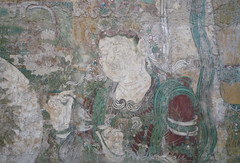
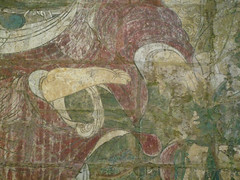
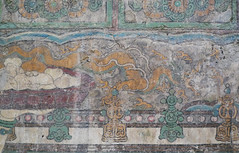
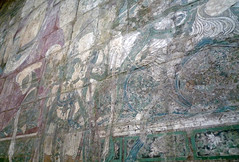
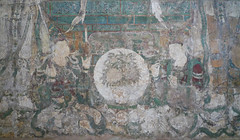

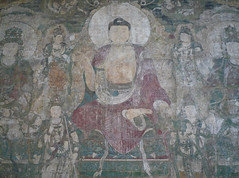
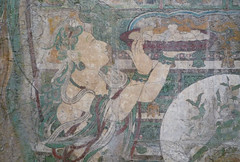
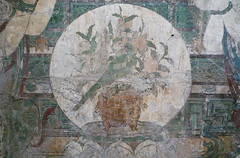
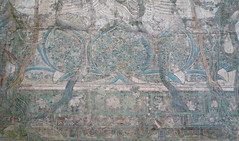
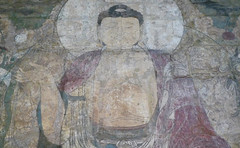
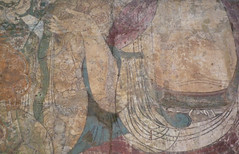
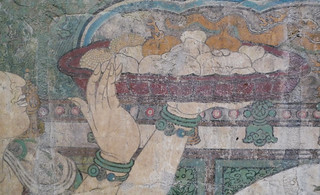
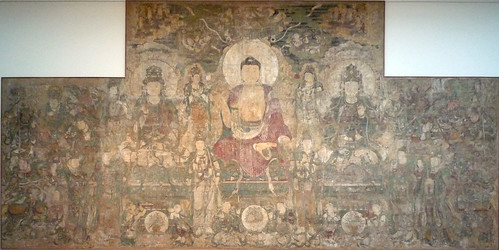
Huang Gongwang, Dwelling in the Fuchun Mountains
by HUNG SHENG


A story of survival
Dwelling in the Fuchun Mountains is a legendary shanshui (landscape) painting created by the Yuan dynasty painter, Huang Gongwang. This handscroll, which is over 22 feet long, has a fascinating history. There are many stories associated with it—there are even stories about the inscriptions that have been added to the scroll over the years.
As the story goes, the handscroll escaped destruction because a nephew disobeyed his uncle’s dying wish. In the late Ming dynasty, a collector named Wu Hongyu was so fond of this handscroll that he put it next to him while sleeping and eating, even carrying it when he fled in bare feet during the Manchu conquest. On his deathbed in 1650, Wu instructed his nephew to burn the handscroll so that it could accompany him into the afterlife. The handscroll started to burn. Fortunately, Wu’s quick-thinking nephew saved it by substituting another painting, unbeknownst to the near-death Wu.
This burning of the handscroll resulted in it being separated into two parts as it appears today. The first part, “The Remaining Mountain” is now in the Zhejiang Provincial Museum in Hangzhou while the latter part known as “The Master Wuyong Scroll” is in the National Palace Museum in Taipei where it has the status of a national treasure. The lengths of these scrolls vary greatly, the first part is 51.4 centimeters (a little more than 20 inches) and the latter is 636.9 centimeters (nearly 21 feet).
What is a Chinese handscroll painting?
Imagine you are hiking in a national park with a video camera. You film your progress on the hike with a range of camera shots: wide shots, medium shots, close ups, and so on. Appreciating a handscroll painting is similar to this visual journey.
Due to their horizontal format, you cannot view the entire handscroll all at once. Although museums often display handscrolls completely unrolled, from beginning to end, this is not the way artists intended for them to be experienced. Rather, they can be described as a slowly evolving journey of discovery that unfolds with intimate physical movement.
To view a handscroll one must begin by holding it in your hands. The handscroll is held by your left hand while the opening end of the handscroll is held by the right. The scroll is unrolled towards the left, shoulder width and at arms length so that the first section can be viewed. The right hand then rolls the start of the scroll to the left to re-roll the viewed section. The left hand then unrolls further towards the left until the new section is revealed for viewing. The right hand again re-rolls the viewed section. Section after section the process is repeated until the entire scroll is viewed. The process is then reversed to re-roll the entire scroll so that the first section is in correct position for the next viewing.
The subject

Dwelling in the Fuchun Mountains is a landscape painting. The journey starts with a robust mountain viewed from a high angle, looking at the lush vegetation and rocks. This is in “the Remaining Mountain” section of the scroll, which is the shorter of the two sections (image above).

We now move to “The Master Wuyong Scroll,” in which you experience the scenery of lower slopes (image above). There are different forms of trees in the lower half of the composition with lots of empty space.
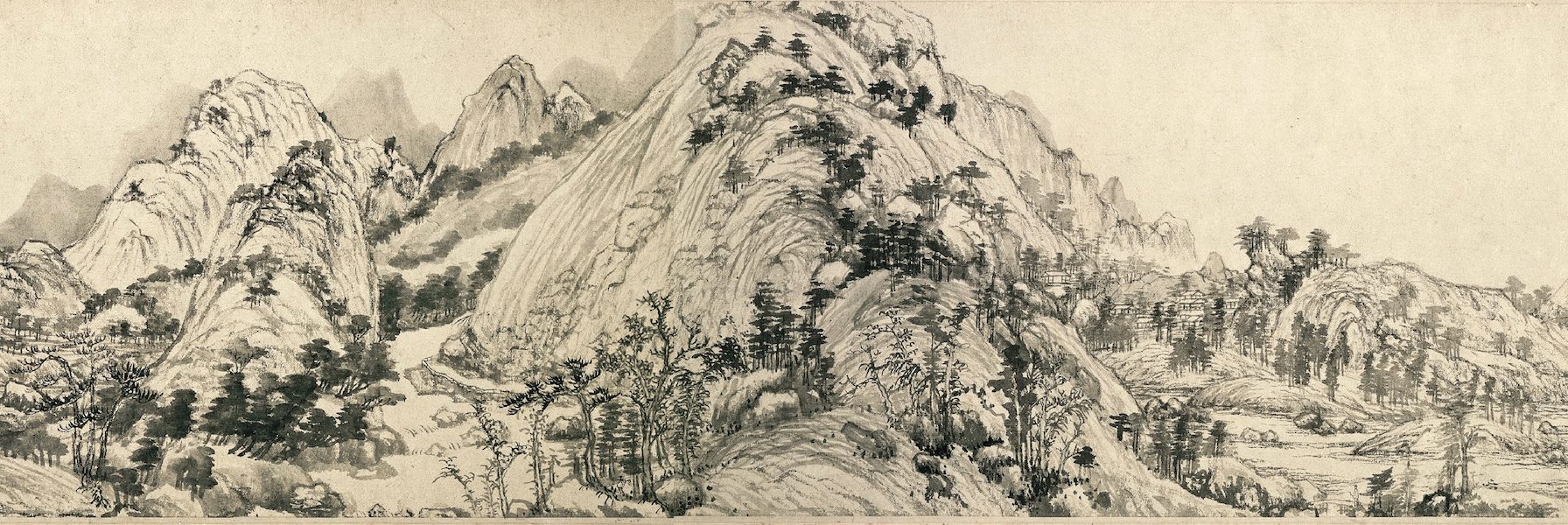
Gradually, after the vast initial view, your eye rises as if you are ascending to a point from which you can see farther to the distant mountains (image above). There is a spectacular panorama in front of you. There are rounded mountains with lush trees and grass, houses and paths in the valleys. Further on, we see a figure fishing in a boat, and to the left, under the shade of some trees in the foreground, we see pavilions beside water (image below).

Descending to a lower altitude, there is a nearby shore rendered in dry brushstrokes (on the far right) and groups of trees characterized by wet horizontal dots with great variations of ink tones (image below).

Approaching the end of the scroll, a majestic peak echoes the robust mountain that we saw at the very beginning of the scroll. In an elegant finale, the journey ends with low-lying mountains rendered in pale ink washes that taper into blank space (image below).

The format of the handscroll allows for multiple perspectives in the same painting, embracing the landscape’s breadth and depth along the river and mountains as a continuous journey progressing through time and space.
While landscape is a subject of both Chinese and Western art, they differ in their respective approaches. A Chinese landscape is not a visual record of a particular day or a single view, but rather it captures the flow of traveling through changes in atmosphere and multiple perspectives. According to Huang’s own inscription on the handscroll, it took him three to four years to finish the painting. It was not consciously constructed, but executed in a spontaneous state. Huang added to the painting when the mood was right, using six sections of paper to create “The Master Wuyong Scroll.” Huang did not paint for the court or the art market, but painted for himself as form of leisure and self-expression.
Who was Huang Gongwang?
Huang came from a poor family. His original surname was Lu. When he was around eight years old, he encountered Huang Le who was in his nineties and had always wanted to have a son. Following the custom of the day, Lu was adopted and changed his surname to Huang. After much study Huang became an official-scholar, but he later was embroiled in a dispute and imprisoned. After his imprisonment, he abandoned the thought of reaching a higher official rank and returned to his hometown in Changshu, Jiangsu province, where he lived as Daoist and traveled to nearby sites. In 1347, in his late seventies, Huang travelled to the Fuchun region accompanied by his Daoist friend, Zheng Wuyong. He began painting this handscroll at that time, and finally finished it in his eighties. What is Daoism?
Taoism (Daoism) is an indigenous Chinese religion. Tao is often translated as “way” or “path.” The teachings of Taoism advocate following the "way" and integrating with the natural world. Its legendary founder was Laozi, who lived in the sixth century B.C.E. However, most scholars believed that the real history of Taoism is rooted in indigenous religion of the second century and that it developed rapidly along with the advancement of Buddhism. Taoism developed its own unique meditation techniques. Taoists also had a particular interest in the pursuit of immortality and alchemy. As in the West, experiments in these pursuits led to unanticipated advances in chemistry and physics. (Zhaoyang Zhang, "Taoism in the Tang and Song dynasties," Khan Academy, www.khanacademy.org/partner-...ong-dynasties.).
Huang was a Han, an ethnic group of China. He also belonged to the social class of literati. The literati were educated elites who were interested in painting, calligraphy and poetry. Many literati in the Yuan dynasty, a dynasty founded by the Mongolians, were Han Chinese like Huang. They did not serve the non-Han court and lived a reclusive life. Painting to them was a kind of self-cultivation. Their intended audience was not the general public, but their circles of friends. Their paintings often emphasized the expression of the painters’ temperaments rather than visual resemblance to forms.
Methods and techniques
The handscroll was executed with brush and ink on paper. The use of brush and ink was thought to denote the artist’s spirit and temperament. The Dwelling in the Fuchun Mountains handscroll is a visual feast of methods and techniques, with bold tones and subtle shades, wet and dry brushwork, sparse and dense applications of ink, as well as the twists and turns of calligraphic lines.

Huang paid respect to earlier masters by appropriating the textural strokes they developed. For example, Huang used hemp-fiber textural strokes and alum-head textural strokes associated with the painters Dong Yuan and Juran (both of whom lived in the 10th century). The term “Alum head” is also used to describe the form of the boulders more generally. “Hemp-fiber” strokes refer to layers of long and thin strokes from the top to bottom of the mountain, while “alum-head” strokes shape the angular, small rocks on the top of the hills.

A place in Chinese art history
While respecting tradition and past masters, Huang’s handscroll created a dynamic composition and achieved a vitality that surpassed previous painters. Huang’s influence on later generations of literati painters was enormous. In the wider context of Chinese art history, his work is considered a national treasure.
Additional resources:
Dwelling in the Fuchun Mountains at the National Palace Museum
Brushstrokes: Styles and Techniques of Chinese Painting from the Asian Art Museum
About Daoism in the Tang and Song Dynasties
The David Vases
by DR. BETH HARRIS and DR. STEVEN ZUCKER
Video \(\PageIndex{11}\): The David Vases, 1351 (Yuan dynasty), porcelain, cobalt and clear glaze, 63.6 x 20.7 cm each, Jingdezhen, Jiangxi province, China (British Museum, London)
Smarthistory images for teaching and learning:


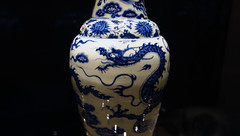
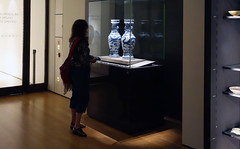
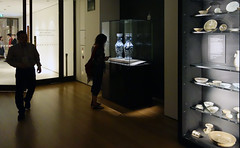
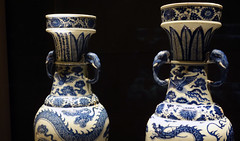
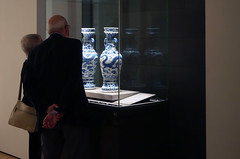
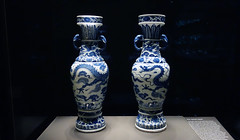
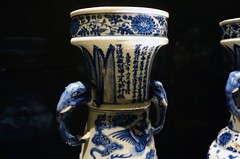
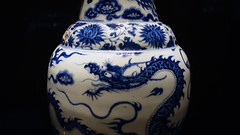
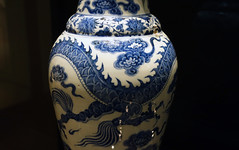
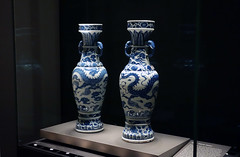
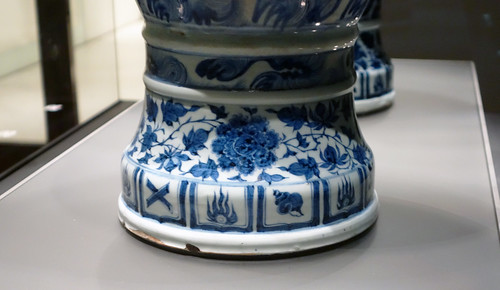
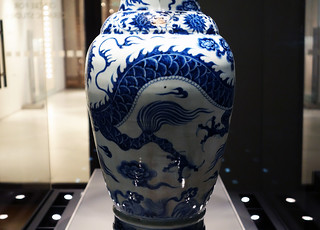
Ming dynasty (1368–1644)
A Ritual Ming dish
by JAN STUART, FREER GALLERY OF ART and DR. STEVEN ZUCKER
Video \(\PageIndex{12}\): A conversation with Jan Stuart, Melvin R. Seiden Curator of Chinese Art, Freer Gallery of Art and Arthur M. Sackler Gallery and Steven Zucker in front of Dish with copper-red glaze, Ming dynasty, porcelain with copper-red glaze; on the base, a six-character cobalt-oxide (blue reign mark in a double circle under colorless glaze), c. 1426-35, 4.6 x 22 cm (Freer Gallery of Art, Smithsonian Institution, Washington D.C.: Purchase — Charles Lang Freer Endowment and Friends of the Freer and Sackler Galleries, F2015.2a-b)
Additional resources:
The Forbidden City
Video \(\PageIndex{13}\): Video from the Asian Art Museum.

The Forbidden City is a large precinct of red walls and yellow glazed roof tiles located in the heart of China’s capital, Beijing. As its name suggests, the precinct is a micro-city in its own right. Measuring 961 meters in length and 753 meters in width, the Forbidden City is composed of more than 90 palace compounds including 98 buildings and surrounded by a moat as wide as 52 meters.

The Forbidden City was the political and ritual center of China for over 500 years. After its completion in 1420, the Forbidden City was home to 24 emperors, their families and servants during the Ming (1368–1644) and the Qing (1644–1911) dynasties. The last occupant (who was also the last emperor of imperial China), Puyi (1906–67), was expelled in 1925 when the precinct was transformed into the Palace Museum. Although it is no longer an imperial precinct, it remains one of the most important cultural heritage sites and the most visited museum in the People’s Republic of China, with an average of eighty thousand visitors every day.

Construction and layout
The construction of the Forbidden City was the result of a scandalous coup d’état plotted by Zhu Di, the fourth son of the Ming dynasty’s founder Zhu Yuanzhang, that made him the Chengzu emperor (his official title) in 1402. In order to solidify his power, the Chengzu emperor moved the capital, as well as his own army, from Nanjing in southeastern China to Beijing and began building a new heart of the empire, the Forbidden City.

The establishment of the Qing dynasty in 1644 did not lessen the Forbidden City’s pivotal status, as the Manchu imperial family continued to live and rule there. While no major change has been made since its completion, the precinct has undergone various renovations and minor constructions well into the twentieth-first century. Since the Forbidden City is a ceremonial, ritual and living space, the architects who designed its layout followed the ideal cosmic order in Confucian ideology that had held Chinese social structure together for centuries. This layout ensured that all activities within this micro-city were conducted in the manner appropriate to the participants’ social and familial roles. All activities, such as imperial court ceremonies or life-cycle rituals, would take place in sophisticated palaces depending on the events’ characteristics. Similarly, the court determined the occupants of the Forbidden City strictly according to their positions in the imperial family.

The architectural style also reflects a sense of hierarchy. Each structure was designed in accordance with the Treatise on Architectural Methods or State Building Standards (Yingzao fashi), an eleventh-century manual that specified particular designs for buildings of different ranks in Chinese social structure.

Public and private life
Public and domestic spheres are clearly divided in the Forbidden City. The southern half, or the outer court, contains spectacular palace compounds of supra-human scale. This outer court belonged to the realm of state affairs, and only men had access to its spaces. It included the emperor’s formal reception halls, places for religious rituals and state ceremonies, and also the Meridian Gate (Wumen) located at the south end of the central axis that served as the main entrance.

Upon passing the Meridian Gate, one immediately enters an immense courtyard paved with white marble stones in front of the Hall of Supreme Harmony (Taihedian). Since the Ming dynasty, officials gathered in front of the Meridian Gate before 3 a.m., waiting for the emperor’s reception to start at 5 a.m.


While the outer court is reserved for men, the inner court is the domestic space, dedicated to the imperial family. The inner court includes the palaces in the northern part of the Forbidden City. Here, three of the most important palaces align with the city’s central axis: the emperor’s residence known as the Palace of Heavenly Purity (Qianqinggong) is located to the south while the empress’s residence, the Palace of Earthly Tranquility (Kunninggong), is to the north. The Hall of Celestial and Terrestrial Union (Jiaotaidian), a smaller square building for imperial weddings and familial ceremonies, is sandwiched in between.

Left: Palace of Earthly Tranquility (Kunninggong)
Center: Hall of Celestial and Terrestrial Union (Jiaotaidian)
Right: Palace of Heavenly Purity (Qianqinggong)
Although the Palace of Heavenly Purity was a grand palace building symbolizing the emperor’s supreme status, it was too large for conducting private activities comfortably. Therefore, after the early 18th century Qing emperor, Yongzheng, moved his residence to the smaller Hall of Mental Cultivation (Yangxindian) to the west of the main axis, the Palace of Heavenly Purity became a space for ceremonial use and all subsequent emperors resided in the Hall of Mental Cultivation.

The residences of the emperor’s consorts flank the three major palaces in the inner court. Each side contains six identical, walled palace compounds, forming the shape of K’un “☷,” one of the eight trigrams of ancient Chinese philosophy. It is the symbol of mother and earth, and thus is a metaphor for the proper feminine roles the occupants of these palaces should play. Such architectural and philosophical symmetry, however, fundamentally changed when the empress dowager Cixi (1835-1908) renovated the Palace of Eternal Spring (Changchungong) and the Palace of Gathered Elegance (Chuxiugong) in the west part of the inner court for her fortieth and fiftieth birthday in 1874 and 1884, respectively. The renovation transformed the original layout of six palace compounds into four, thereby breaking the shape of the symbolic trigram and implying the loosened control of Chinese patriarchal authority at the time.

The eastern and western sides of the inner court were reserved for the retired emperor and empress dowager. The emperor Qianlong (r. 1735–96) built his post-retirement palace, the Hall of Pleasant Longevity (Leshoutang), in the northeast corner of the Forbidden City. It was the last major construction in the imperial precinct. In addition to these palace compounds for the older generation, there are also structures for the imperial family’s religious activities in the east and west sides of the inner court, such as Buddhist and Daoist temples built during the Ming dynasty. The Manchus preserved most of these structures but also added spaces for their own shamanic beliefs.

The Forbidden City now
Today, the Forbidden City is still changing. As a modern museum and an historical site, the museum strikes a balance by maintaining the structures and restoring the interiors of the palace compounds, and in certain instances transforming minor palace buildings and hallways into exhibition galleries for the exquisite artwork of the imperial collections. For many, the Forbidden City is a time capsule for China’s past and an educational institute for the public to learn and appreciate the history and beauty of this ancient culture.
Essay by Dr. Ying-chen Peng
Qing dynasty (1644-1912)
Bada Shanren, Lotus and Ducks
by STEPHEN D. ALLEE, FREER GALLERY OF ART and DR. STEVEN ZUCKER
The angry ducks of Bada Shanren.
Video \(\PageIndex{14}\): Bada Shanren 八大山人 (朱耷), Lotus and Ducks (colophon by Wu Changshuo 吳昌碩), c. 1696 (Qing dynasty), ink on paper (hanging scroll), image 185 x 95.8 cm (Freer Gallery of Art and Arthur M. Sackler Gallery, Smithsonian Institution). Speakers: Stephen D. Allee, Associate Curator for Chinese Painting and Calligraphy, Freer Gallery of Art and Arthur M. Sackler Gallery, Smithsonian Institution and Steven Zucker.
Additional resources:
Smarthistory images for teaching and learning:
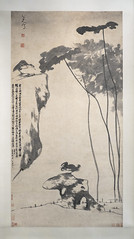
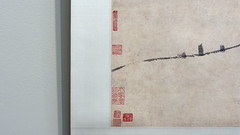
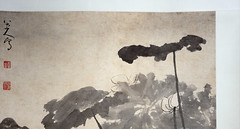
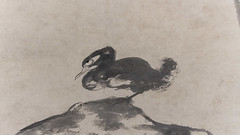

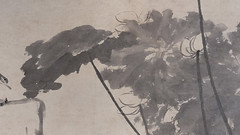
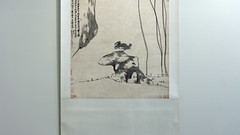

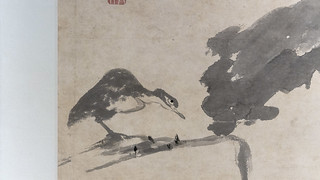
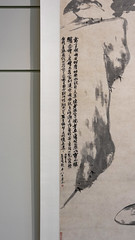
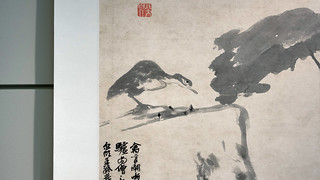
The European Palaces of the Qianlong Emperor, Beijing
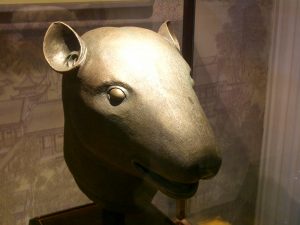
A controversial auction
In 2009, two eighteenth-century Chinese bronze sculptures — one representing a rat’s head and the other a rabbit’s — sold at a Christie’s auction in Paris for $40.4 million. Soon afterwards, the art world watched, stunned, as the winning bidder, Cai Mingchao, announced at a press conference in Beijing that he had no intention of actually paying for the sculptures. Cai, a consultant for a group that seeks the return of Chinese artifacts, had intentionally sabotaged the auction as an act of patriotic protest. His bids on these bronze sculptures were intended to prevent the international sale of works of art that Cai and many Chinese citizens consider important artifacts of their cultural heritage.
However, when we examine the history of these sculptures’ creation and the original context in which they were displayed, the issue becomes more complex. No matter where a person stands in the debate, it is important to acknowledge that these works — rather than being purely Chinese — represent an artistic encounter between East and West, marking a moment in Chinese history when the ruling dynasty was extraordinarily active in the collecting, display, and creation of European and European-style art.
The Garden of Eternal Spring
The rat and rabbit heads were originally created for the Garden of Eternal Spring, an enormous Qing Dynasty (1636-1912) garden northwest of the Forbidden City in Beijing, commissioned in the mid-eighteenth century by the Qianlong emperor (Qianlong was the sixth Emperor of the Qing dynasty). It was one of three large imperial gardens — The Garden of Perfect Brightness (Yuanming Yuan), the Garden of Eternal Spring (Changchun Yuan), and the Garden of Elegant Spring (Qichun Yuan). Today, these gardens are collectively referred to as the Yuanming Yuan, despite the fact that they were distinct construction projects.
These gardens are also sometimes called the “Old Summer Palace” in English, which inaccurately implies that this was a place of leisurely summer retreat, secondary in importance to the Forbidden City. In reality, the gardens were the primary residences of the Qing emperors for most of the eighteenth and nineteenth centuries. The Garden of Eternal Spring was begun in 1749 and consisted of hundreds of acres of pavilions, palaces, landscaping, artificial hills, and water features. When one of the few privileged guests who were allowed to view the palaces arrived in the northern section of this vast complex, a surprise awaited. Here, they would suddenly encounter a sequence of stone buildings done in a hybrid Chinese-European style, known as the Xiyang Lou, or “European Palaces.”
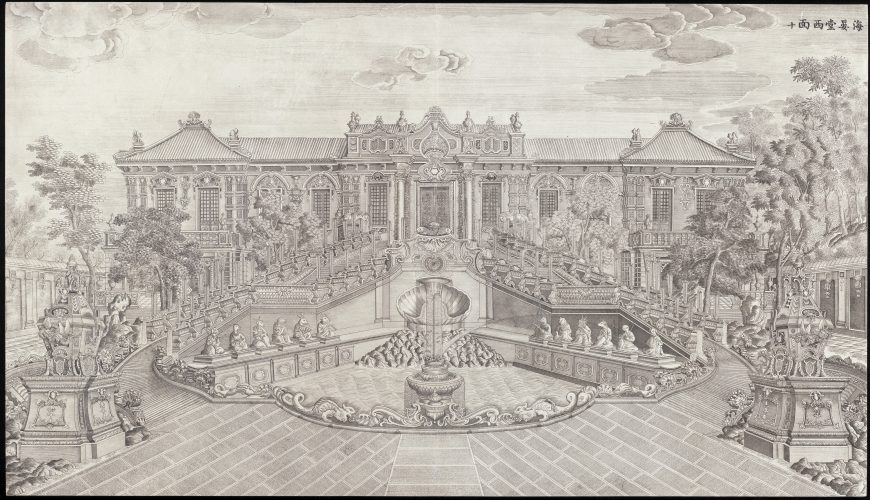
The European Palaces were the result of a collaboration between the Qianlong emperor and a group of European Jesuit missionaries who were working at the Qing court as painters, botanists, mathematicians, and astronomers. The Jesuits are a Roman Catholic religious order founded during the 16th century who had been active as missionaries in China. Christianity had been outlawed during the reign of the Qianlong emperor’s father, however, small number of Jesuits remained in China solely as servants to the emperor and subject to his command.
In the 1740s, one of these Jesuits showed the Qianlong emperor engravings of the fountains at Versailles, the principal royal residence in eighteenth-century France. Fascinated, the Chinese emperor commissioned an Italian Jesuit painter named Giuseppe Castiglione, known as Lang Shining in China, to oversee the construction of a similar fountain. Eventually this project dramatically expanded from a single fountain to an entire complex of palaces, scenic views, and waterworks. Although the European Palaces are usually attributed to Castiglione alone, he actually collaborated on this project with the prolific Lei family of imperial Chinese architects and with other Jesuits at court, including a hydraulics expert and mathematician named Michel Benoist.
A landscape full of surprises
According to traditional Chinese garden design, a garden should include discrete scenes that are sequentially revealed to the visitor as they traverse the landscape. Each view should contain an unexpected element that would astonish the viewer in its creativity and cleverness. The European Palaces, despite their foreign appearance, are fully in line with this tradition. A wall enclosed the section of the garden where the European palaces were; only the tall roofs of the structures, covered in traditional Chinese ceramic tiles, were visible from the rest of the garden. The viewer would have no reason to suspect that the buildings were unusual until they passed through the gate and suddenly encountered this fantastical vision of Europe.
As visitors traveled through the palace complex, it continuously concealed and revealed surprises. For example, the Aviary, which held the emperor’s menagerie of peacocks and exotic birds, appeared to be entirely Chinese in design from the western façade; however, after the visitor exited the Aviary on the eastern side, they would look back over their shoulder to see a curved façade done in an exuberant European Rococo style. It would have appeared to them as if they had entered the building in China and exited in Europe.
Another visual trick was placed at the far eastern end of the European Palaces section. After descending from the Hill of Linear Perspective, the visitor would get on a boat to cross the Square Lake. On the eastern shore of the lake, Castiglione had painted twelve illusionistic scenes using European linear perspective. These paintings were meant to fool the viewer into thinking that an entire European city street had been constructed in the garden.
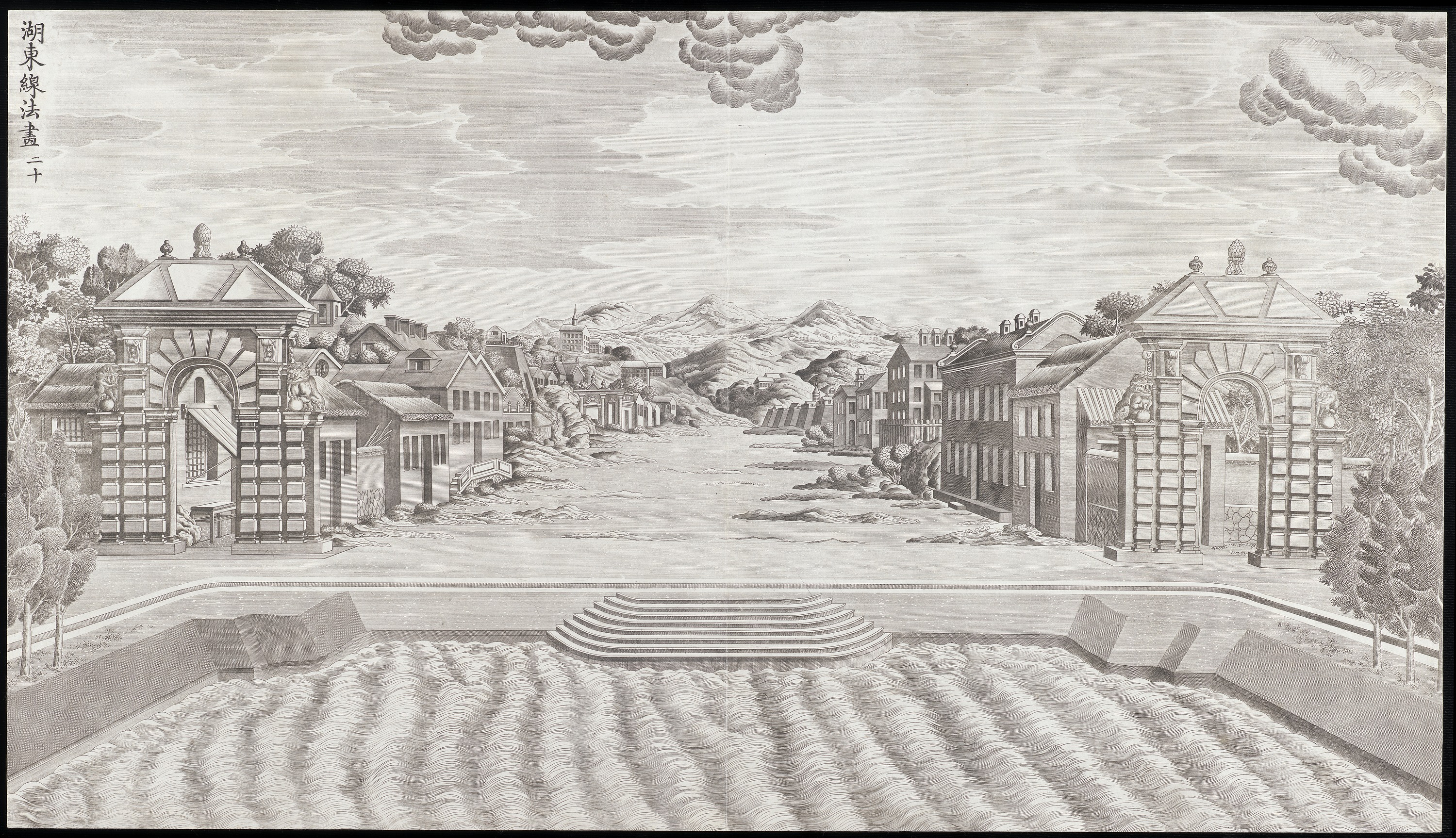
Collecting Europe

The Qianlong emperor never actually lived in any of the European palaces and neither did any of his consorts, as has sometimes been asserted. Instead, the function of the European palaces was to hold his enormous collections of European and European-style objects. Some of these treasures were given to the emperor as diplomatic gifts by European monarchs, while others were imported from the West or even created in China as imitations of European luxury goods.
For example, the emperor ordered the construction of a new palace, the Distant Waters Observatory, specifically to display a set of Beauvais tapestries gifted to the emperor by King Louis XV of France. Interestingly, these tapestries, designed by François Boucher, depicted imaginary scenes of China. This was a unique situation in which a European artist’s vision of Asia was hung in a fantastical European architectural setting commissioned by a Chinese emperor.
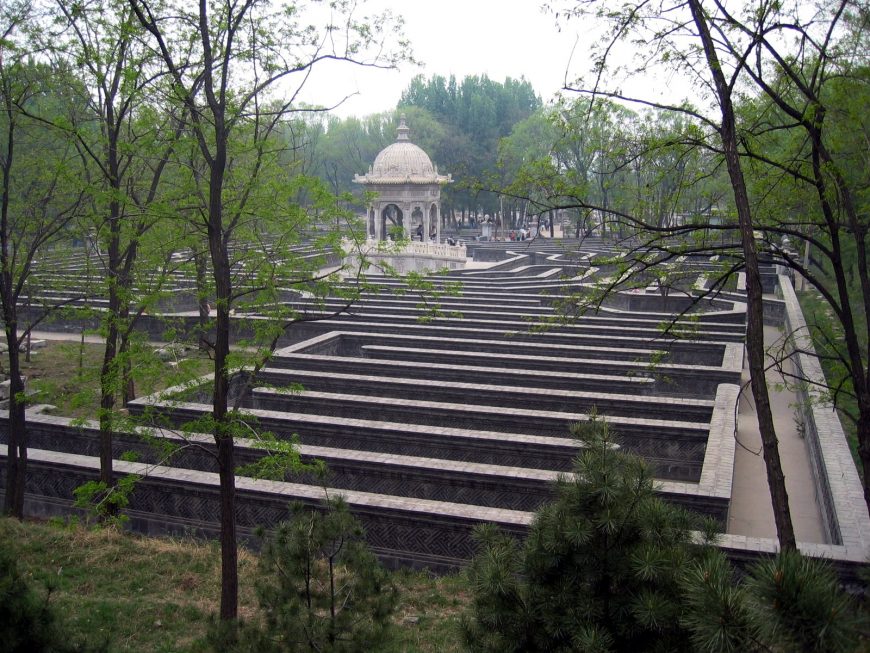
The Qianlong emperor also had a particular interest in European technology like clocks and automata. In the garden maze (in Chinese, “The Garden of Ten Thousand Flowers”), the first to be built in China, there was a marble building that housed a collection of bird automata that could sing, as well as a large music box that had been brought from Europe.
An automaton is a mechanical device that seemingly moves on its own and mimics the actions of human figures or animals.
The fountains constructed throughout the garden form another collection of European-style machines and are particularly impressive from both an aesthetic and engineering point of view. The fountain in front of the Hall of Calm Seas included an ingenious water clock comprised of sculptures depicting the twelve animals of the Chinese zodiac, including the rat and rabbit sculptures auctioned in 2009. Each animal was associated with a particular two-hour period of the day and water would shoot from the animal’s mouth during the appropriate time. At noon each day, water would spout from all of the animals at once. Even though these fountains were constructed using European hydraulics, their imagery was adapted to suit Chinese taste. For example, nude figures commonly decorated fountains in Europe, but were not used in the Garden of Eternal Spring. Instead, the fountains’ iconography referenced Chinese traditions, such as the animals of the zodiac, as well as other mythological stories and Daoist parables.
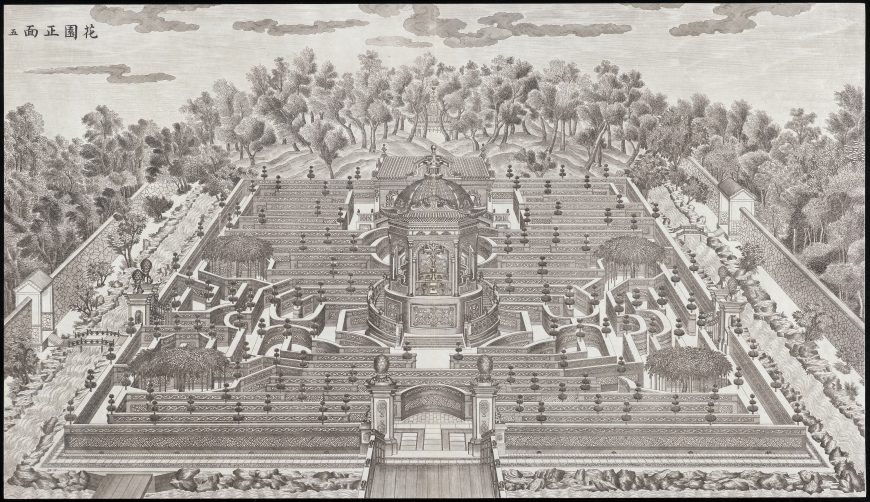
The European Palaces are often interpreted as expressions of the Qianlong emperor’s power. Chinese emperors throughout history have viewed themselves as having a mandate to rule everything “under Heaven” (meaning, the entire world). Several scholars have connected this idea to the European palaces, asserting that the appropriation of European architecture and technology in the Garden of Eternal Spring was meant to be seen as a visual demonstration of Qing superiority over Europe and Qianlong’s dominion over the known world. However, a recent alternative interpretation proposes that the Qianlong emperor was not interested in literally colonizing Europe. Instead, we should view his European Palaces as a means of “collecting” Europe. The emperor and his rare guests were always aware that the built structures in the garden were a fantasy of Europe conjured up at the emperor’s command, demonstrating his mastery over reality itself. [1]
The aftermath
The glory days of the European palaces did not last long. Fortunately, the Qianlong emperor had commissioned Ilantai, a Manchu artist who had trained under Castiglione, to make copperplate engravings of the palaces. Without these engravings, it would be impossible to reconstruct the appearance of the garden, which was looted and badly damaged by British and French troops during the Second Opium War in 1860. In China, the stone ruins of the European palaces now symbolize the late nineteenth- and early twentieth-century history of the country, a time of domination by external imperial powers. Art collectors and government officials often invoke this history when discussing the need to repatriate objects looted from the imperial gardens of Beijing.
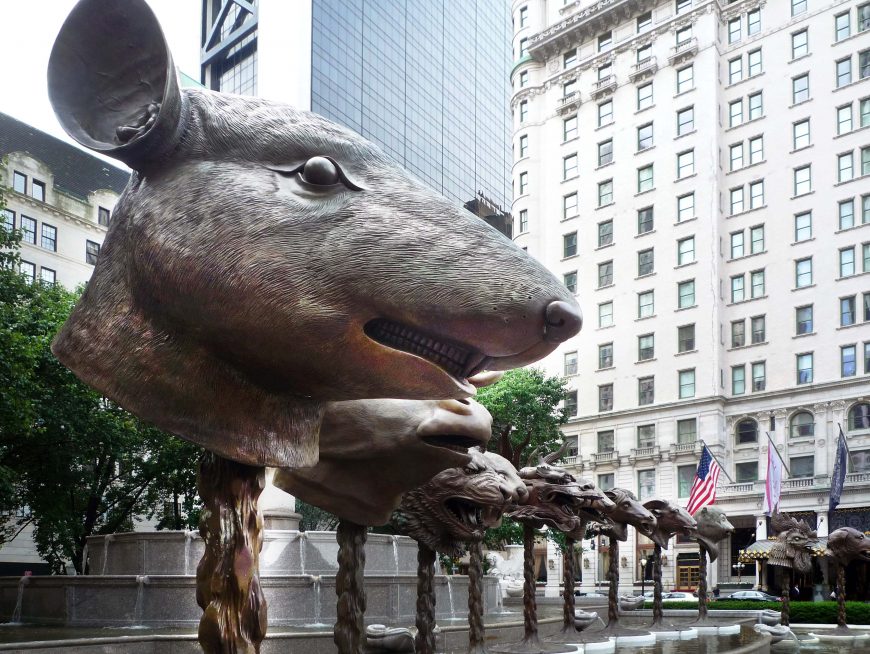
Others, however, remember the European palaces as a place of cross-cultural interaction. Ai Weiwei created Circle of Animals/Zodiac Heads in 2010 as a reaction to the 2009 auction of the rat and rabbit head. He reimagined the heads of all twelve zodiac animals from the water clock of the Hall of Calm Seas and has displayed these recreations in public venues all over the world. In interviews, Ai Weiwei has questioned the Chinese narrative about the zodiac heads, recalling the complex multicultural aspects of the Qianlong emperor’s commission:
I don’t think the zodiac heads are a national treasure. They were designed by an Italian, made by a Frenchman for a Qing-dynasty emperor who was the ruler of China, but the Manchus of the Qing dynasty actually invaded China. So, if we talk about national treasure, what nation are we talking about?“Ai Weiwei: Interview Excerpts” in Ai Weiwei, Circle of Animals, Zodiac Heads, ed. S. Delson (New York: AW Asia, 2011), p. 42
Notes
[1] Kristina Kleutghen, Imperial Illusions: Crossing Pictorial Boundaries in the Qing Palaces (Seattle: University of Washington Press, 2015).
Additional Resources
Kristina Kleutghen, Imperial Illusions: Crossing Pictorial Boundaries in the Qing Palaces (Seattle: University of Washington Press, 2015).
The full set of Yi Lantai’s twenty engravings of the European Palaces from Getty Digital Collections
Susan Delson, ed., Ai Weiwei: Circle of Animals (New York: AW Asia, 2011).
Lillian M. Li, “The Garden of Perfect Brightness” on MIT’s Visualizing Cultures – Part 1 (https://visualizingcultures.mit.edu/garden_perfect_brightness/index.html) and Part 2 (https://visualizingcultures.mit.edu/garden_perfect_brightness_02/ymy2_essay01.html)
Marco Musillo, The Shining Inheritance: Italian Painters at the Qing Court, 1699-1812 (Los Angeles: Getty Publications 2016).
Richard E. Strassberg, “War and Peace: Four Intercultural Landscapes” in China on Paper: European and Chinese Works from the Late Sixteenth to the Early Nineteenth Century (Los Angeles: Getty Publications 2011), pp. 89-137.
Greg M. Thomas, “Yuanming Yuan/Versailles: Intercultural Interactions between Chinese and European Palace Cultures,” Art History vol. 32, no. 1 (2009), pp. 115-143.
The People’s Republic of China
The People's Republic of China was established after World War II. At first a strict Communist regime that looked to directly control art production as a mode of propaganda, since the 1980s, China has opened up to more diverse practices.
1949 - present
Liu Chunhua, Chairman Mao en Route to Anyuan

Striding atop a mountain peak wearing a look of determination on his face, Chairman Mao en Route to Anyuan shows a young Mao Zedong (Chinese Communist revolutionary, founding father of the People’s Republic of China, and leader of China from 1949-76) ready to weather any storm. In picturing a moment in Chinese Communist Party history, Liu Chunhua celebrated Chairman Mao (then in his seventies) and his longstanding commitment to Communist Party ideals. Painted in 1967 at the dawn of the Great Proletarian Cultural Revolution, this work uses socialist realism to portray Chairman Mao as a revolutionary leader committed to championing the common people.
Socialist realism and Mao paintings

During the Cultural Revolution (1966-76), artists focused on creating portraits of Mao, or “Mao paintings,” which represented Mao’s effort to regain his hold after bitter political struggles within the party. With the leadership of Mao’s last wife, Jiang Qing, the movement aimed to quell criticisms of Mao in drama, literature, and the visual arts. More broadly, it aimed to correct political fallout from the disasters of the 1950s, especially the widespread famine and deaths that resulted from the Great Leap Forward (an attempt from 1958–61 to rapidly modernize China, transforming it from an agrarian economy into an industrialized, socialist society), and reinvigorate Communist ideology in general. In the years that followed, Mao would lead the country through a decade of violent class struggles aimed at purging traditional customs and capitalism from Chinese society.
In the early years of the Cultural Revolution, artists such as Liu Chunhua turned to a style known as socialist realism for creating portraits of Mao Zedong. Socialist realism was introduced to China in the 1950s in order to address the lives of the working class. Suitable for propaganda, socialist realism aimed for clear, intelligible subjects and emotionally moving themes. Subjects often included peasants, soldiers, and workers—all of whom represented the central concern of Mao Zedong and the Communist Party. Modeled after works in the Soviet Union, paintings in this style were rendered in oil on canvas. They notably departed from Chinese hanging scrolls in ink and paper, such as Li Keran’s Ten Thousand Crimson Hills, painted in 1964 (left).
Standardized by the Central Propaganda Department, Mao paintings typically pictured the Chinese leader in an idealized fashion, as a luminous presence at the center of the composition. Unlike Chairman Mao en Route to Anyuan, portraits usually depicted Mao among the people, such as strolling through lush fields alongside smiling peasants.
The Anyuan Miners’ Strike of 1922
Chairman Mao en Route to Anyuan presents a critical moment in Chinese Communist Party history: Mao marching toward the coal mines of Anyuan, Jiangxi province in south-central China, where he was instrumental in organizing a nonviolent strike of thirteen thousand miners and railway workers. Occurring only a year after the founding of the Chinese Communist Party, the Anyuan Miners’ Strike of 1922 was a defining moment for the Chinese Communist Party because the miners represented the suffering of the masses at the heart of the revolutionary cause. Many of the miners enlisted as soldiers in the Red Army (the army of the Chinese Communist Party), intent on following the young Mao toward revolution.

Painting nearly half a century after the Anyuan Miners’ Strike, Liu Chunhua created Chairman Mao en Route to Anyuan for a national exhibition. Liu Chunhua was a member of the Red Guard, or the group of radical youth whose mission was to attack the “four olds” (customs, habits, culture, and thinking). To create this painting, he studied old photographs of Mao and visited Anyuan to interview workers for visual veracity. Based on his findings, he rendered Mao wearing a traditional Chinese gown rather than Western attire, which is more commonly seen in portraits of Mao created during the Cultural Revolution. The cool color tonalities of Chairman Mao en Route to Anyuan also differ from other Mao paintings, which tended toward warm tones with clear, blue skies, such as Chen Yanning’s Chairman Mao Inspects the Guangdong Countryside (below). Others often featured vibrant red accents—red being the color of revolution. Instead, Liu Chunhua opted for deep blue and purple hues to capture Mao’s determination as he marched to address the plight of those suffering.

In Chairman Mao en Route to Anyuan, Liu Chunhua adapted Chinese landscape conventions to a new style and purpose—an evocative portrayal that suggested that Mao was capable of leading the country toward revolution. He pictured his subject emerging atop a mountain with clouds of mist below. In China, landscapes such as this often evoked immortal realms, or extraordinary sites invested with the misty vapors of the mountain. However, a telephone pole is discernable in the lower left corner of the composition, and water cascades from a dam in the right—hints of modernity within the ethereal landscape. With an umbrella tucked beneath one arm and the other hand clenched into a fist, and wearing windswept robes, Mao appears superhuman, yet also practical and charismatic.
As a prominent icon in the Cultural Revolution, Chairman Mao en Route to Anyuan celebrated the grassroots nature of revolutionary history and cultivated devotion to Mao during a tumultuous time. As a brilliant example of Chinese Communist Party propaganda, it was reportedly reproduced over 900 million times, and distributed widely in print, sculpture, and other media.
Additional resources:
This painting on Art Through Time
Melissa Chiu and Zheng Shengtian, Art and China’s Revolution (New York: Asia Society, 2008).
Elizabeth J. Perry, Anyuan Mining China’s Revolutionary Tradition (Berkeley: University of California Press, 2012).
Ai Weiwei, Kui Hua Zi (Sunflower Seeds)
Video \(\PageIndex{15}\): Video from Tate
Subversive seeds
Ai Weiwei often uses his art to critique political and economic injustice. This can be seen in work such as his 2010 installation, Kui Hua Zi (Sunflower Seeds) at Tate Modern, London.

Kui Hua Zi (Sunflower Seeds) consists of more than 100 million tiny, handmade porcelain sunflower seeds, originally weighing in at 150 tons. They filled the enormous Turbine Hall at Tate Modern, an industrial building-turned-contemporary art space. Sunflower seeds evoke a warm personal memory for the artist, who recalls that while he was growing up, even the poorest in China would share sunflower seeds as a treat among friends. The use of sunflower seeds as the basis of his installation was also designed to subvert popular imagery rooted in the artist’s childhood. Communist propaganda optimistically depicted leader Mao Zedong as the sun and the citizens of the People’s Republic of China as sunflowers, turning toward their chairman. Ai Weiwei reasserts the sunflower seed as a symbol of camaraderie during difficult times.

Though each of the 100 million carefully crafted individual seeds can draw the viewer’s attention, once arranged together in a neat rectangle, or covering the floor of an entire room, the hyper-realistic seeds create a sense of vastness. In the Tate installation, there was a sense of precision in the arrangement of the seeds, creating visual order and uniformity. The individual seed is lost among the millions, a critique of the conformity and censorship inherent in modern China.

Made In China
More than 1,600 artisans worked to make the individual porcelain seeds by hand in Jingdzhen, the city known as the “Porcelain Capital,” where artists have been producing pottery for nearly 2000 years. Porcelain, first produced during the Han dynasty in about 200 B.C.E. and later mastered during the Tang dynasty, is made by heating white clay (kaolin) to a temperature over 1200 degrees Celsius. The fusion of the particles within the clay during firing allowed artists to create vessels with thin but strong walls. Porcelain— a symbol of imperial culture in China—was also made for export via the Silk Road and became important to the creation of the idea of China in the West.

Ai Weiwei’s use of porcelain comments on the long history of this prized material while also rejecting the common negative connotations of the modern term “Made in China.” Utilizing skilled artisans known for their exquisite craftsmanship to make objects that can only be differentiated one from another upon close inspection, alludes to the important porcelain tradition in Jingdzhen, as well as to the uniformity and diffusion of modern (cheap and fast) labor that is responsible for China’s hard-won place in the world economy. Sunflower Seeds asks us to examine how our consumption of foreign-made goods affects the lives of others across the globe.

How we experience an artwork impacts our perception of the work. In the tradition of participatory contemporary art, Sunflower Seeds asks the public to physically interact with the art. Initially, Tate visitors were invited to walk over and lie on the seeds, though the museum, in consultation with the artist, suspended this opportunity about a week into the exhibition because of safety concerns.
Art and activism
Ai Weiwei was arrested at the Beijing Capital International Airport on April 3, 2011 during his Tate exhibition.[1] He was detained for 81 days. The artist, along with many in the international community, asserted that his true offense was his political activism for democracy and human rights. Ai Weiwei had blogged for four years—investigating cover-ups and corruption in the government’s handling of a devastating 2008 earthquake in Sichuan and the country’s hosting of the Olympics. Ai Weiwei’s blog was shut down in 2009. Since then, he has turned to Twitter and Instagram. During his detention, the international community, including major US art institutions, rallied for his release. Officials eventually released him, charging Ai Weiwei with tax evasion, but his passport was withheld, preventing him from leaving the country for four years. It was returned in 2015.
Ai Weiwei continues to address issues of human rights in his work. The 2015 exhibit @Large, installed on Alcatraz, the former island prison in the San Francisco Bay, comments on surveillance, freedom, and political prisoners by mixing fine and traditional arts with pop culture materials including silk dragon kites and Lego portraits (above).
[1] Andrew Jacobs, “China Takes Dissident Artist Into Custody,” The New York Times, 4/3/11, A4
Additional resources:
You can follow Ai Weiwei on Instagram and Twitter @aiww
More information on Ai Weiwei’s Sunflower Seeds
Sunflower Seeds exhibition at the Tate
Ai Weiwei, Remembering and the Politics of Dissent
by JP MCMAHON

Dangerous Art
All art is political in the sense that all art takes place in the public arena and engages with an already existing ideology. Yet there are times when art becomes dangerously political for both the artist and the viewers who engage with that art. Think of Jacques-Louis David’s involvement in the French Revolution—his individual investment in art following the bloodshed —and his imprisonment during the reign of terror. If it were not for certain sympathisers, David may well have ended up another victim of the guillotine. Goya is another example of an artist who fell foul of government power. There are instances in the 20th century when artists have faced down political power directly. Consider the photomontages of John Heartfield. Heartfield risked his life at times to produce covers for the magazine A/Z, which defied both Hitler and the Nazi Party.
Ai Weiwei
The Chinese artist, Ai Weiwei, offers is an important contemporary example. In 2011, Weiwei was arrested in China following a crack down by the government on so-called “political dissidents” (a specific category that the Chinese government uses to classify those who seek to subvert state power) for “alleged economic crimes” against the Chinese state. Weiwei has used his art to address both the corruption of the Chinese communist government and its outright neglect of human rights, particularly in the realm of the freedom of speech and thought. Weiwei has been successful in using the internet (which is severely restricted in China) as a medium for his art. His work is informed by two interconnected strands, his involvement with the Chinese avant-garde group “Stars” (which he helped found in 1978 during his time in the Beijing Film Academy) and the fact that he spent some of his formative years in New York, engaging there with the ideas of conceptual art, in particular the idea of the readymade. Many of the concepts and much of the material that Weiwei uses in his art practice are informed by post-conceptual thinking.

An International Audience

Weiwei has exhibited successfully in the West in many major shows, for example, the 48th Venice Biennale in Italy (1999) and Documenta 12 (2007). He also exhibited Sunflower Seeds (October, 2010) in the Turbine Hall in the Tate Modern. In this work, Weiwei filled the floor of the huge hall with one hundred million porcelain seeds, each individually hand-painted in the town of Jingdezhen by 1,600 Chinese artisans. Participants were encouraged to walk over the exhibited space (or even roll in the work) in order to experience the ideas of the effect of mass consumption on Chinese industry and 20th-century China’s history of famine and collective work. However, on October 16, 2010, Tate Modern stopped people from walking on the exhibit due to health liability concerns over porcelain dust.
“…a natural disaster is a public matter.”
Perhaps the work that contributed most to Weiwei’s current imprisonment and the destruction of his studio was his investigation of corruption in the construction of the schools that collapsed during the 2008 earthquake in Sichuan, China. Like many others, Weiwei investigated how improper material and the contravention of civil engineering laws led to the wholesale destruction of schools (which led in turn to the deaths of thousands of children trapped within them), Weiwei has produced a list of all the victims of the earthquake on his blog. This act is typical Weiwei’s use of the internet to communicate information. This information is his “art”, in much the way that American artists of the late 1960s used words and ideas as art.

So Sorry
In his retrospective show So Sorry (October 2009 to January 2010, Munich, Germany), Weiwei created the installation Remembering on the façade of the Haus der Kunst. It was constructed from nine thousand children’s backpacks. They spelled out the sentence “She lived happily for seven years in this world” in Chinese characters (this was a quote from a mother whose child died in the earthquake). Regarding this work, Weiwei said,
The idea to use backpacks came from my visit to Sichuan after the earthquake in May 2008. During the earthquake many schools collapsed. Thousands of young students lost their lives, and you could see bags and study material everywhere. Then you realize individual life, media, and the lives of the students are serving very different purposes. The lives of the students disappeared within the state propaganda, and very soon everybody will forget everything.
The title of the show referred to the apologies frequently expressed by governments and corporations when their negligence leads to tragedies, such as the collapse of schools during the earthquake. Two months before the opening of this exhibition Weiwei suffered a severe beating from Chinese police in Chengdu in August 2009, where he was trying to testify for Tan Zuoren, a fellow investigator of the shoddy construction and the student casualties. Weiwei underwent emergency brain surgery for internal bleeding as a result of the assault.
The Arrest

On April 3rd 2011, Weiwei was arrested at Beijing’s airport while while waiting for a flight to Hong Kong. While his detention is broadly believed to be linked to his criticism of the Chinese government, the Chinese Ministry of Foreign Affairs declared that he is “under investigation for alleged economic crimes.” Weiwei’s participation in the Jasmine Rallies, a series of peaceful protests which took place all over China in February, no doubt contributed to his arrest.
Additional Resources:
*Historical Note on the Haus der Kunst: The Haus der Kunst (designed by Paul Ludwig Troost, “first master builder to the führer”) was sited by Adolf Hitler and sought to express Nazi ideology by using stone from German quarries and with its references to the work of Klenze and Schinkel. From its opening in 1937, the Haus der Kunst held exhibitions glorifying the “Blood and Soil” propaganda of the Nazi regime.
Tate Modern: Sunflower Seeds Video
Simon Elegant, “Ai Weiwei: Interview Transcript”, Time, May 12, 2009
Roberta Smith, “12 Heads Do the Talking for a Silenced Artist,” The New York Times, May 2011


